Trip to the Côte d’Azur to research Mediterranean plants
France, Monaco, and Italy
7 to 17 October 2023
By Lauren Moore
Introduction
The Côte d’Azur is the Mediterranean coast of south-eastern France. It includes famously glamorous beach resorts such as Saint-Tropez, Cannes, and the independent microstate of Monaco.
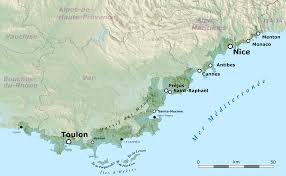
Map of the Côte d’Azur
The Côte d’Azur, due to a favourable microclimate well sheltered from the cold air that comes down from the north and long dry summers has many unique and interesting native plants. Due to its microclimate, many collections of exotic and tropical plants were established in the area. There are numerous experiments where non-endemic plants have been introduced and mixed with, or have replaced, the local flora, creating some of the most important Acclimatisation Gardens of the Mediterranean area.
Today, the conservation and collection of those species serve as a good indicator of how rapidly the climate is warming, as it has been observed that many plants are now able to survive the winter without protection and are integrated as part of the Mediterranean flora, with the climate now being more like the North Africa climate every year. Due to this many of the native plants in the area have been removed or replaced for their more exotic counterparts which puts them at risk. With a changing climate also here in the UK, especially in the south west, becoming more like a Mediterranean climate every year through not only heat but with receiving less rainfall. Could we achieve the same experiments with non-endemic plants from the Mediterranean and mixed with our local flora to ensure the survival of our horticultural importance in the area?
Objectives
To expand knowledge of Mediterranean plants in their native habitats and incorporate into formal settings.
To study the different conditions in which the native Mediterranean plants are growing
Share knowledge and experience with fellow horticulturists
Climate and overall soil profile of the Côte d’Azur
Because of the southern latitude and the proximity of the warm sea the Mediterranean has mild winters, with an average temperature of 47 °F (8 °C) in January and with only a few days of frost. However, the precipitation is heavy because of the Alps behind and rain tends to fall in sudden downpours, especially in the autumn and spring, whereas summer is completely dry for at least three months. It is a unique area because of its clear skies and the regularity of fine weather, and you often find permanent irrigation systems are characteristic of the Mediterranean lowlands.
The main soil profile of the Côte d’Azur is developed from decalcified clays with a coarse sand admixture (mostly loam) and are typically red in colour because of the upward migration of iron oxides during the warm, dry summers.
Saturday 7 October
I arrived in Nice to be greeted by the famous clear, blue sky and warm weather and took a short train ride out of Nice to Beaulieu-sur-Mer, my base for the first two nights. In Beaulieu-sur-Mer I was greeted by amazing views of the mountains rolling down into the sea.
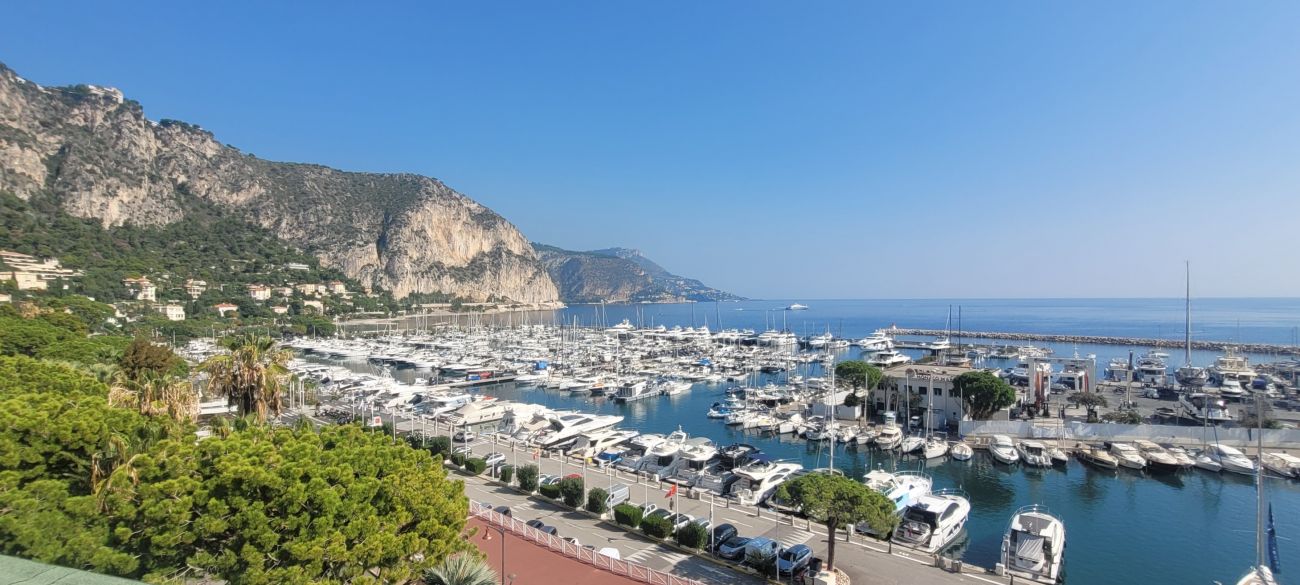
View of Beaulieu-sur-Mer from the hotel roof
On the walk from the train station to the hotel I saw several plants native to the Mediterranean area planted in the street. These included Nerium oleander, Pinus pinea and many Olea europaea, which have been pollarded. On further research that night in the hotel I found that the presence of the olive tree is significant to the people of the area as it is deeply attached with the life and development of Beaulieu-sur-Mer and is even featured on the city coat of arms.
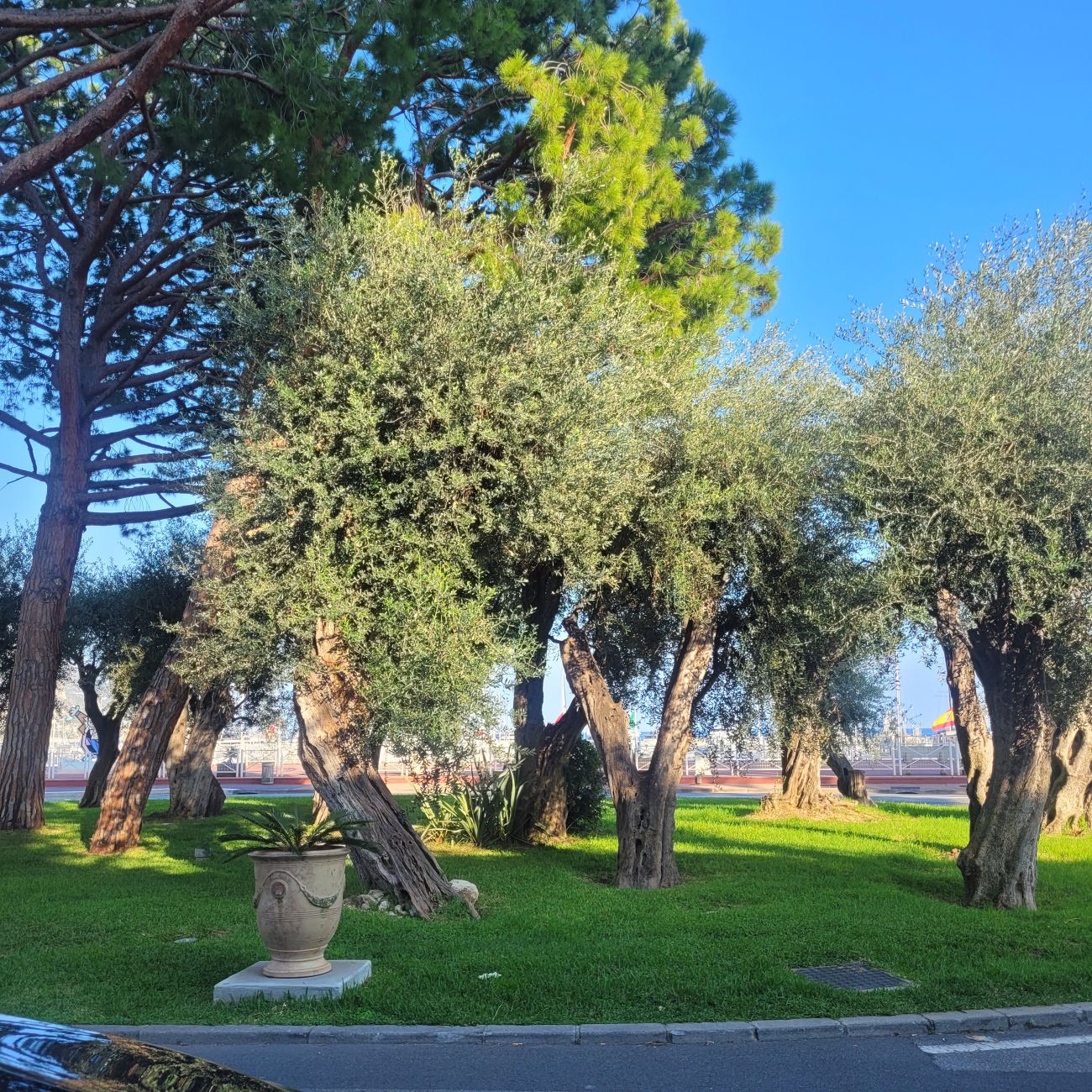
Pollarded Olea europaea
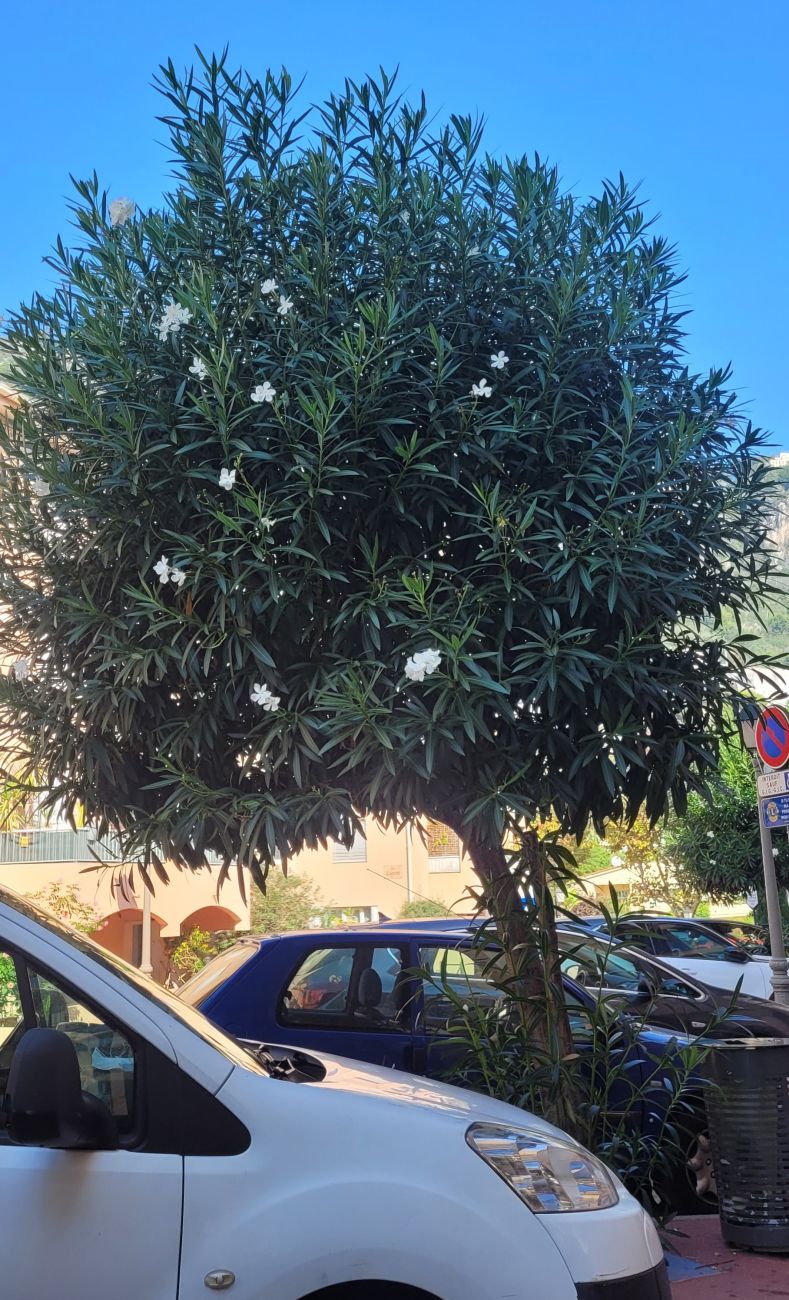
Nerium oleander
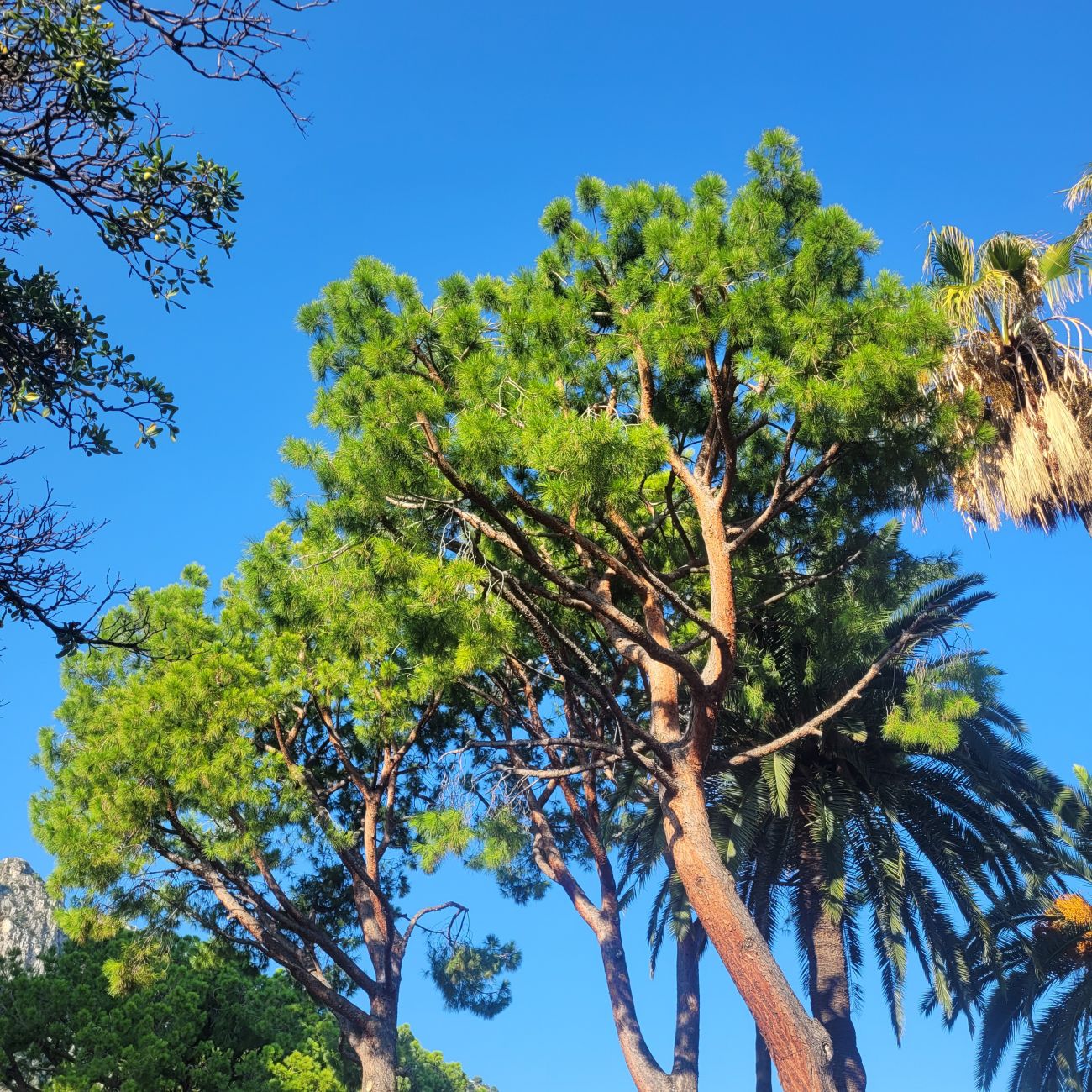
Pinus pinea
Sunday 8 October
After breakfast I started off walking to visit Villa Ephrussi de Rothschild, walking along the side of the Saint Jean Cap Ferrat peninsula which was beautiful.
Villa Ephrussi de Rothschild
The Villa Ephrussi de Rothschild was built by Baroness Beatrice Ephrussi de Rothschild in 1912.
The first thing I noticed when arriving was the sheer scale of the villa. Walking up the hill to it you certainly got the impression of wealth and power. The main section of the garden, the French Formal Garden, was the first garden to be created when the Baroness moved into the villa in 1912. Béatrice designed this main garden in the shape of ship’s deck, decorated with waterfalls and ponds, with the Temple of Love at the bow. As she could see the sea on either side, she could imagine being on board the steamship “Ile de France,” which is the name she gave to the Villa in memory of an unforgettable voyage she had taken. From the loggia, Béatrice could survey her team of 30 gardeners, all wearing berets with a red pompom! Trees such as a 100-year-old Olea eurpaea, Cupressus macrocarpa hedges and Pinus halepensis have been given pride of place in the French formal garden. It wasn’t until after the Baroness has died in 1934 that the other themed gardens were created by Louis Marchand.
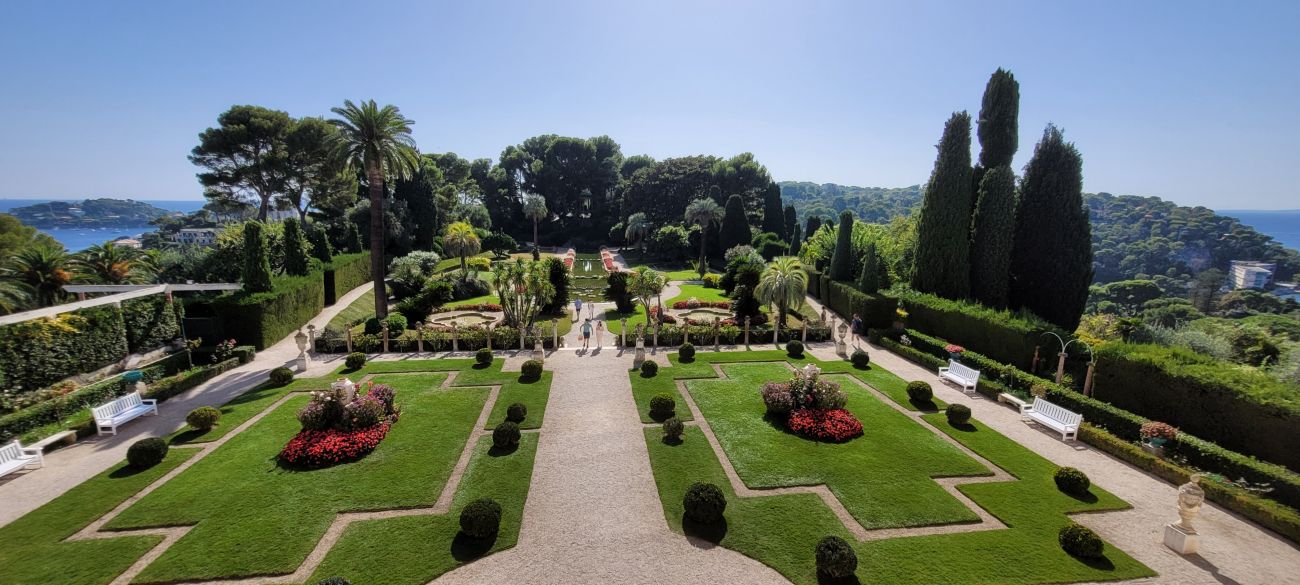
French formal garden view from the villa.
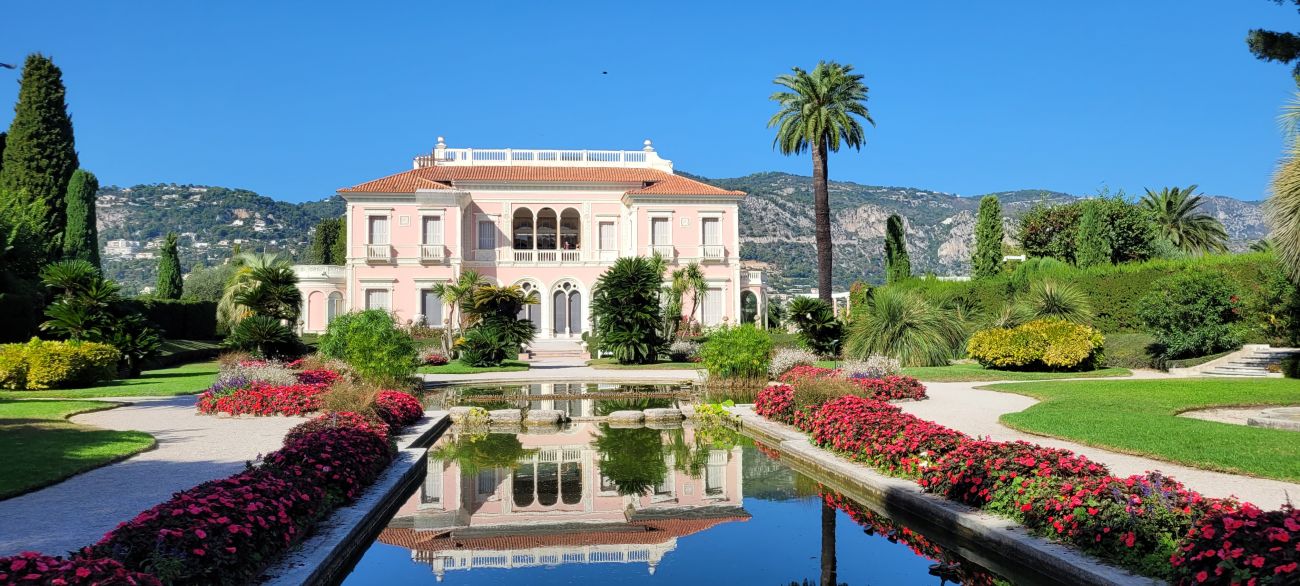
Villa Ephrussi de Rothschild
The main section of the garden which I chose to focus on, was the Provençal Garden. Here I found many Phillyrea angustifolia used both as standalone plants and as a formal hedging as well as lots of Olea europaea, Pinus pinea, Lavandula oentata and topiary Salvia rosmarinus forming the main structures of the garden. I was fascinated by the topiary Salvia rosmarinus as I had never considered it in the form before but loved the idea and how compact it looked.
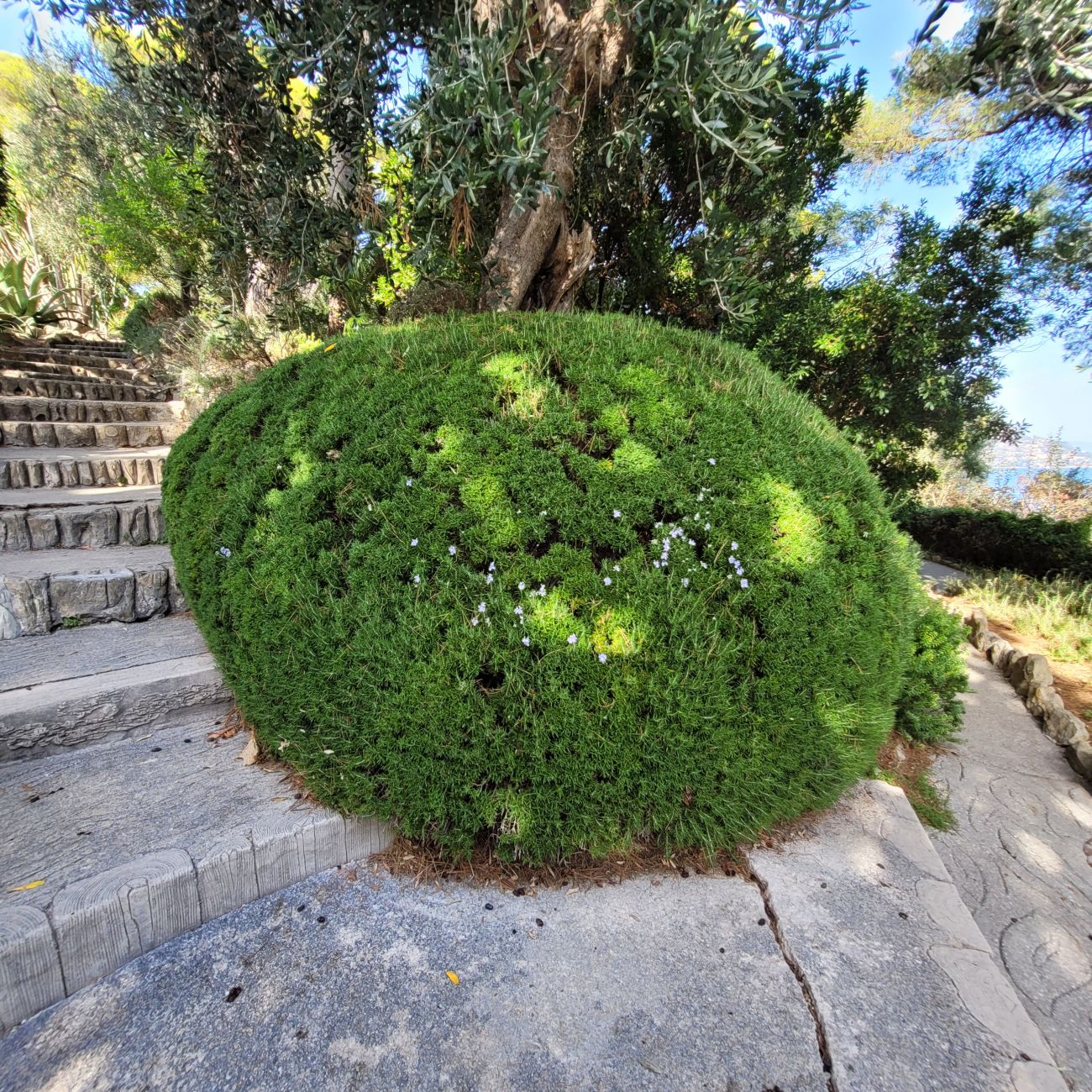
Topiary Salvia rosmarinus
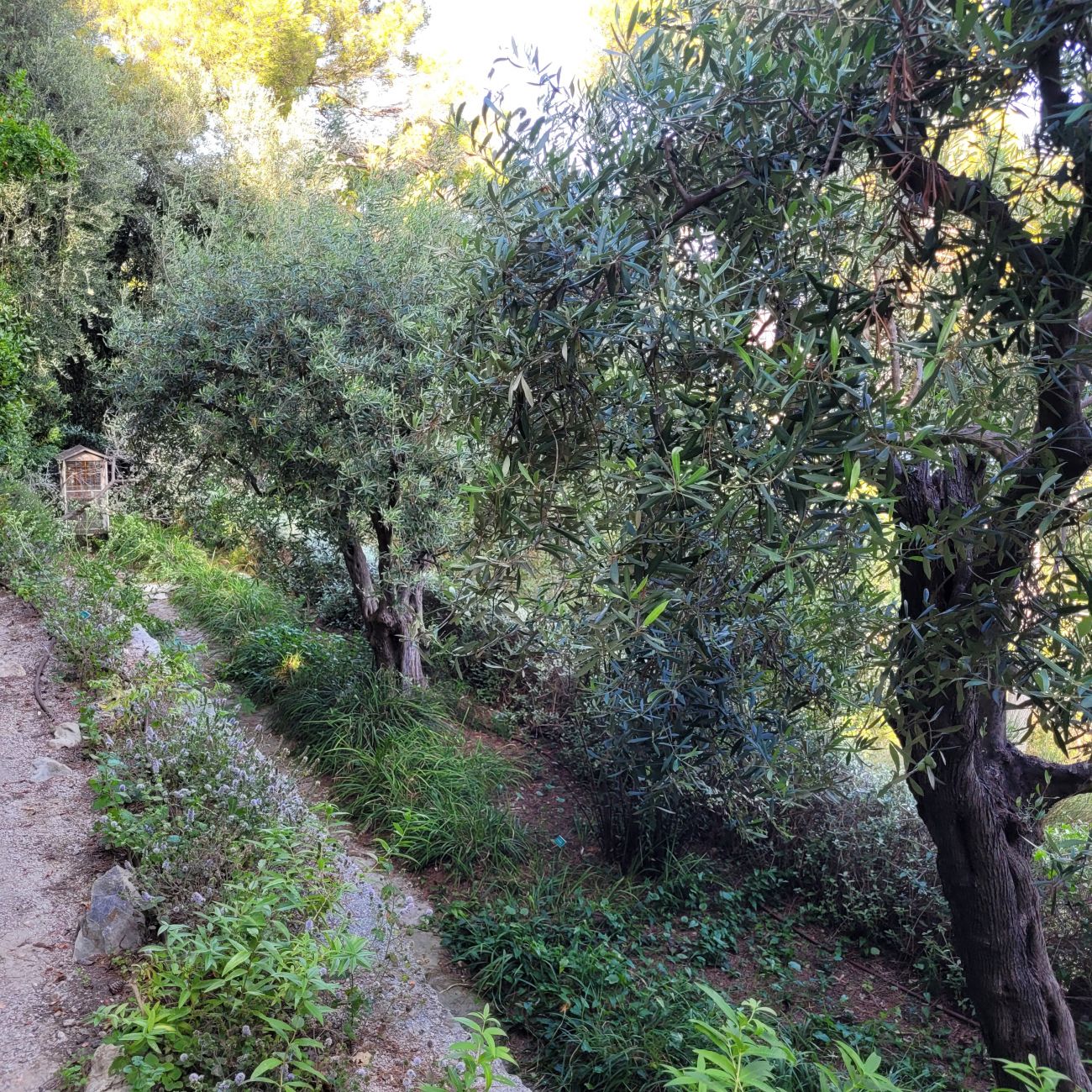
Lines of Olea europaea in the provincial garden
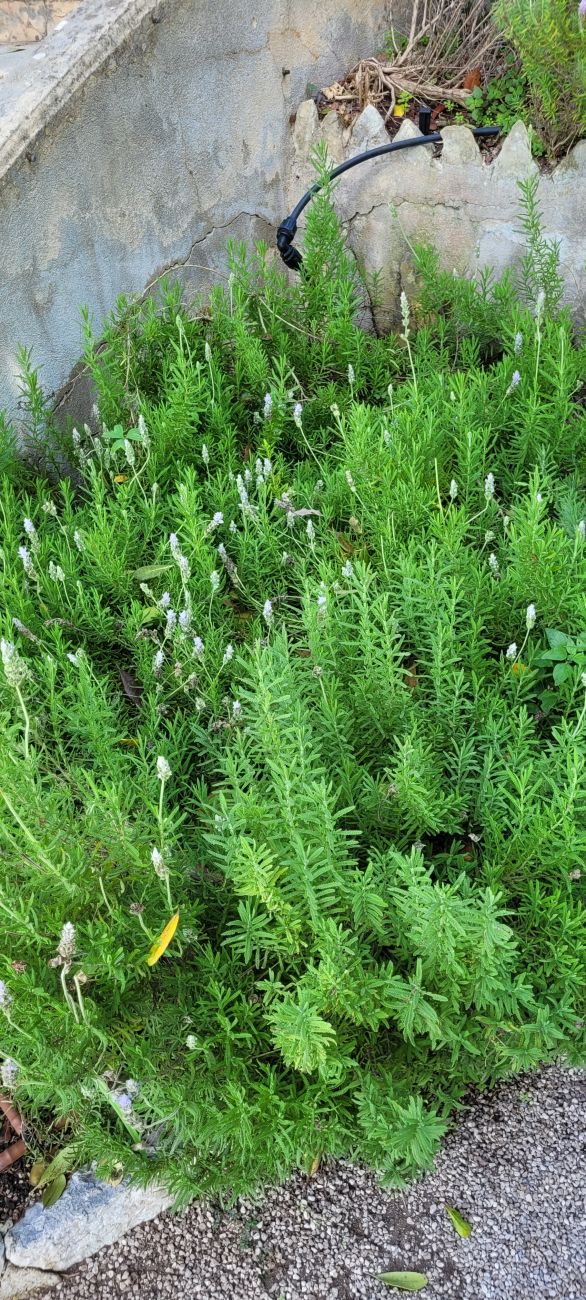
Lavandula oentata with an irrigation system.
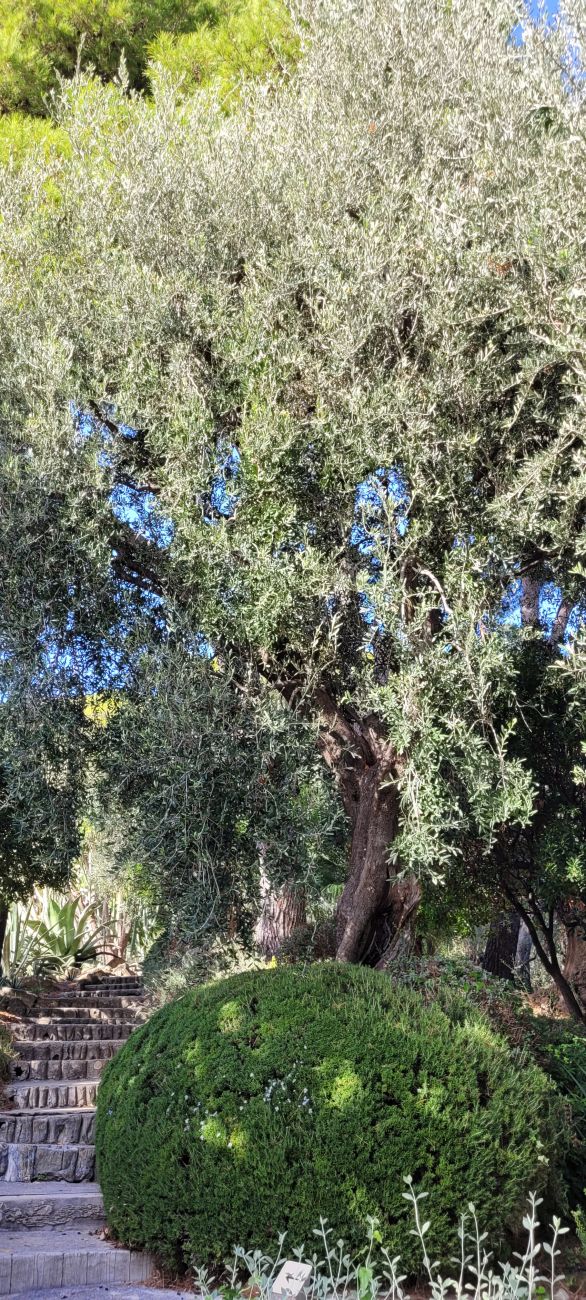
Olea europaea and a topiary Salvia rosmarinus
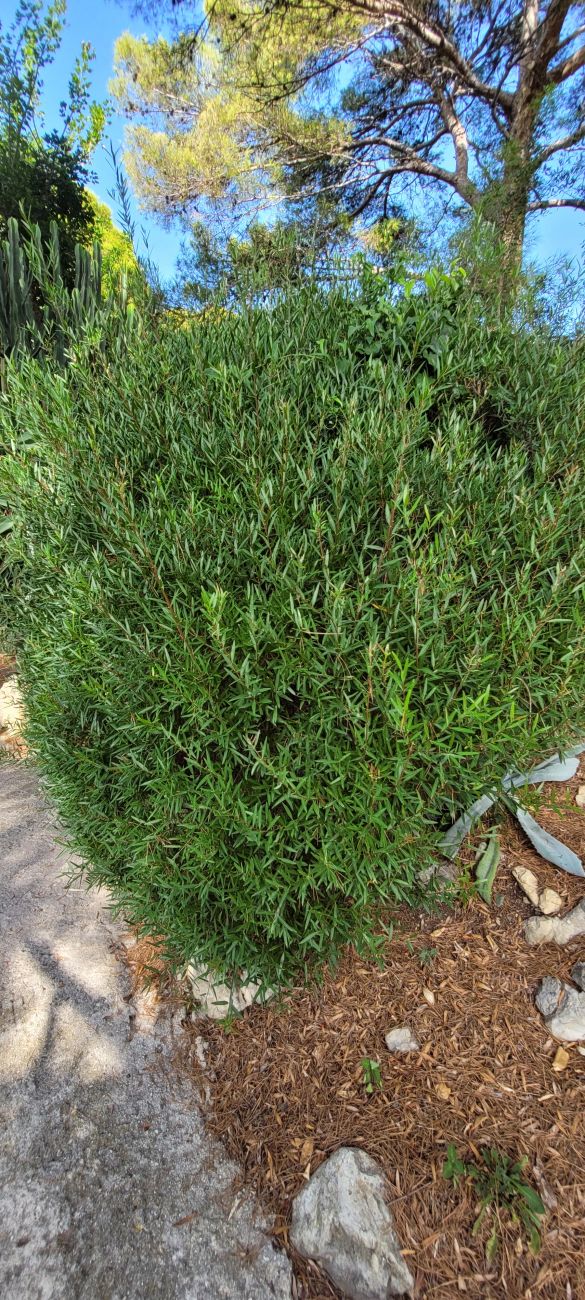
Phillyrea angustifolia
Soil type – Within the gardens I found that the soil is mostly made up of loam with a mulching layer of stones or bark to keep in moisture
Irrigation – Non man-made and man-made means – Precipitation, drip irrigation systems, hoses, and sprinklers.
Monday 9 October
On Monday I travelled from Beaulieu-sur-Mer to Monaco which would be my base for the next four days. Arriving in Monaco is a surreal experience as everywhere you look there are designer brands or expensive sports cars.
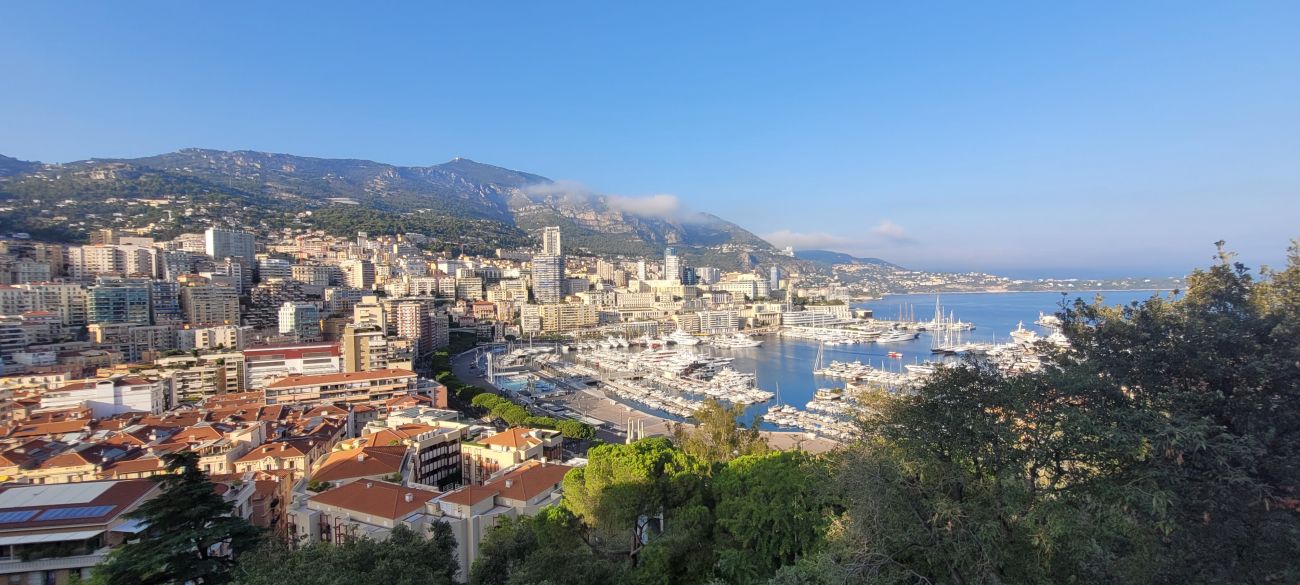
View of Monaco from Le Rocher
Jardin Saint-Martin
For my first day in Monaco, it only seemed fitting to start with Jardin Saint-Martin, the first public garden opened in the principality in 1816. It was built on an abandoned plot of land to provide work for the inhabitants, when famine struck. Originally, the Saint-Martin Gardens contained typical Mediterranean forest such as; Olea europaea, Pinus pinea, Pinus halepensis ‘Mill’ Quercus ilex, Myrtus communis and Pistacia vera, some of which can still be seen, however, most of them have been supplemented by exotic species that have been acclimatized to the garden. Steep winding paths built on the side of ‘Monaco rock’ offer amazing views of Fontvieille from the garden.
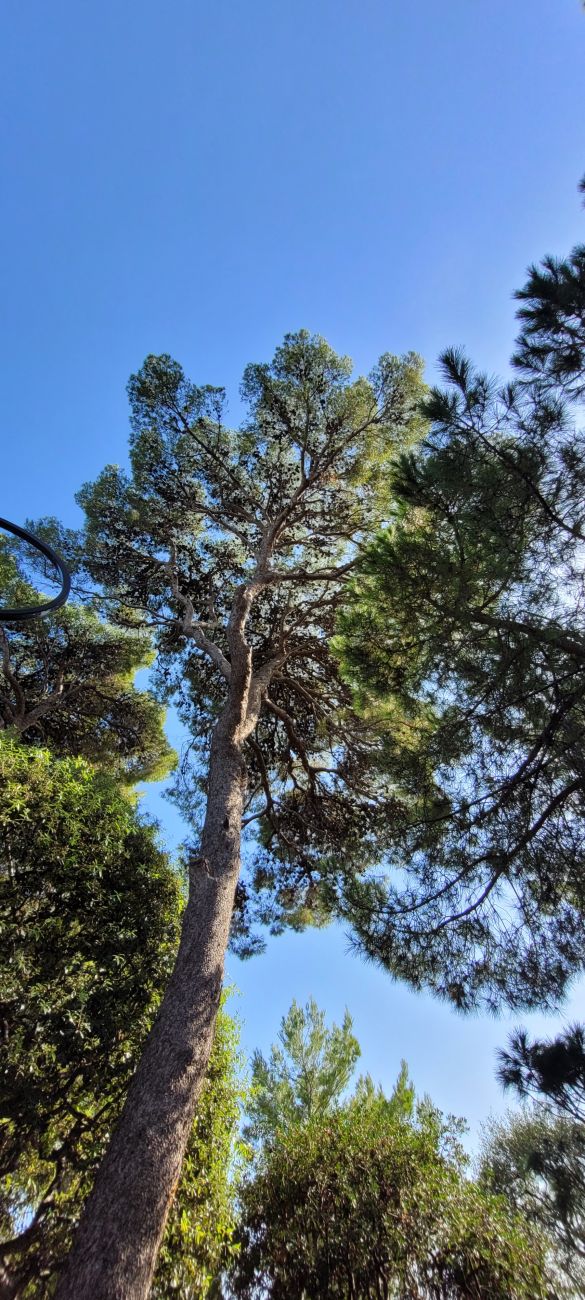
Pinus halepensis Mill.
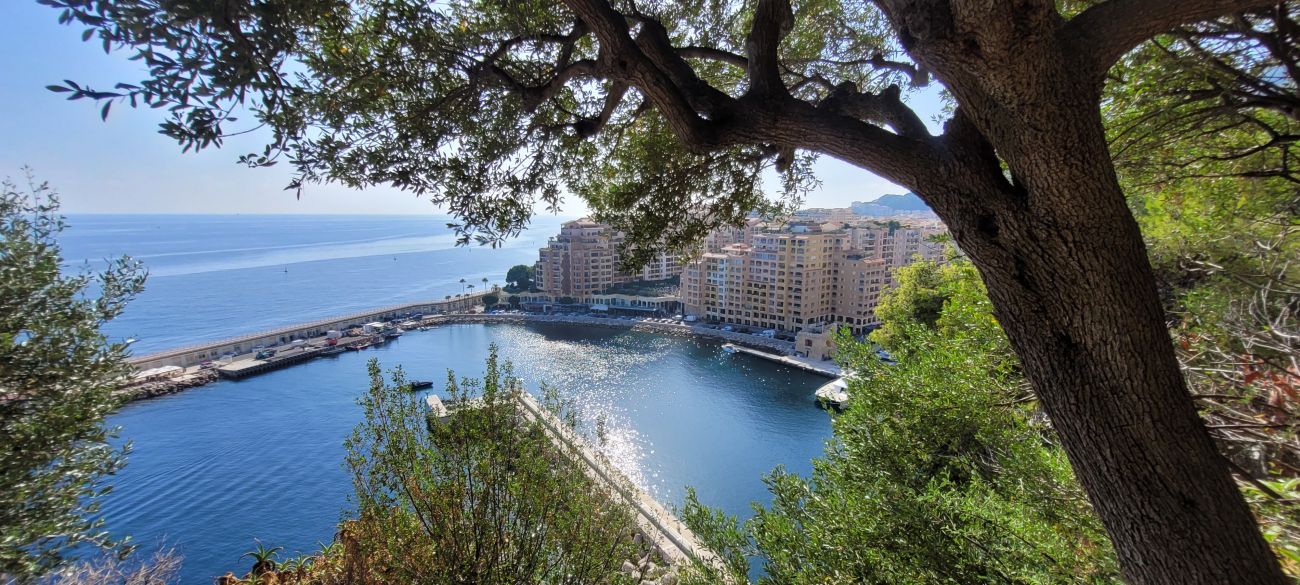
View of Fontvieille from Jardin Saint-Martin
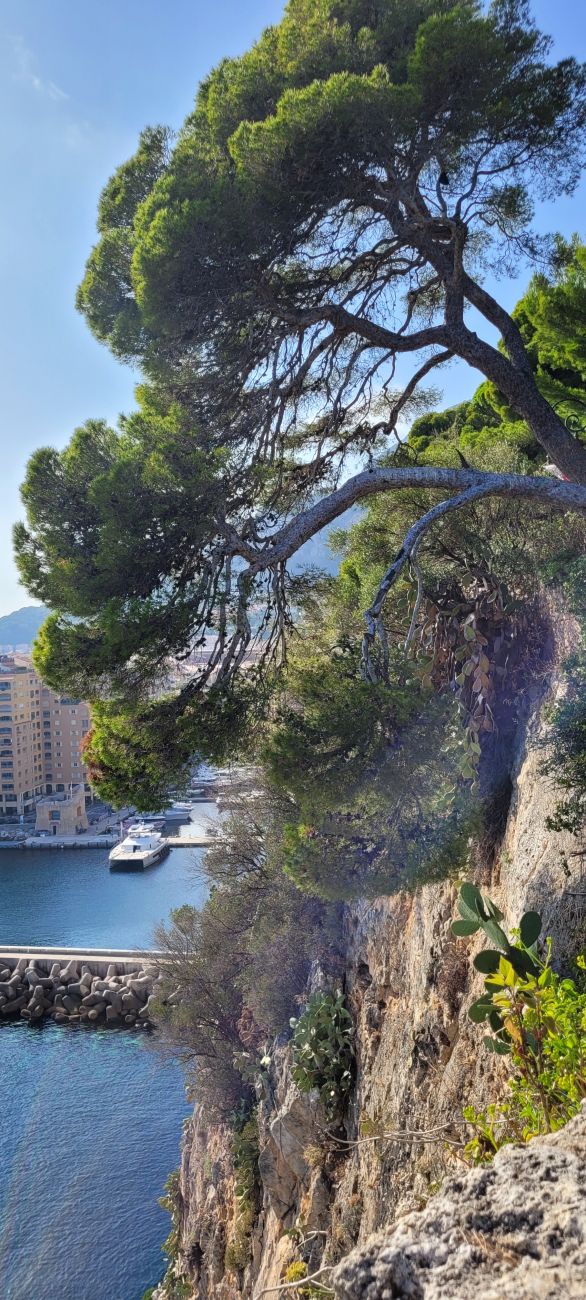
Pinus pinea, hanging over the rock face.
The most interesting plant in Jardin Saint-Martin was Ceratonia silique, known as carrubé in Monegasque can be found in several locations across Monaco, including on the esplanade of the Oceanographic Museum, in the Saint Martin gardens and in the gardens of the Sainte-Devoté church. Because of this in 1995 it was made the national tree of the Principality of Monaco. The seeds of the Ceratonia siliqua were used as small weights by ancient cultures of the Mediterranean region, giving rise to the word carat.
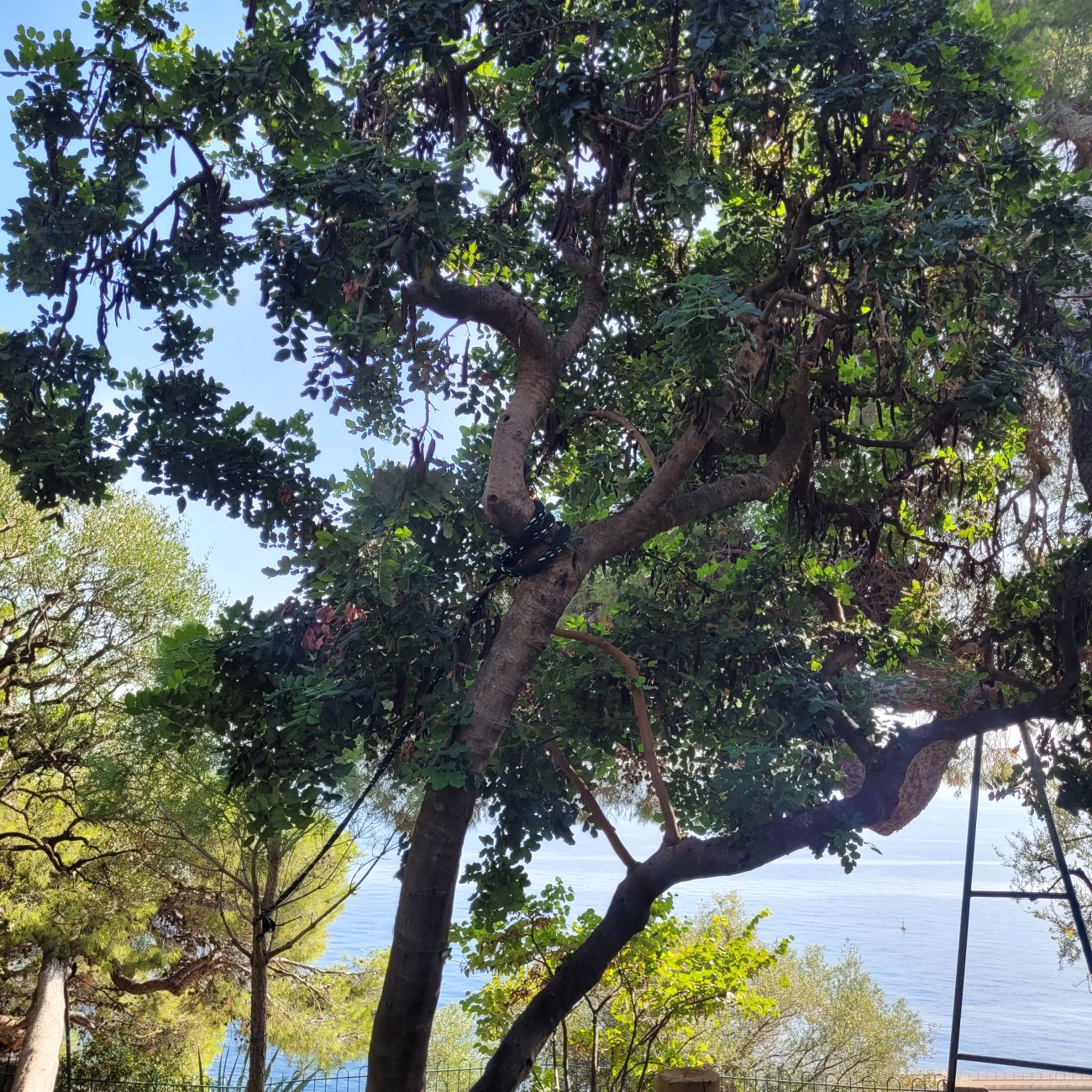
Ceratonia siliqua
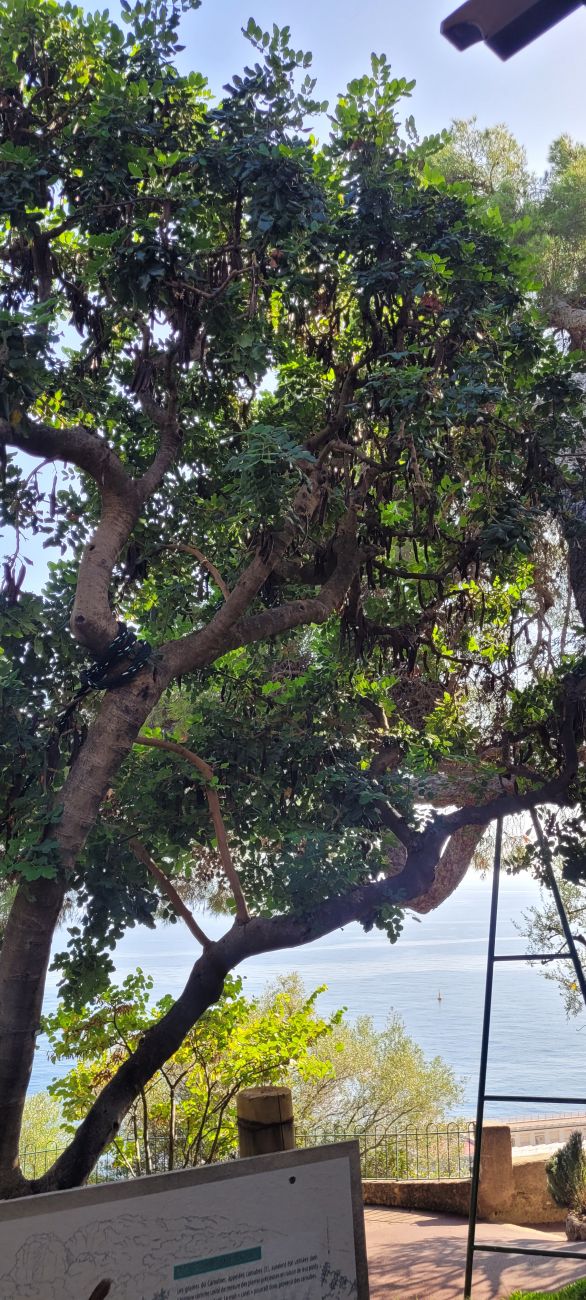
Ceratonia siliqua
Soil type – Within the Jardin Saint-Martin I found that the soil was mostly made up of a mixture of clay, loam and some limestone rock with a mulching layer of stones or bark to keep in moisture
Irrigation – Non man-made and man-made means – Precipitation, drip irrigation systems and hoses. Although most of these are minimal due to the exotic nature of most of the plant species chosen in the gardens.
Tuesday 10 October
The second day in Monaco was spent visiting Centre Botanique du Jardin Exotique and Parc Princesse Antoinette. My initial plan was to visit the exotic garden there but unfortunately this was shut for maintenance until 2024.
Centre Botanique Monaco
The Exotic Garden of Monaco was first opened to the public in 1933 after Prince Albert I decided to start a dedicated cactus collection in the principality. Built on the cliff side of the exotic garden, it offers breath-taking views and invites people to discover the vast collection of succulents and cacti collected on expeditions that the prince undertook in the 1960s, grown from seed or donated. Most of the garden’s collection comes from distant and dry locations such as the south-west USA, Mexico, Central and South America, which also included the cactus and agaves; southern Africa and the Arabian peninsula for the other succulents. The Centre Botanique sits on the hillside just above the garden and as well as having its own covered collection in glasshouses, focuses on the propagation and preservation of the varied species of cacti and Agave. I was lucky enough to get a tour behind the scenes to the nursery and propagation area to see propagation, seed collection and grafting.
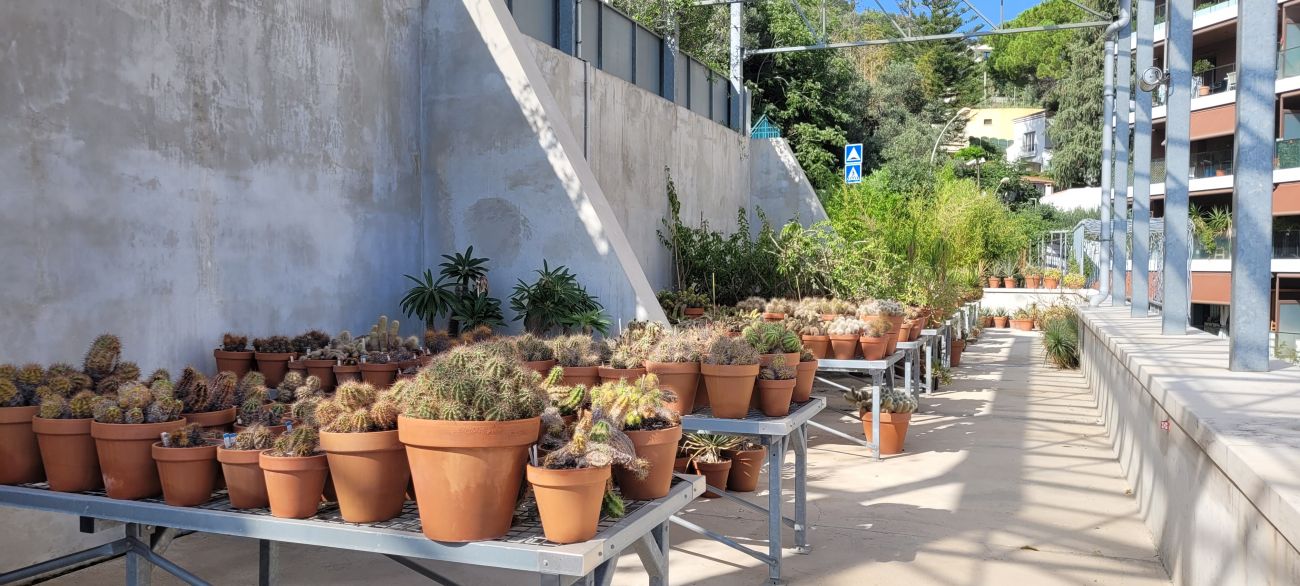
Nursery area of the Centre Botanique
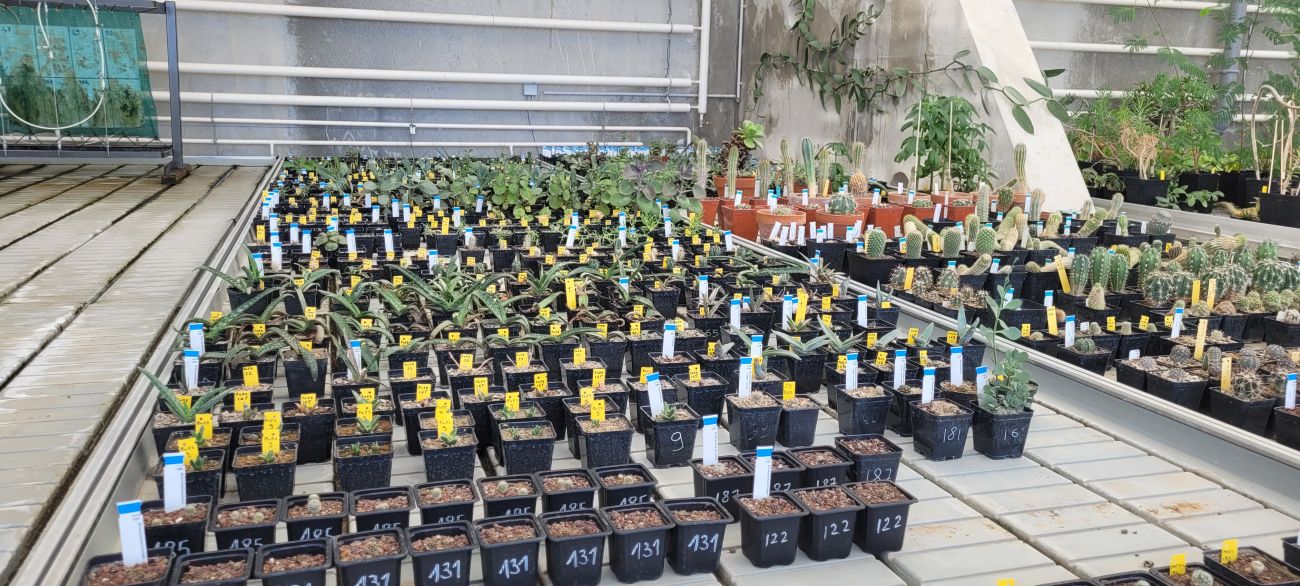
Seedling plants in the Nursery

The Mexico glasshouse
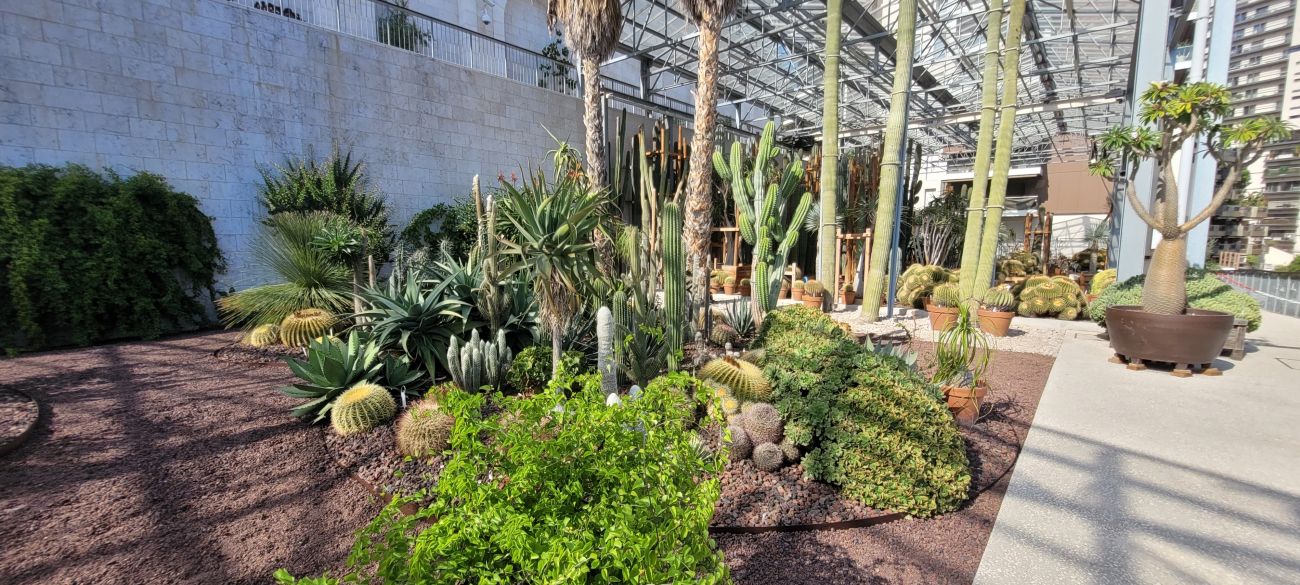
Outside Africa area of the Centre
Soil type – When the team first arrived at the Centre Botanique of Monaco they found many plants were dying as the soil was too rich. They had to degrade the soil using gravel and sand. Most of the site is now gravel and sand, apart from the euphorbia section which contains “potato soil’ – a sandy loam, slightly acidic soil mix.
Irrigation – man-made means – the glasshouses are watered once a week via hosepipe which is connected to an underground tank system. The water is slightly acidic and its Ph must be adjusted to about 7. Some of the plant require no water during the non-growing period.
Parc Princesse Antoinette
The next stop, just down the street from the Centre Botanique, was the one-hectare Parc Princesse Antoinette, home to 100-year-old olive trees, which is a bizarre sight as it’s surrounded by skyscrapers. It is often called the ‘Green Lung’ as it sits at the heart of the principality and was designed mostly for children, offering activities suitable for all ages. In the garden itself, I found many old Olea europaea, huge Salvia rosmarinus which were trailing down the walls and Convolvulus cneorum.
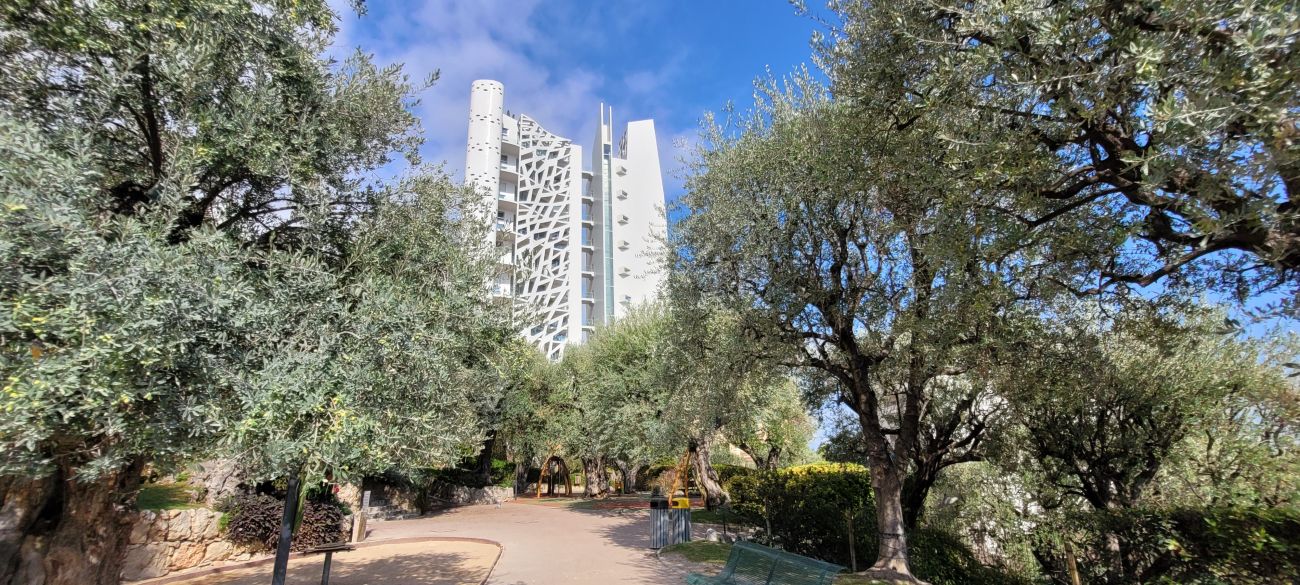
100-year-old olive trees with Le Simona Apartment block in the background.
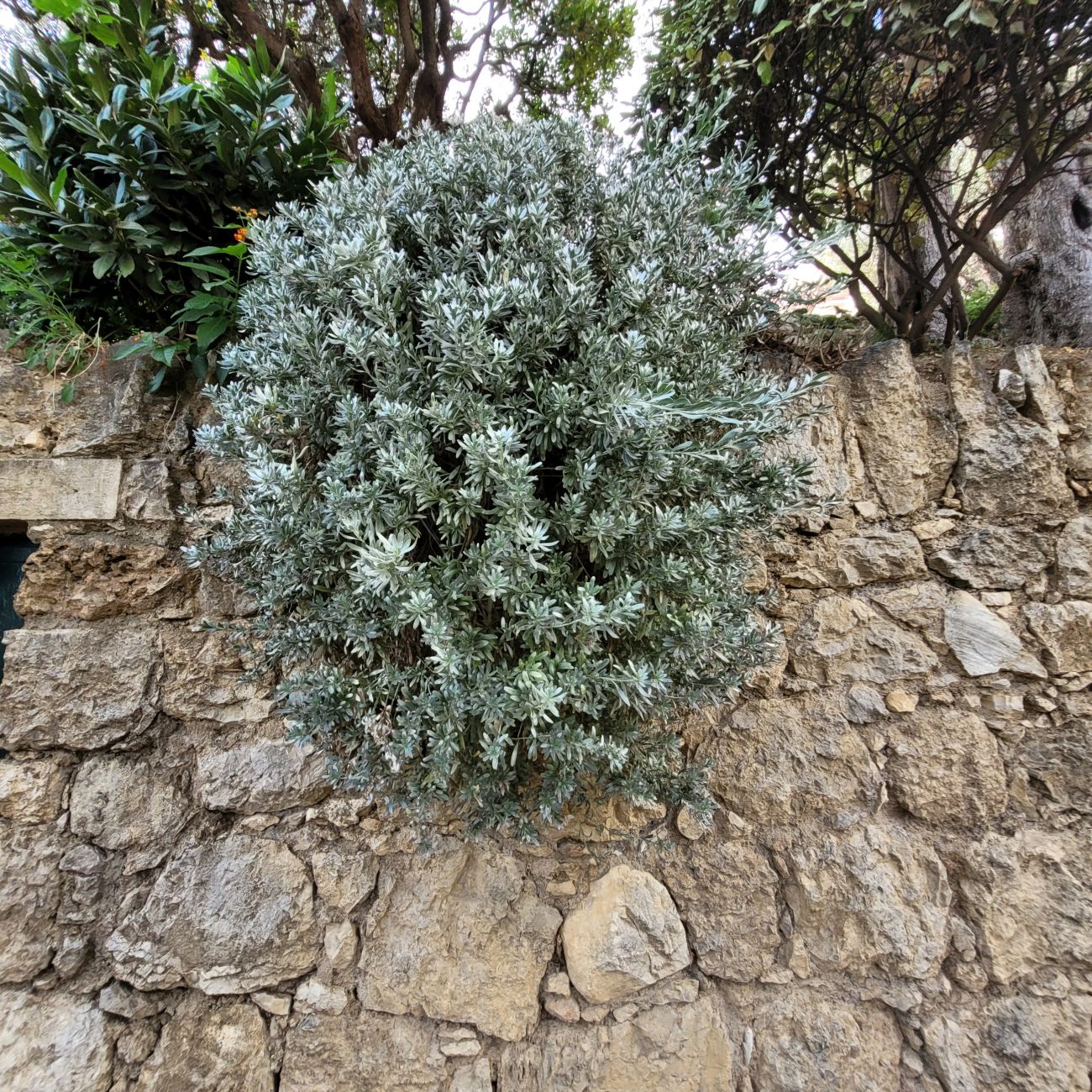
Convolvulus cneorum hanging over one of the walls in the park
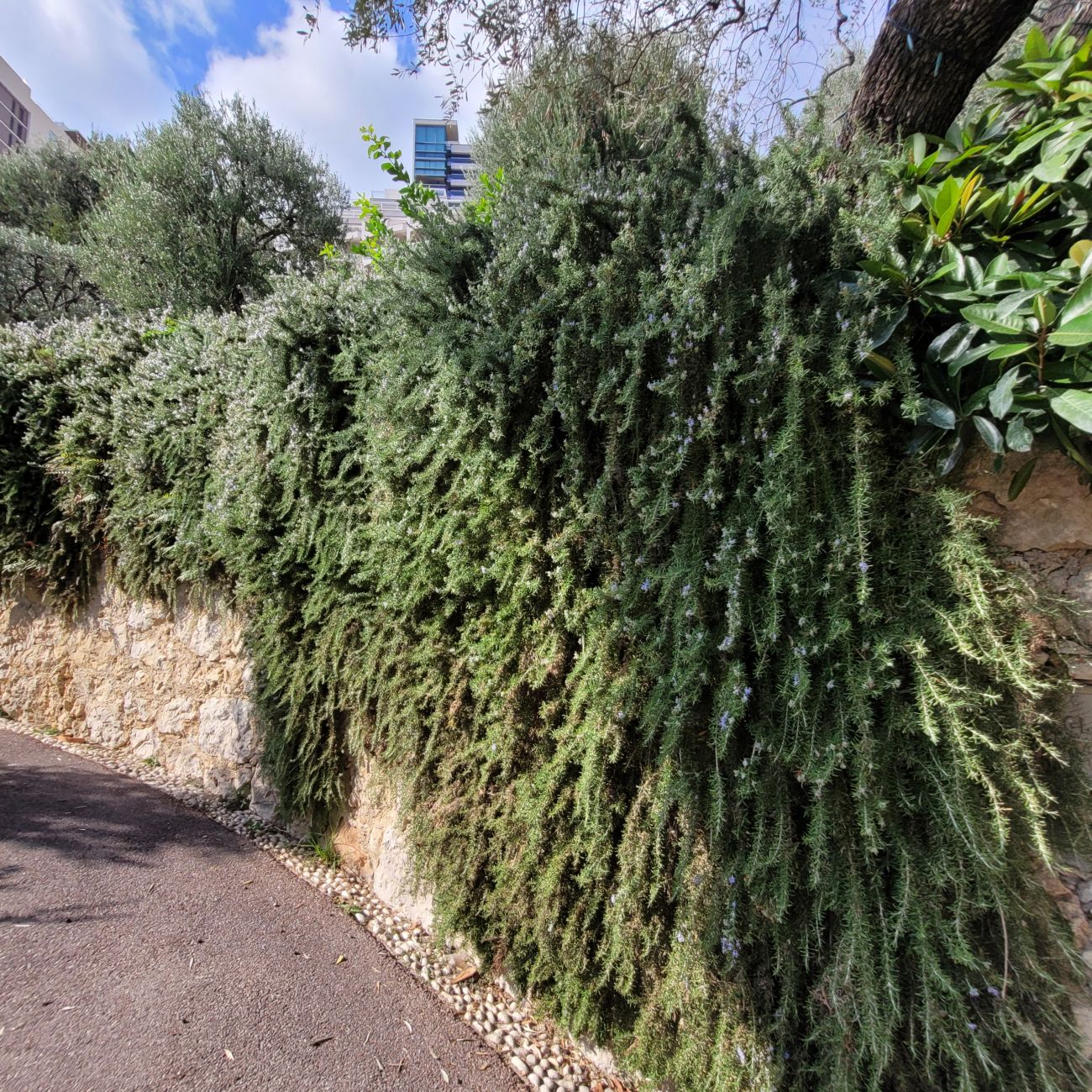
Salvia rosmarinus hanging over one of the walls
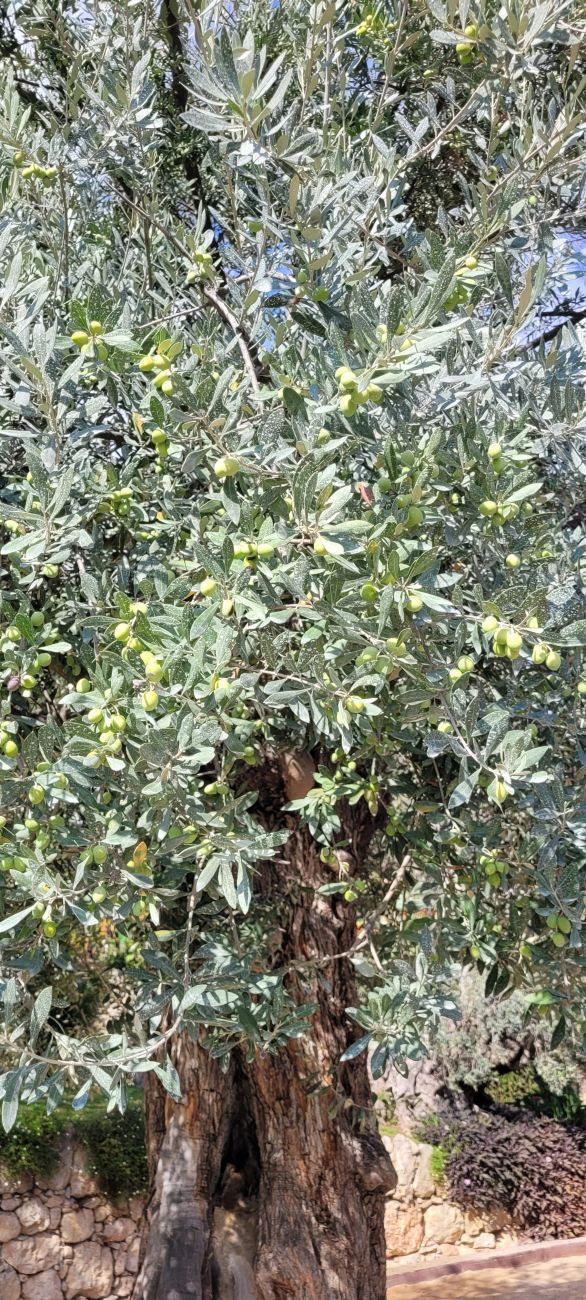
100-year-old olive
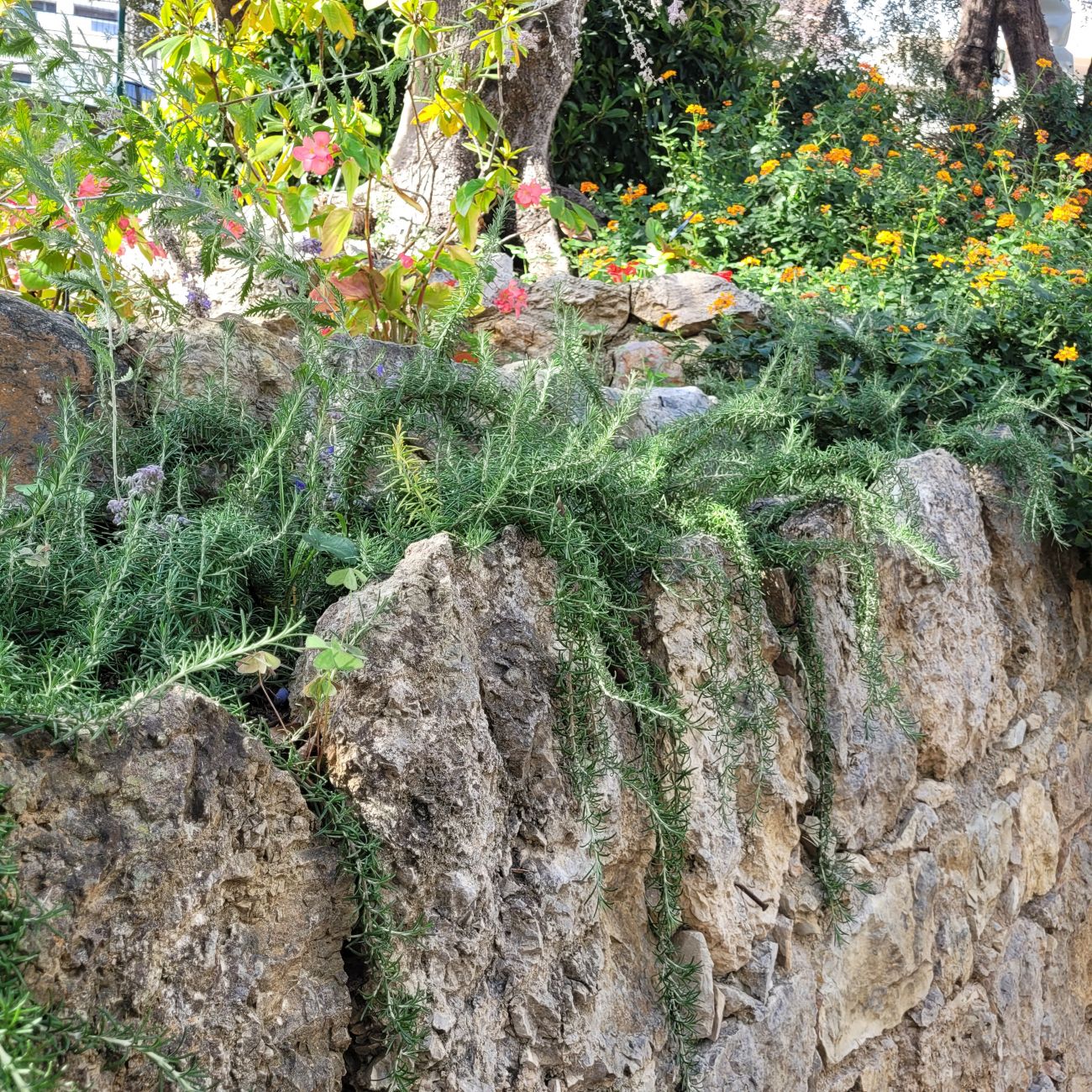
Salvia rosmarinus crawling along on top of one of the walls
Soil type – Within Parc Princesse Antoinette I found that the soil was mostly made up of a mixture of clay and loam with a mulching layer bark to keep in moisture
Irrigation – Non man-made and man-made means – Precipitation, drip irrigation systems and hoses.
Wednesday 11 October
Èze Exotic Garden
On Wednesday I took a short train ride out of the principality to Èze to visit the Exotic Garden.
After the Second World War dozens of men carried large bags of soil and plants on their backs up to the ruins of Èze village castle and its sparse remaining walls, where André Gianton, the Maire, with the help of Jean Gastaud, father of the Exotic Garden in Monaco, decided to create an exotic garden. The site is well protected from the north winds by the Revère Plateau and the declivity of the rocky outcrop ensures good drainage, perfect for planting succulents such as cactus, agave, and aloes.
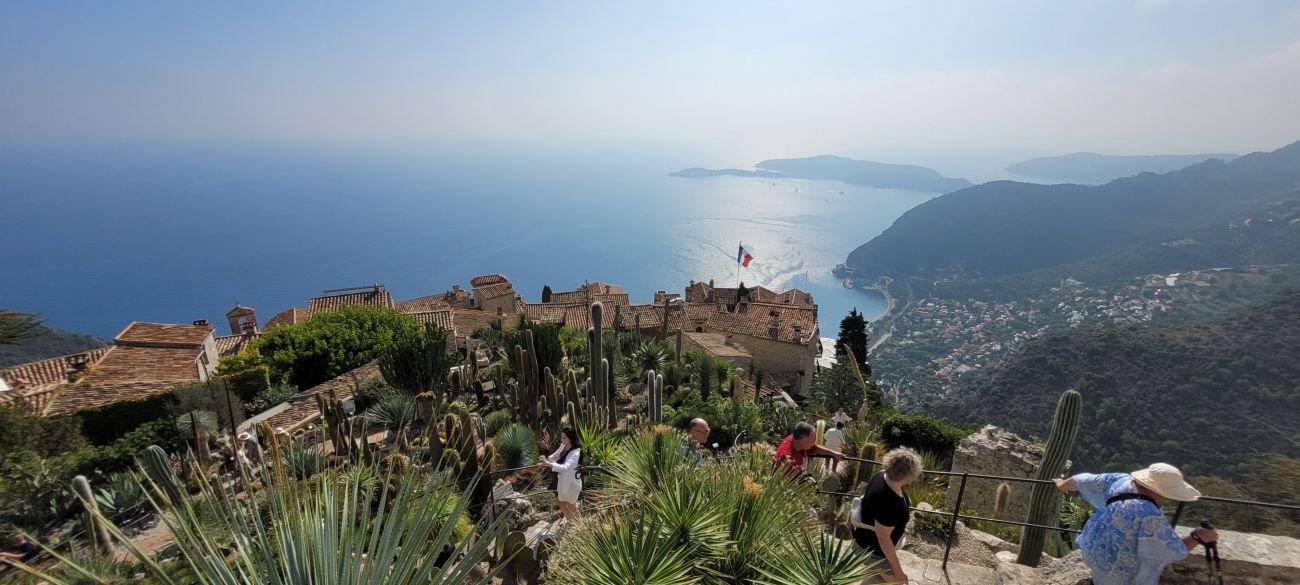
Exotic Garden Èze
Within the garden are two main areas. On the south side there are plants from desert regions whereas the shadier and wetter north side is planted with Mediterranean species. Myrtus tarentina was the first plant that I came across when I entered the north side of the garden. The leafy woody shrub along with the peeling bark that reveals a russet bark created a nice contrast to the rock face of the fortress behind. The next plant that caught my eye, was Arbutus unedo. It was covered in yellow/orange strawberry textured fruit and looked amazing. Amongst these there was also a wonderful show of Phillyrea angustifolia, Euphorbia myrsinies, Rhamnus alaternus and Myrtus communis between the rocks. I then made my way over to the south side of the garden and discovered even though it was planted with desert region plants, the upper canopy was made-up of Cedrus libani which created a wonderful contrast.
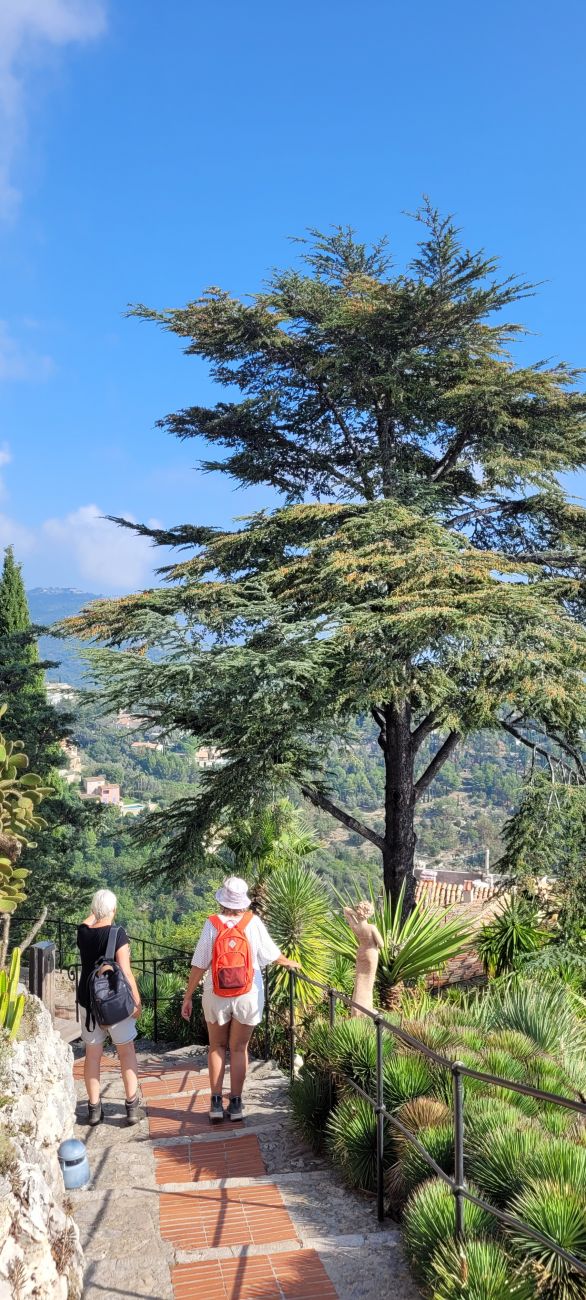
Cedrus libani
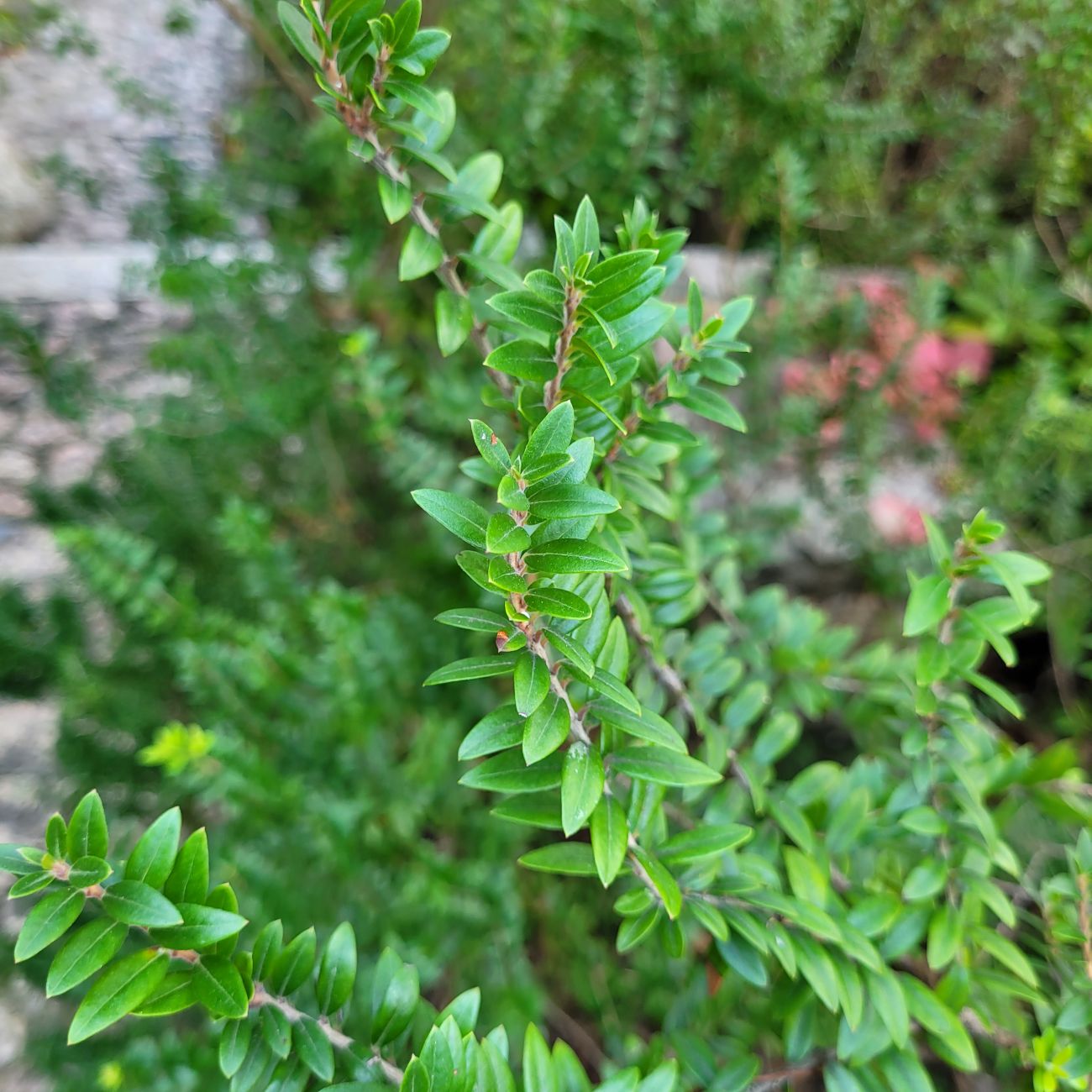
Myrtus tarentina
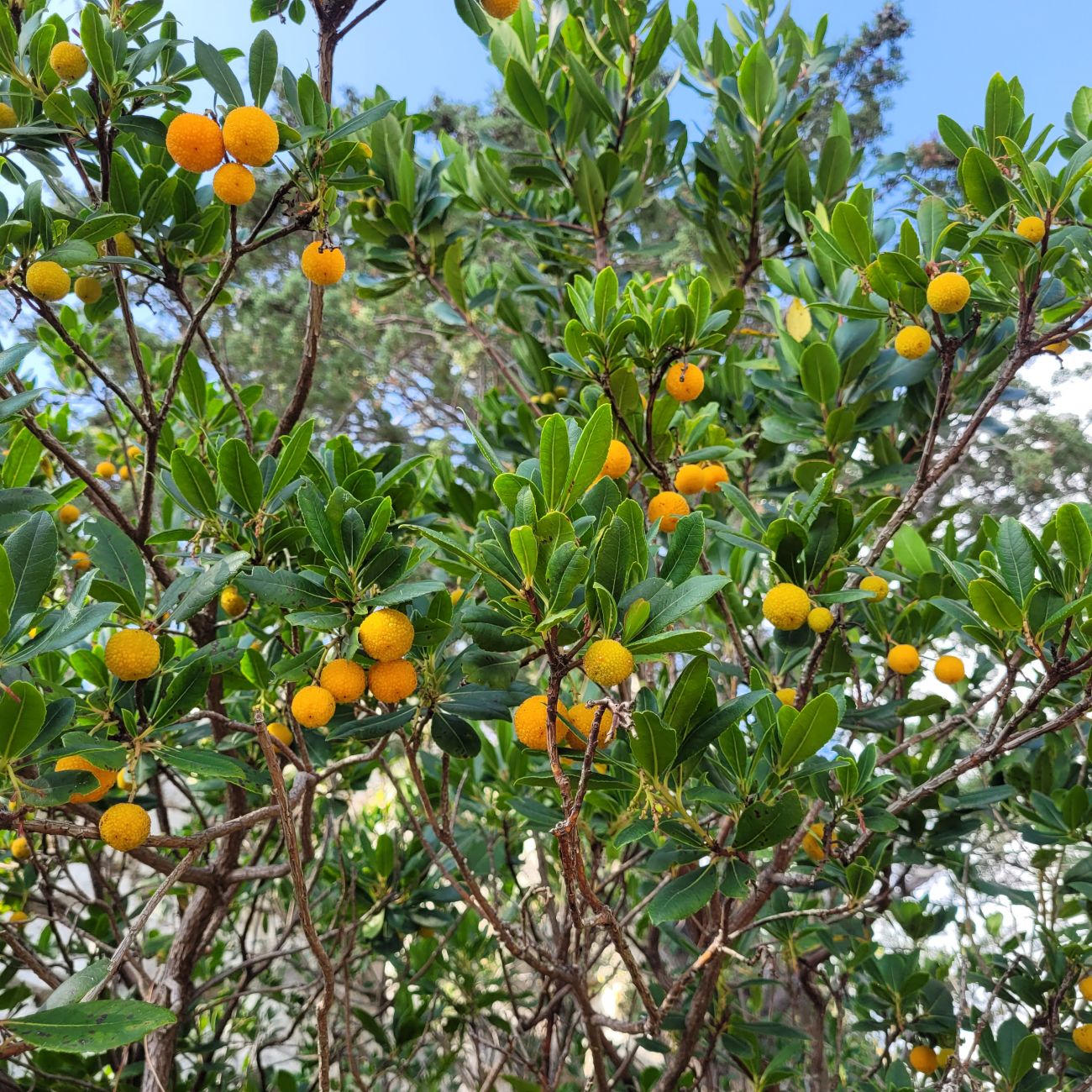
Arbutus unedo
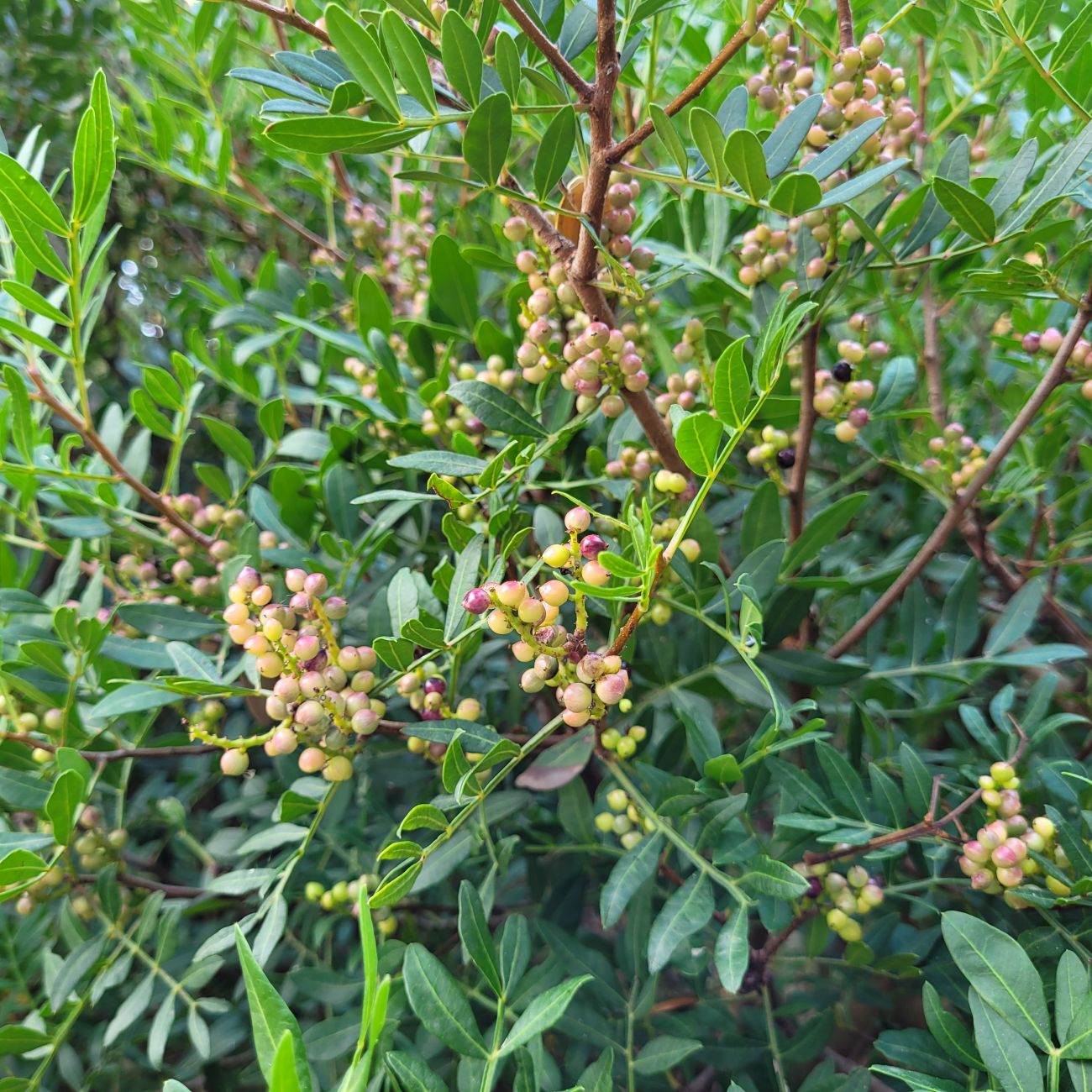
Pistacia lentiscus
Soil type – I found in the Exotic Garden Èze that it was split into many soil profiles depending on what the plants required. The soil on the north side of the garden was mostly made up of a mixture of clay and loam but parts of the south side were mostly limestone with pockets of sand and rocks or loam.
Irrigation – Non man-made and man-made means – Precipitation, drip irrigation systems, manmade water features with spray and hoses.
Thursday 12 October
La Tête de Chien
On the third day in Monaco, I woke up early and climbed La Tête de Chien to see Mediterranean plants growing in the wild. La Tête de Chien rises 550 meters above sea level and is made up of white limestone and towers over Monaco. It can be seen perfectly from anywhere in the principality, as well as from many of the places and towns nearby. On the climb up there was a thick, damp layer of fog rolling in and I almost turned back however, I continued and was incredibly lucky that it cleared to reveal a perfect view of the principality below.
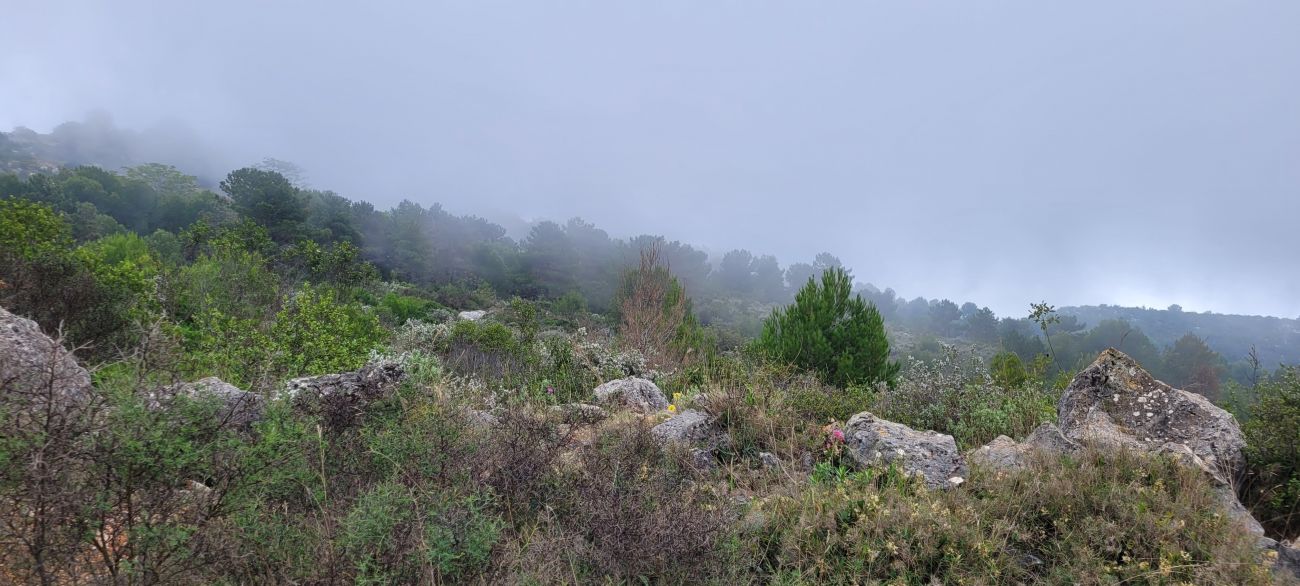
Fog on La Tête de Chien
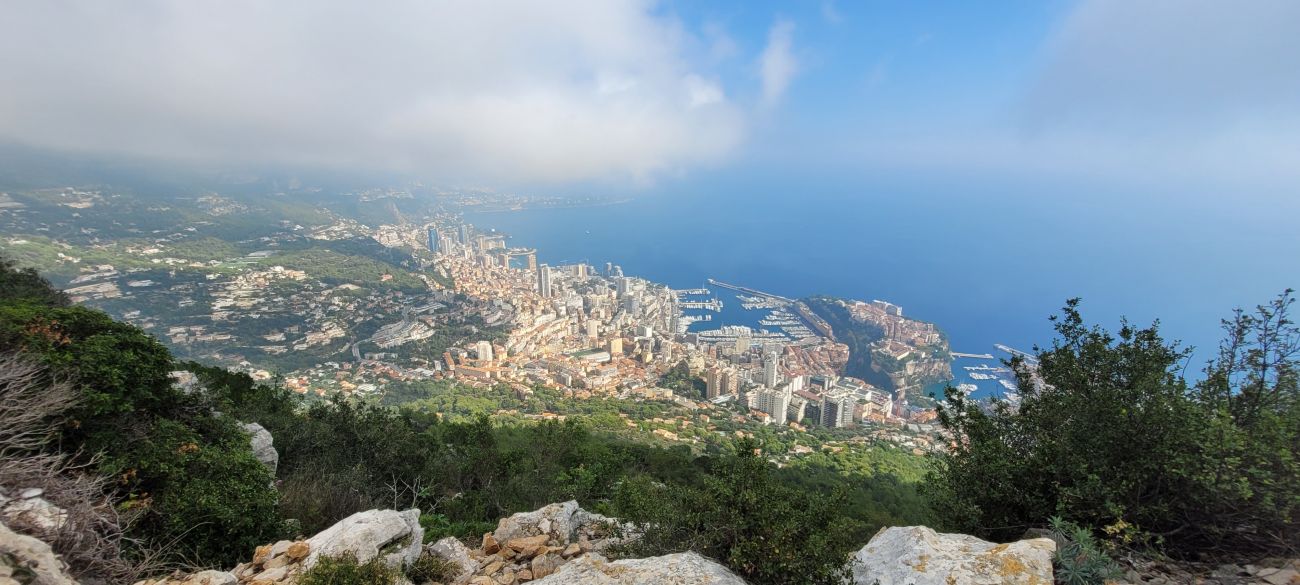
View from the top of La Tête de Chien
Both on the way up to La Tête de Chien and around the summit there was a vast diversity of Mediterranean plants to be found. The plants that I was most excited to see growing in their habitat were; Salvia rosmarinus, Foeniculum vulgare, Stachys recta and Petrosedum sediforme as I have only seen them growing in the UK within formal settings. That said, it was also amazing to see many others growing along the shale paths and in between the rocks as well.
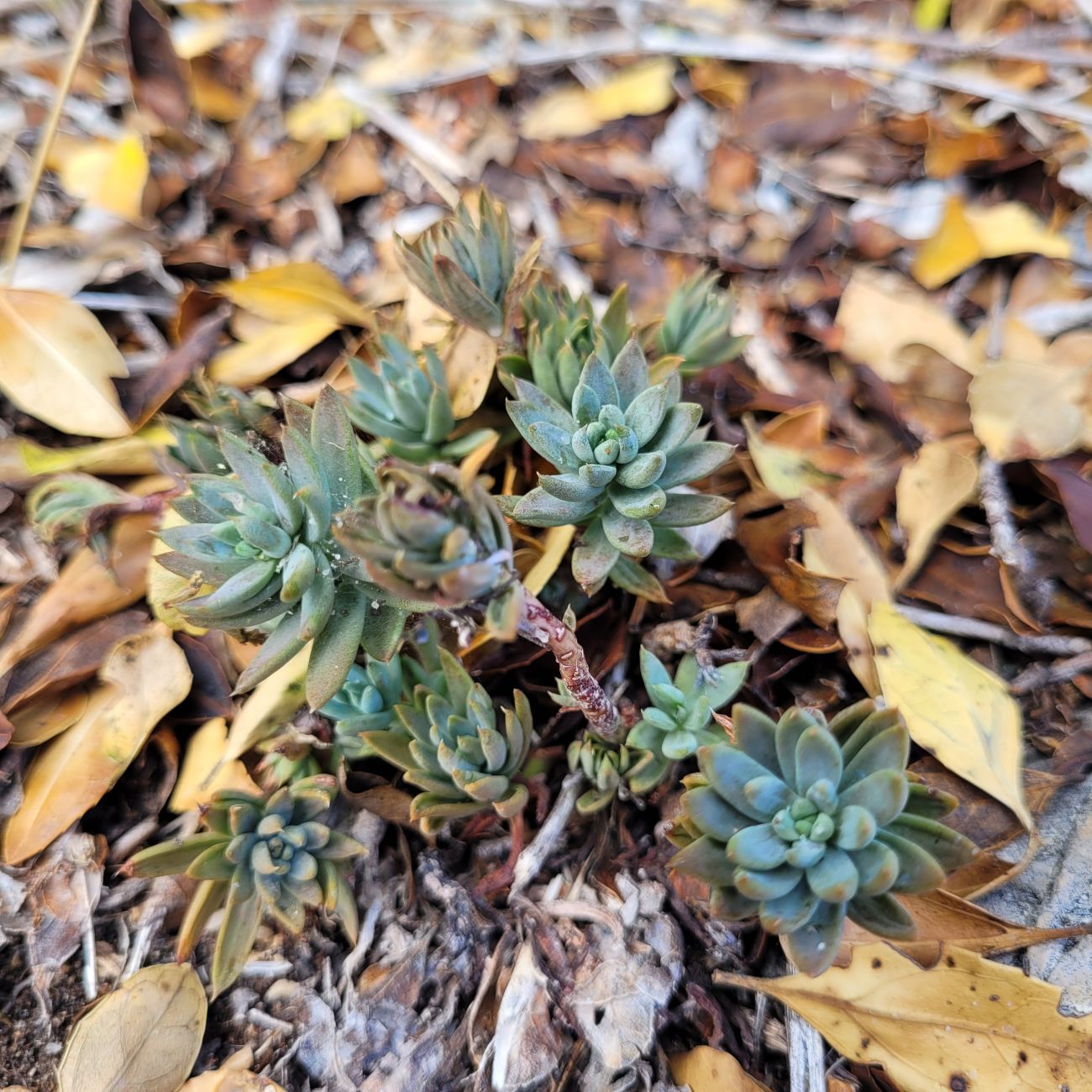
Petrosedum sediforme
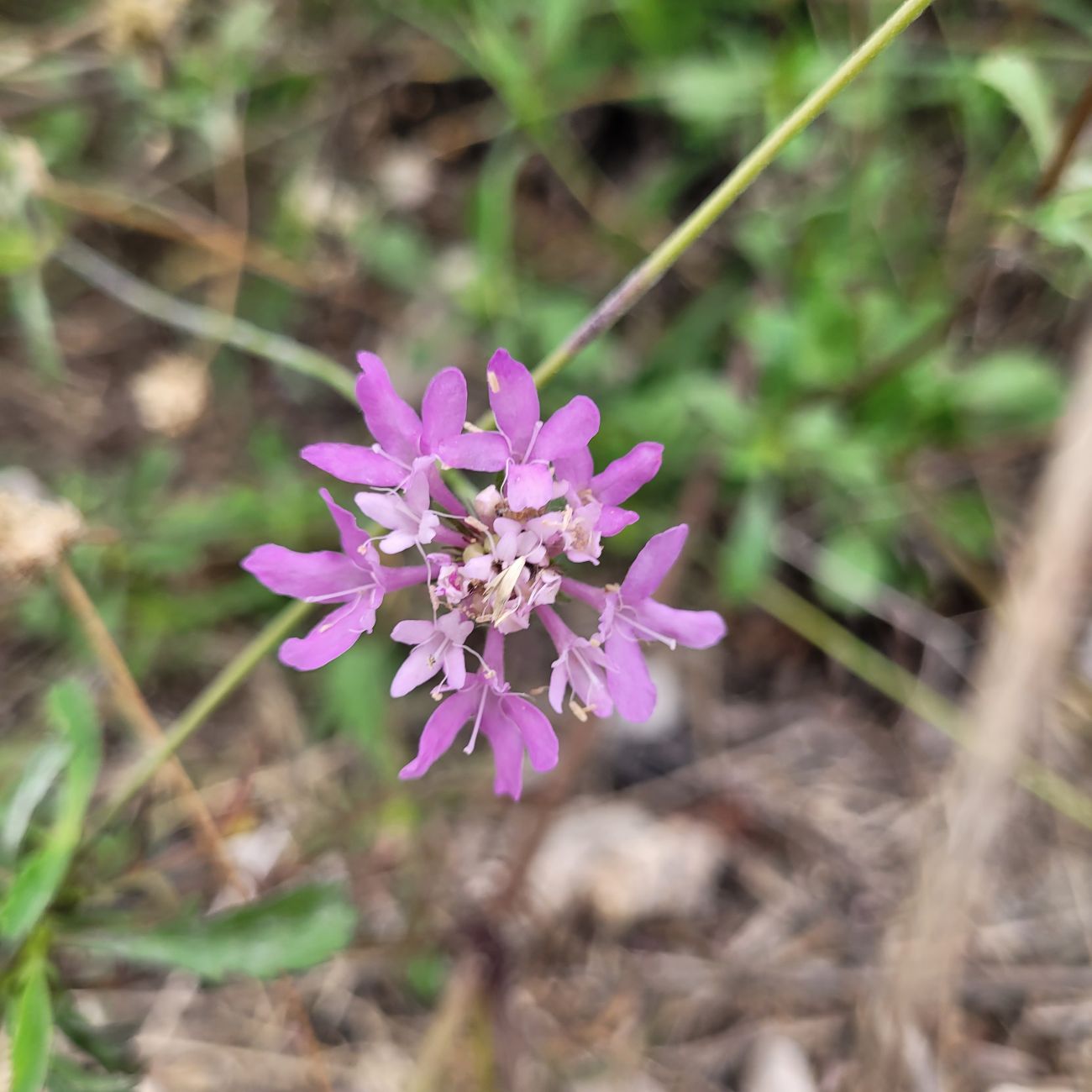
Scabiosa atropurpurea subsp. maritima
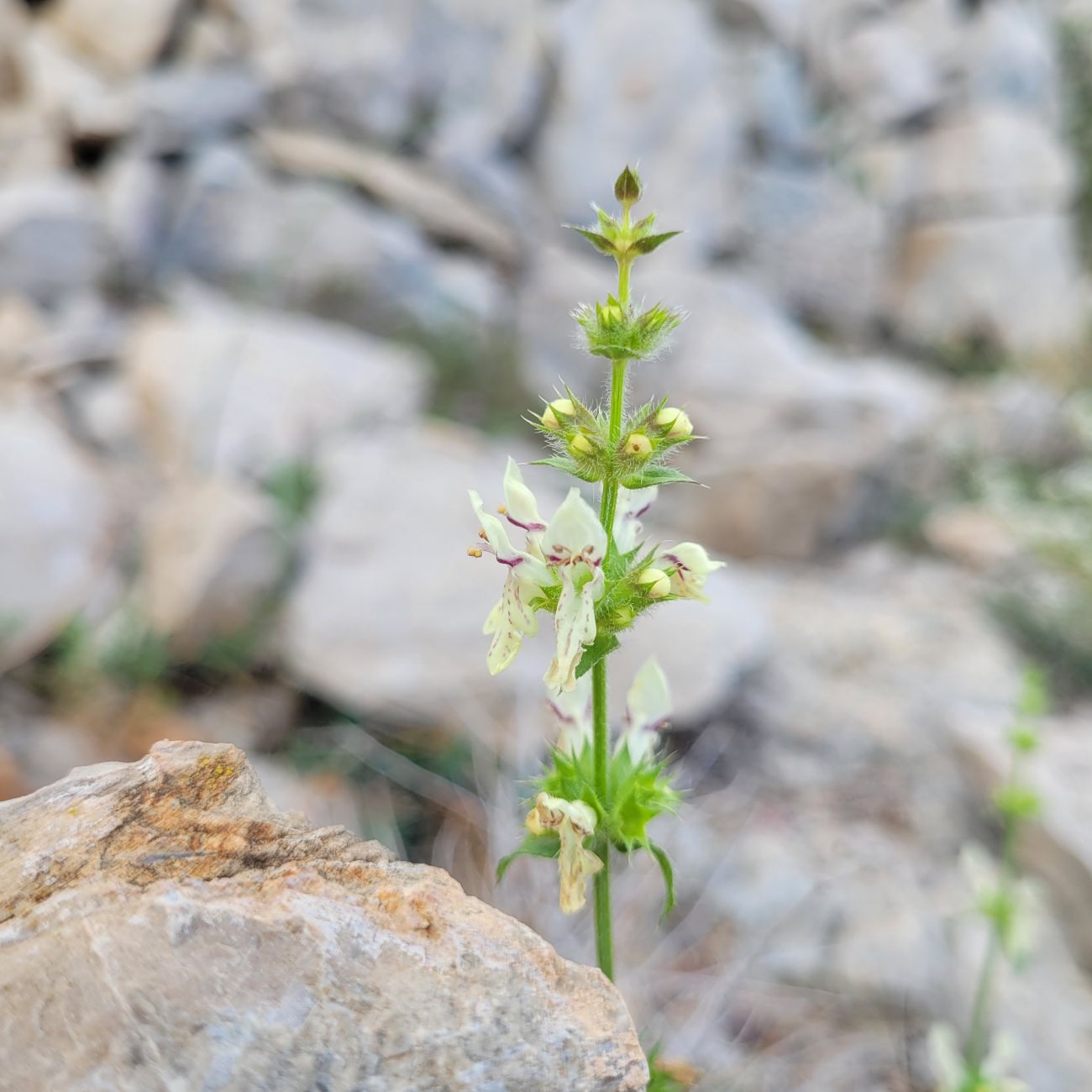
Stachys recta
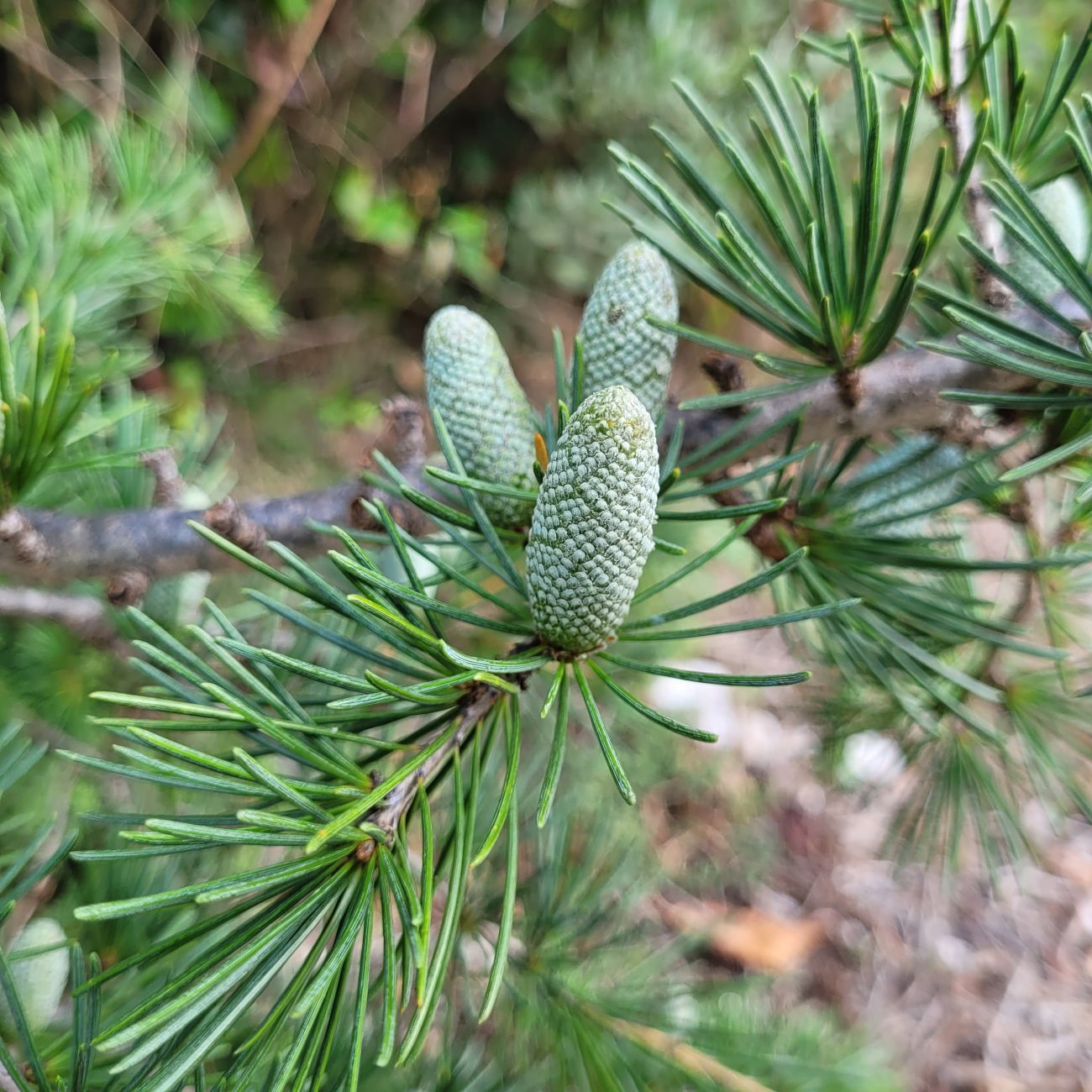
Cedrus libani
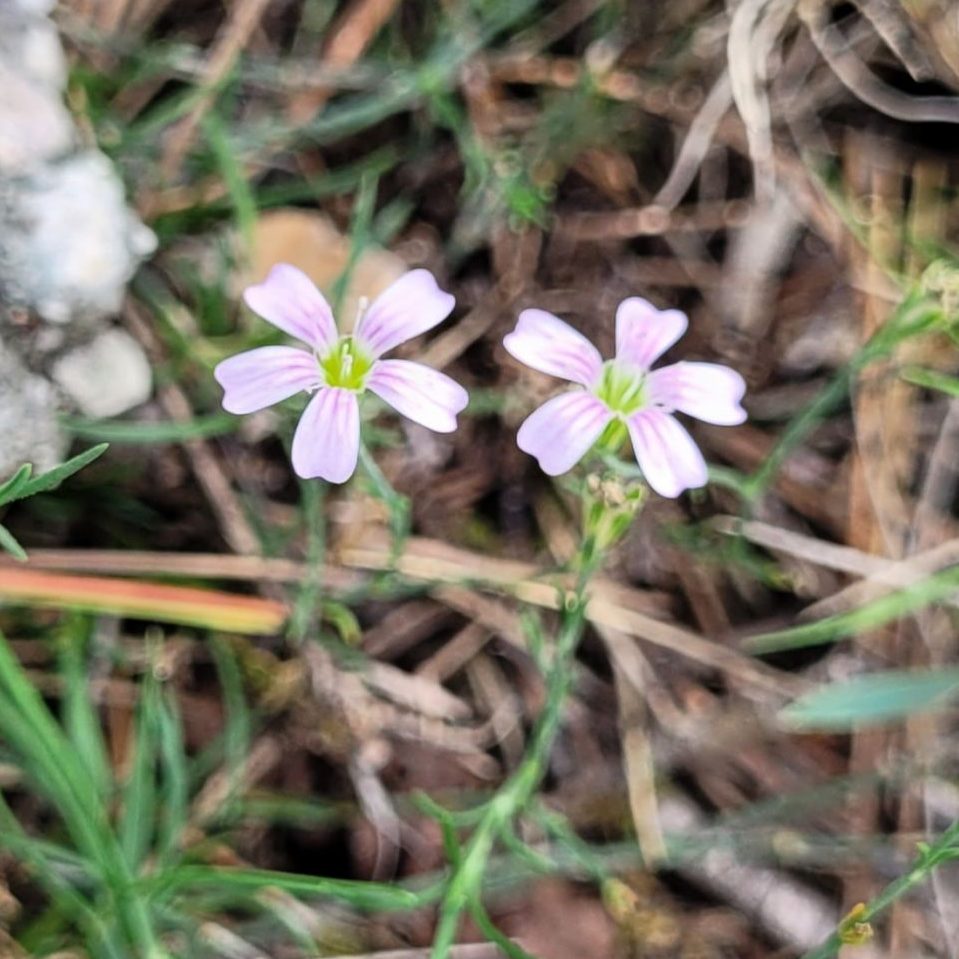
Petrorhagi saxifraga
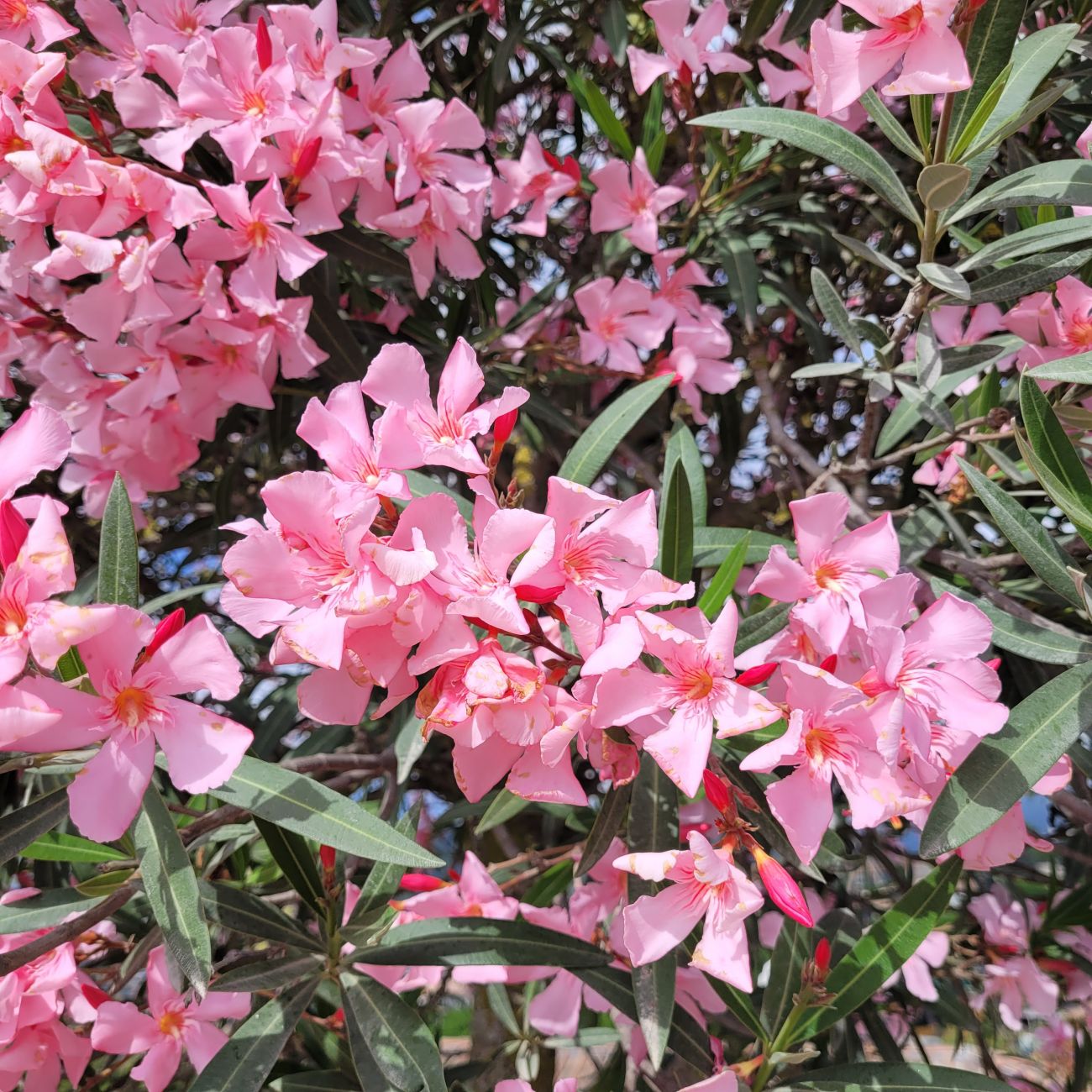
Nerium oleander
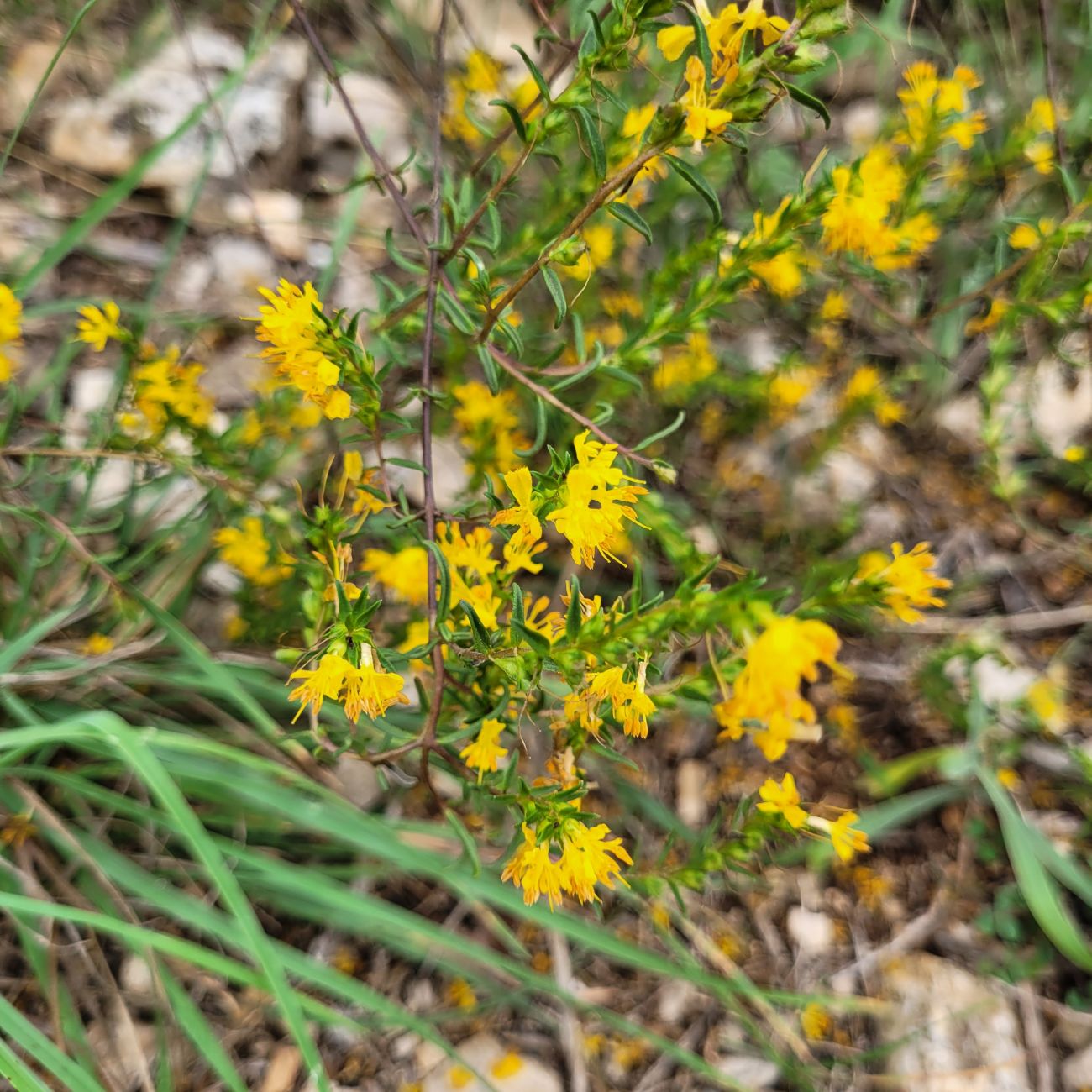
Odontites lutea
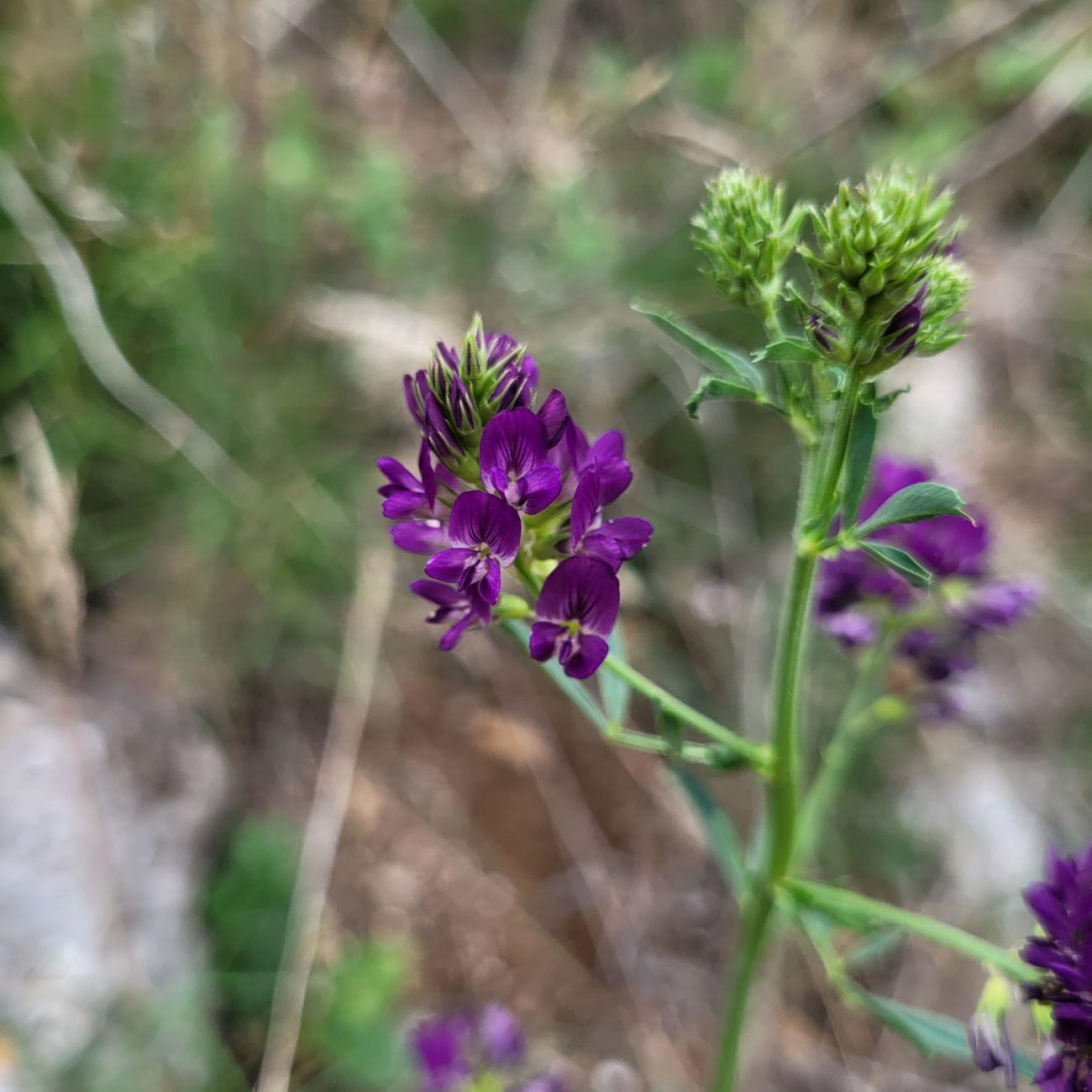
Medicago sativa

Pistacia lentiscu
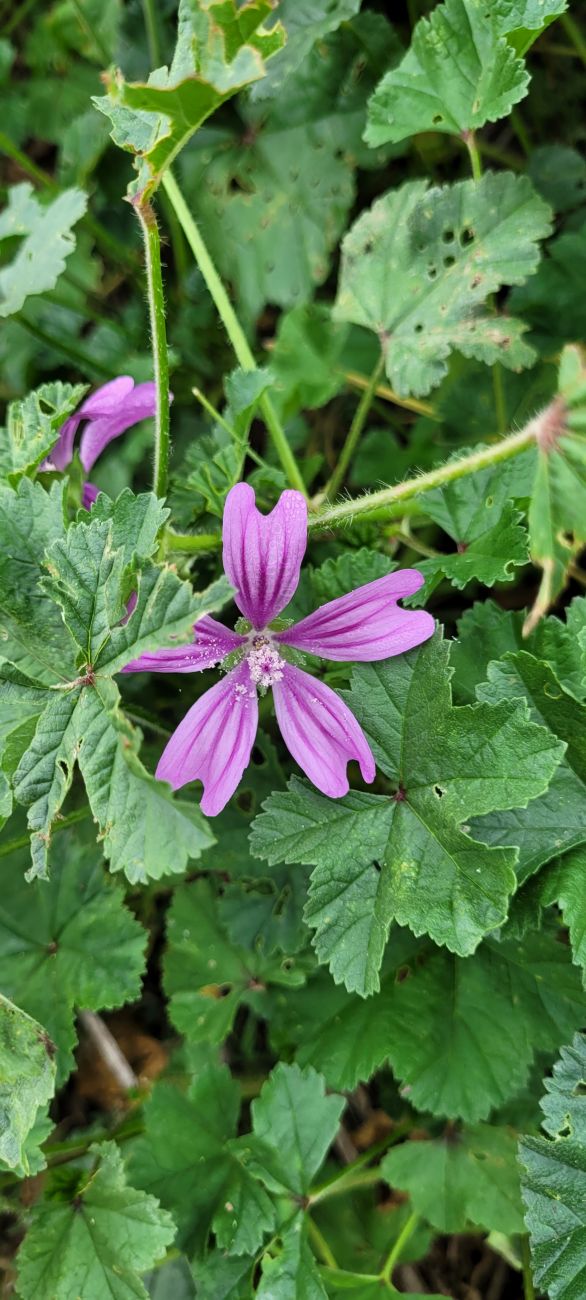
Malva sylvestris
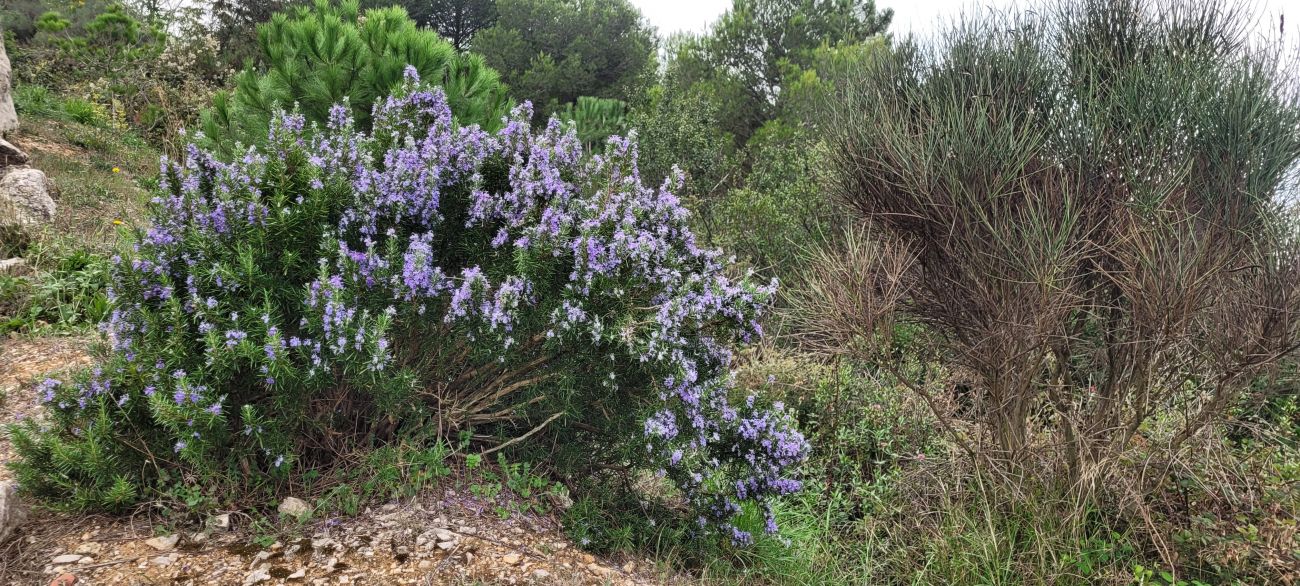
Salvia rosmarinus
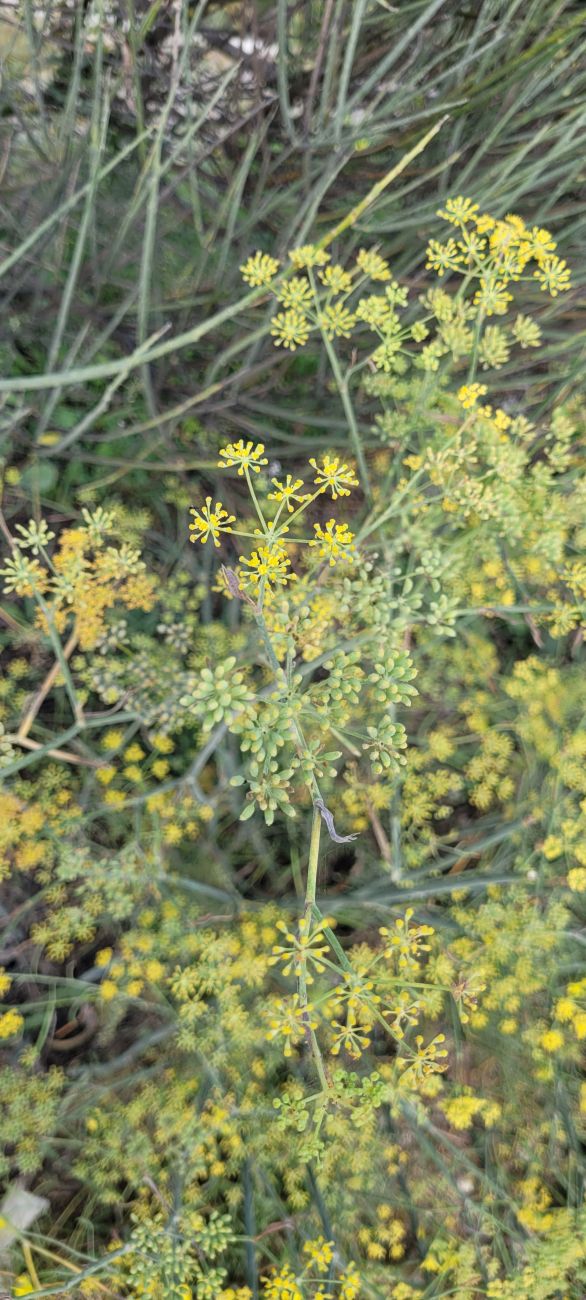
Foeniculum vulgare
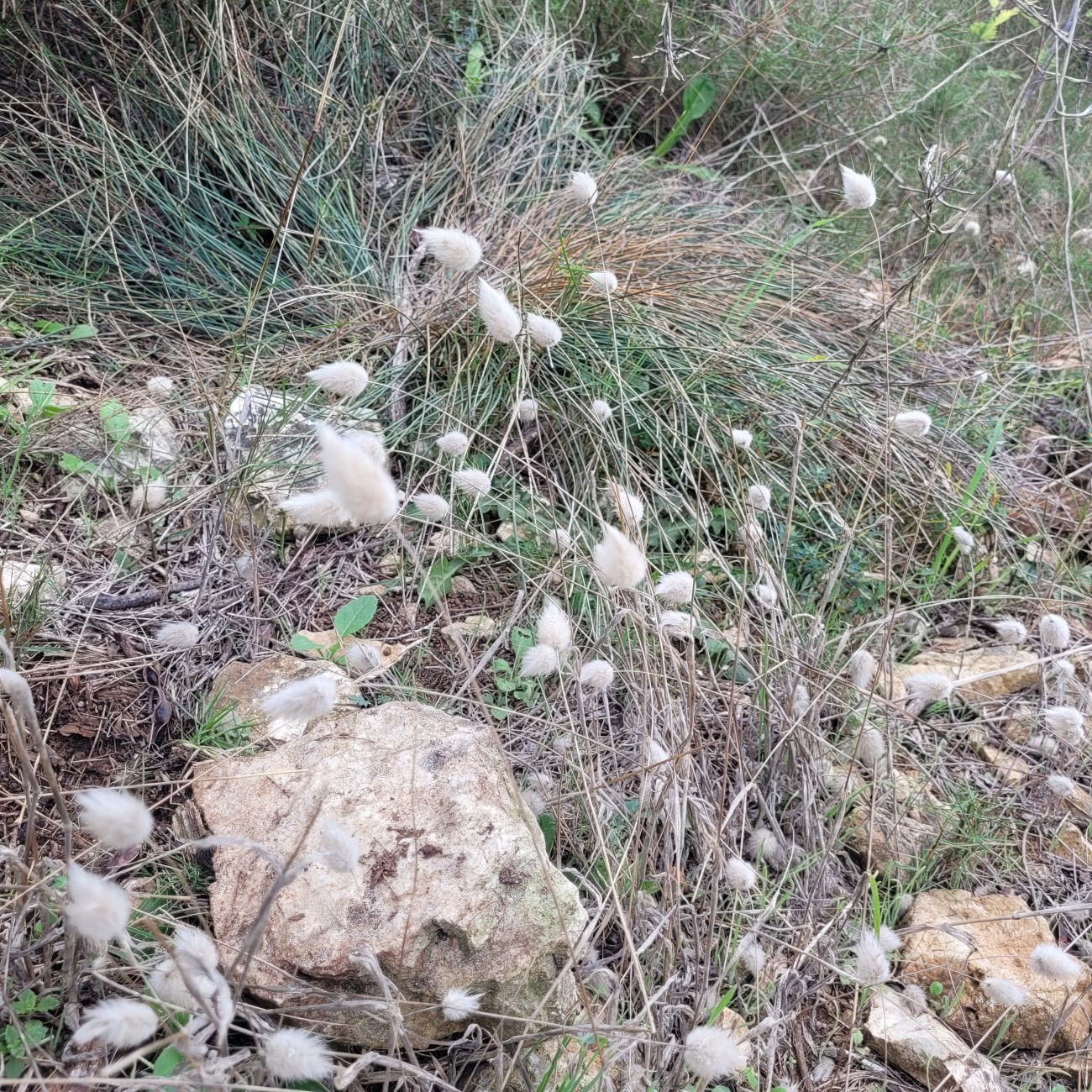
Lagurus ovatus
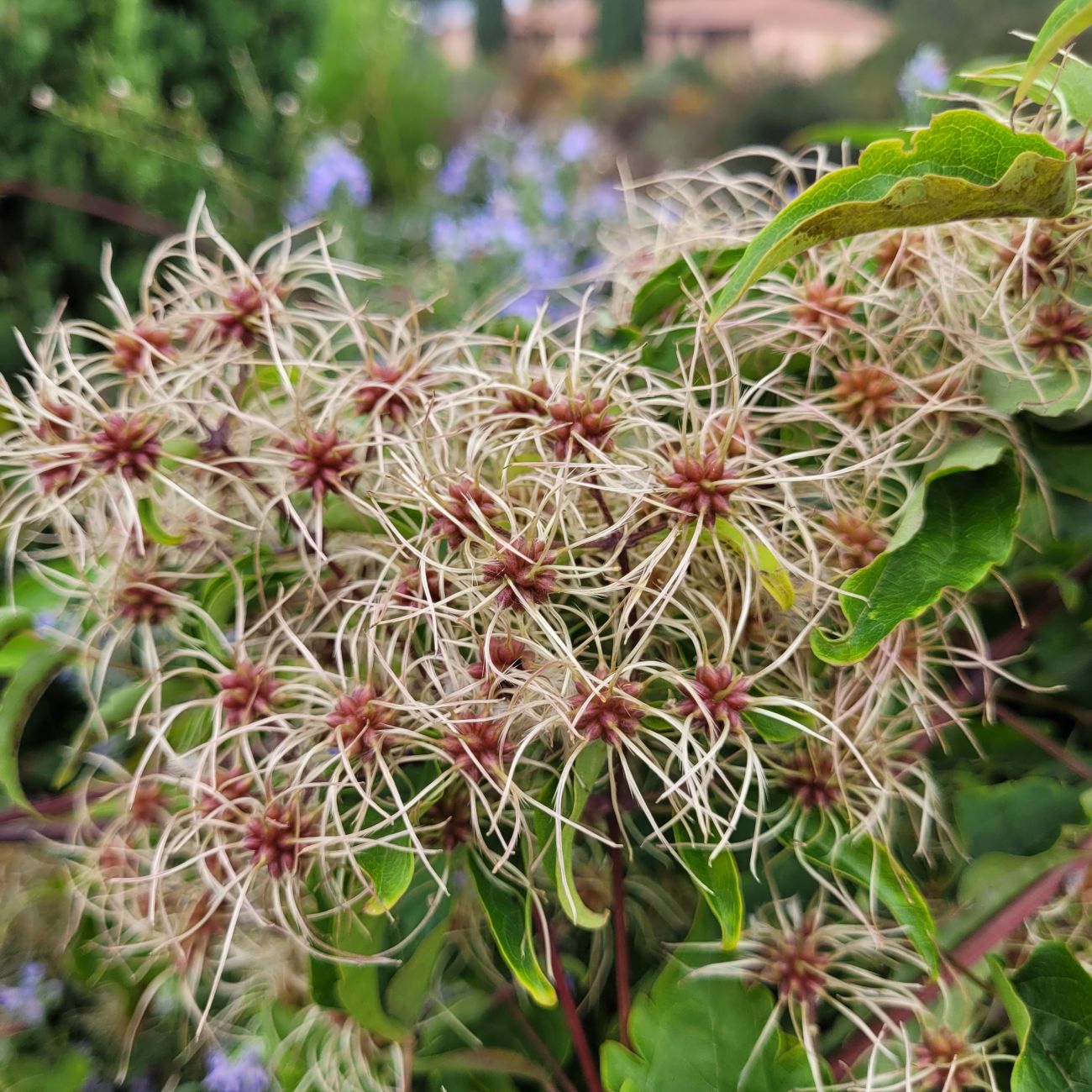
Clematis vitalba

Path around the summit of La Tête de Chien
Soil type – La Tête de Chien was the most typical soil profile to the Mediterranean of all the places I had visited in the area. The soil was mostly limestone rock with pockets of loam, shale and clay.
Irrigation – Non man-made means – Precipitation or fog.
Princess Grace Japanese Garden
After making my way back down La Tête de Chien, I walked right across the Principality to the Princess Grace Japanese Garden. The garden was created in 1994 at the request of Prince Rainier III in accordance with the strictest principles of Zen. It was designed by landscape architect Yasuo Beppu and aims to transport visitors to the land of the rising sun, even as they remain in the principality. However today it was less Zen as there was lots of building work going on.
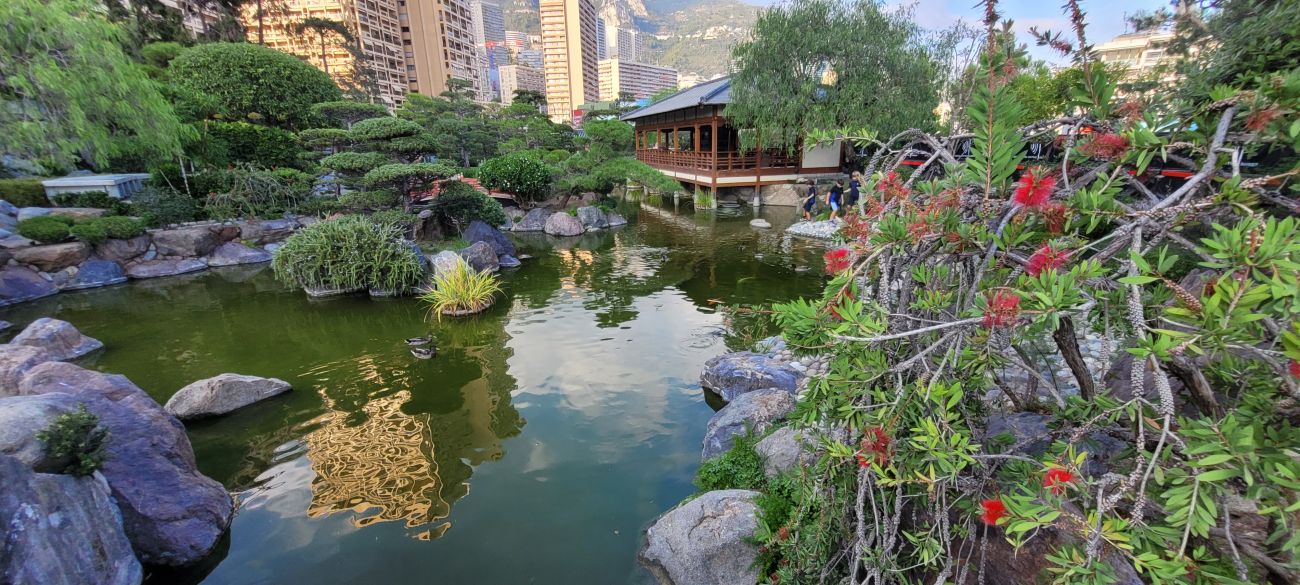
The Princess Grace Japanese Garden
This green oasis has a rich mix of Japanese tradition and Mediterranean touches, the result of a close collaboration between gardeners from Monaco and Japan. The bamboo hedges, tiles (Awaji Island), stone lanterns, and the woods used in the various structures (gate, tea house, etc.) were all imported from Japan, while the plants, all Mediterranean (pine, olive and pomegranate trees), were pruned and looked after by Mr Beppu for three years to give them a Japanese appearance and every year, Mr Beppu comes especially from Japan to pass on his knowledge and give advice to the current gardeners about looking after the plants.
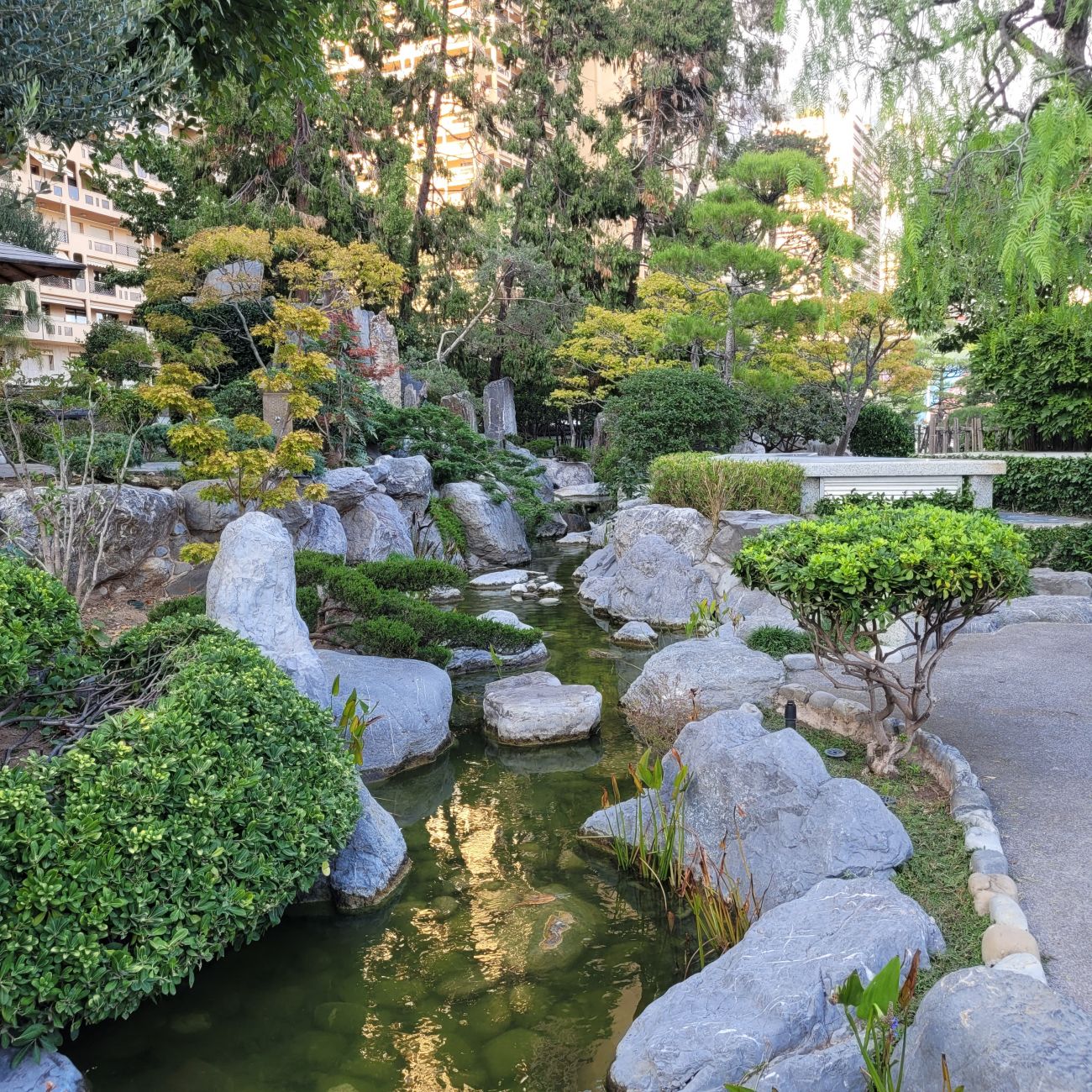
The pond in the Japanese Garden

Punica granatum
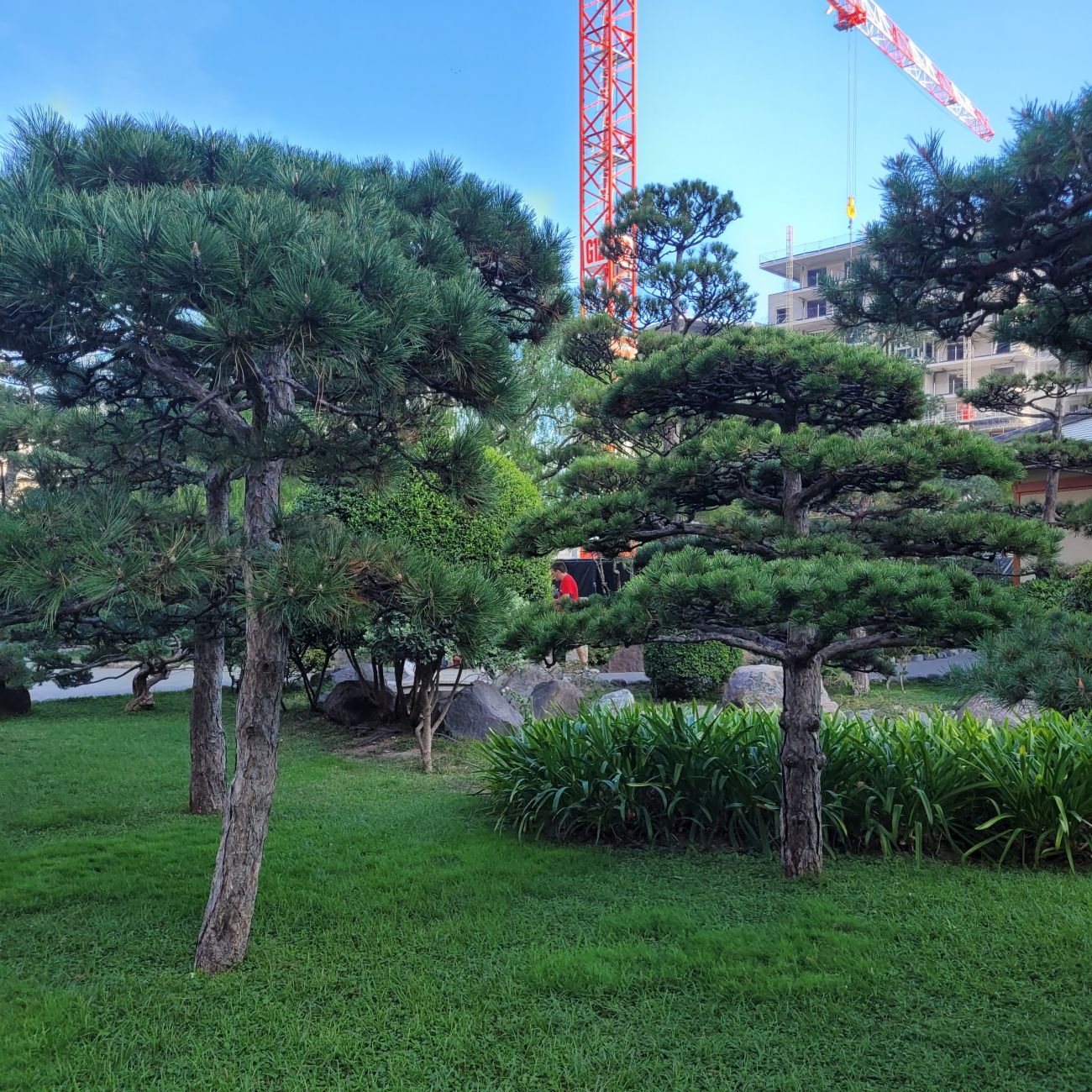
Pruned Mediterranean trees
Soil type – Princess Grace Japanese garden soil was mostly made up of a mixture of clay, loam and some large pieces of stone, which form the waterfall from Corsica, Auvergne and the Tinée Valley, and all were selected on site before being installed according to a precise plan, creating planting pockets.
Irrigation – Non man-made and man-made means – Precipitation, drip irrigation systems, manmade water features, ponds and waterfalls with a ‘spray’ effect and hoses.
Friday 13 October
On Friday I made my way to the train station, sad to leave Monaco and all its amazing plants, and on to Menton. As soon as I arrived, I noticed that the streets were lined with Jacaranda mimosifolia, although not native to the Mediterranean it created an amazing display of lime green and purple against the Mediterranean blue sky and white stone buildings. After a quick pit stop at the hotel to drop off luggage, I made my way to Jardin Botanique Val Rahmeh.
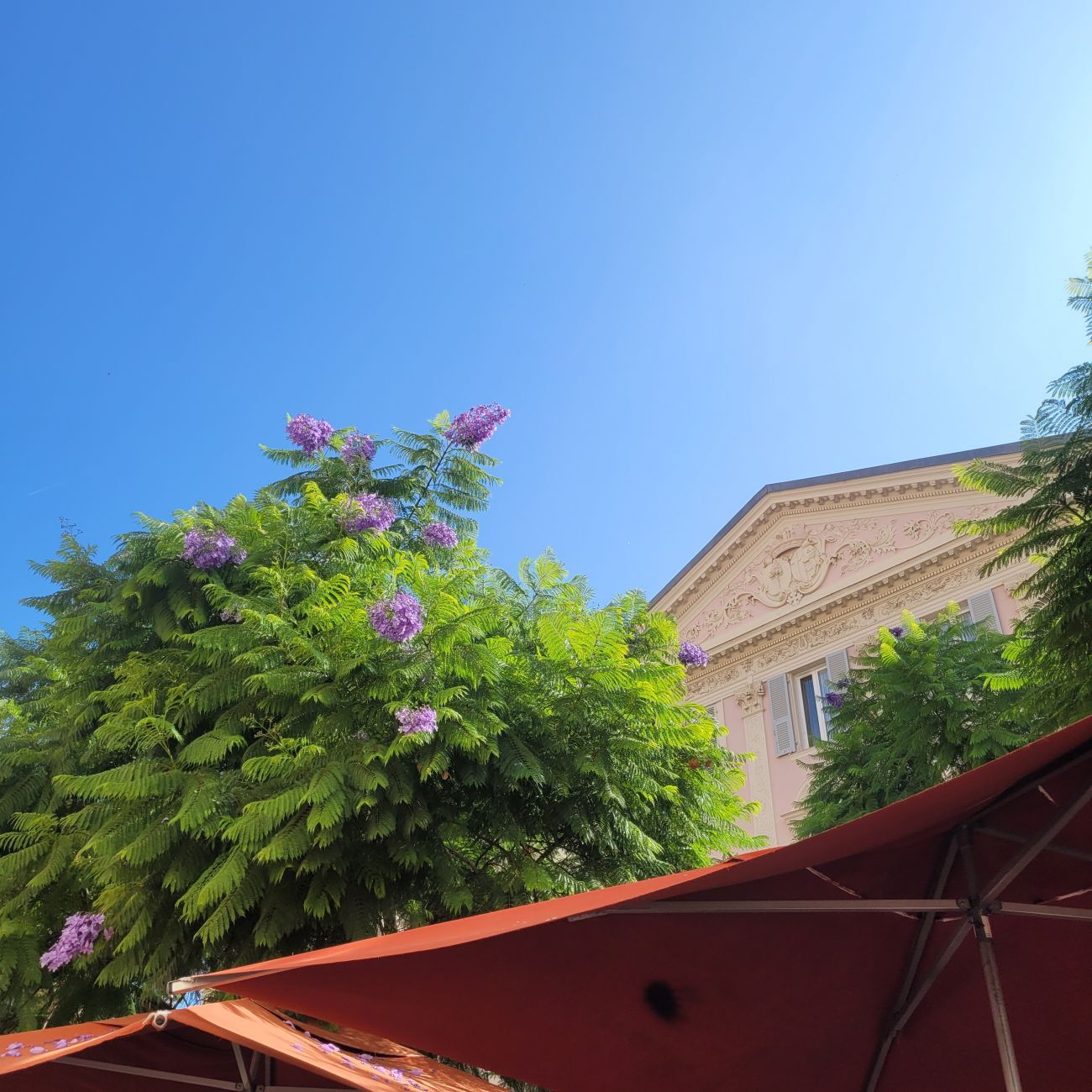
Jacaranda mimosifolia
Villa Val Rahmeh
Villa Val Rahmeh was bought by Lord Percy Radcliffe in 1905 and was transformed into a landscape garden with many exotic species. During the 1920s the villa was extended and renovated. The name means valley of tranquillity in Arabic-Persian.
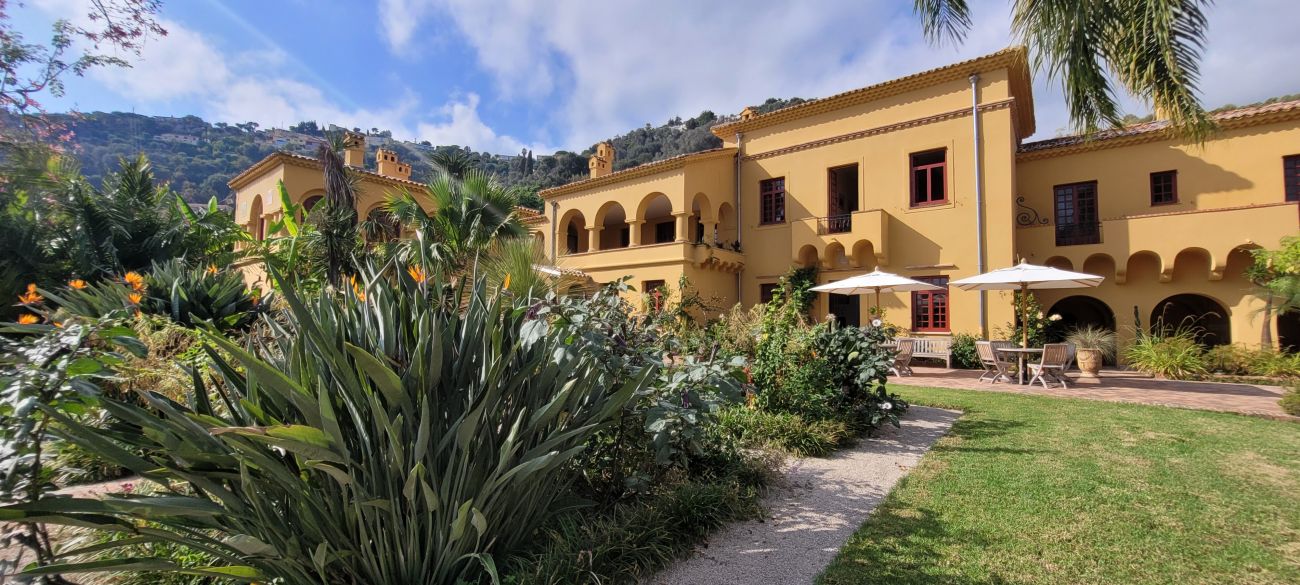
Villa Val Rahmeh
On entry to the villa on the driveway I came across a wall of topiarised Cupressus sempervirens planted in the 1930s. I met one of the gardeners and an interpreter and took an interesting tour of the gardens, learning about the different plants they have chosen to use. Most of the collection is of non-endemic plants which have been introduced and mixed with the local flora. With the changing climate, less precipitation, warmer summers and milder winters, like that of Northern Africa, many of the plants can survive the winter without protection so more exotic planting schemes are achievable as plants are flowering for longer.
The first endemic plant I came across was in the dry garden, part of the path was covered with Mesembryanthemum nodiflorum. The pop of pink being a lovely accent to the grey stone path with again an old Olea europaea creating an upper layer to the modern, exotic dry garden which I am beginning to see is a theme along the Cote d’Azur. Further along the path I found Trachelium caeruleum clinging to the side of one of the quite steep clay, banks and many Chamaerops humilis.
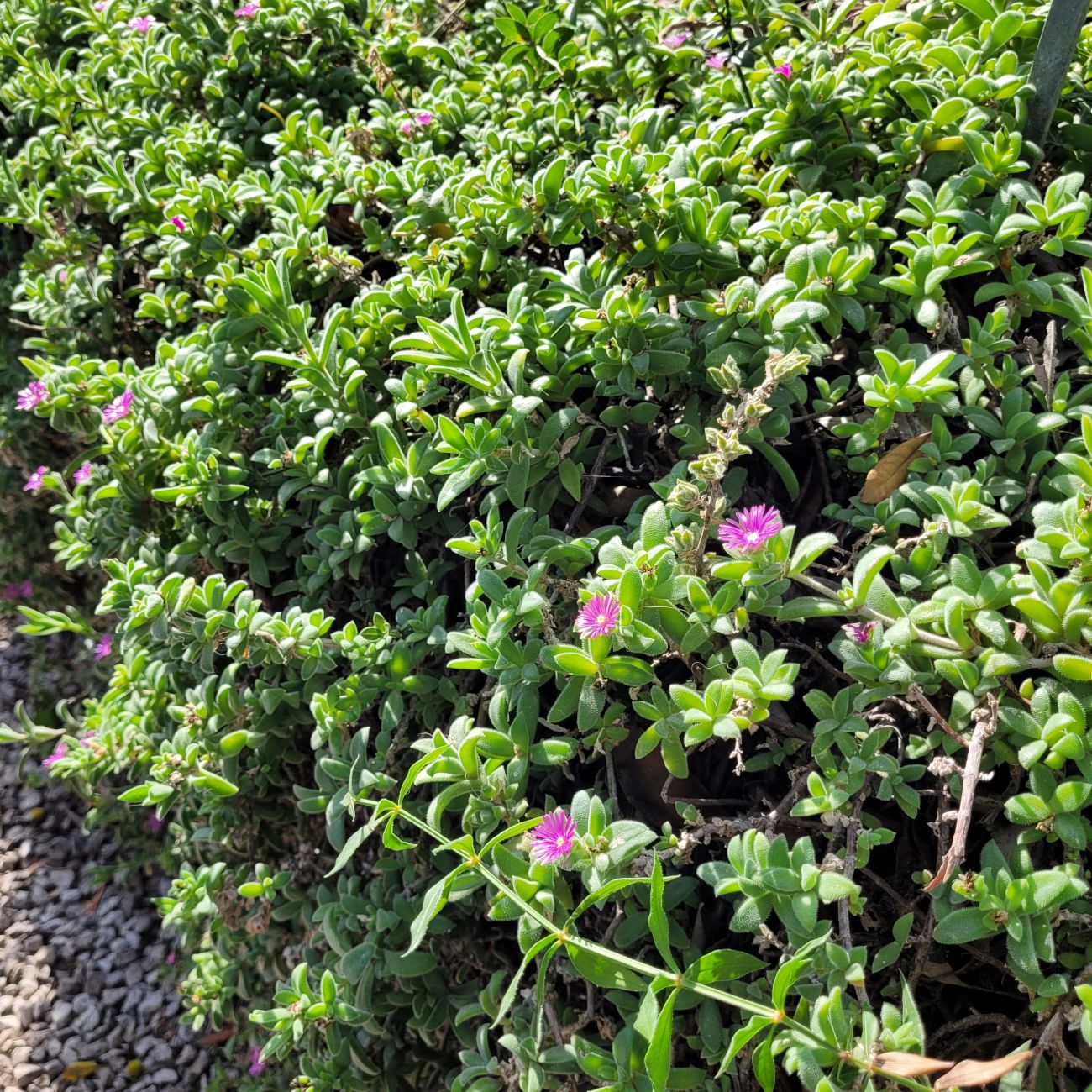
Mesembryanthemum nodiflorum
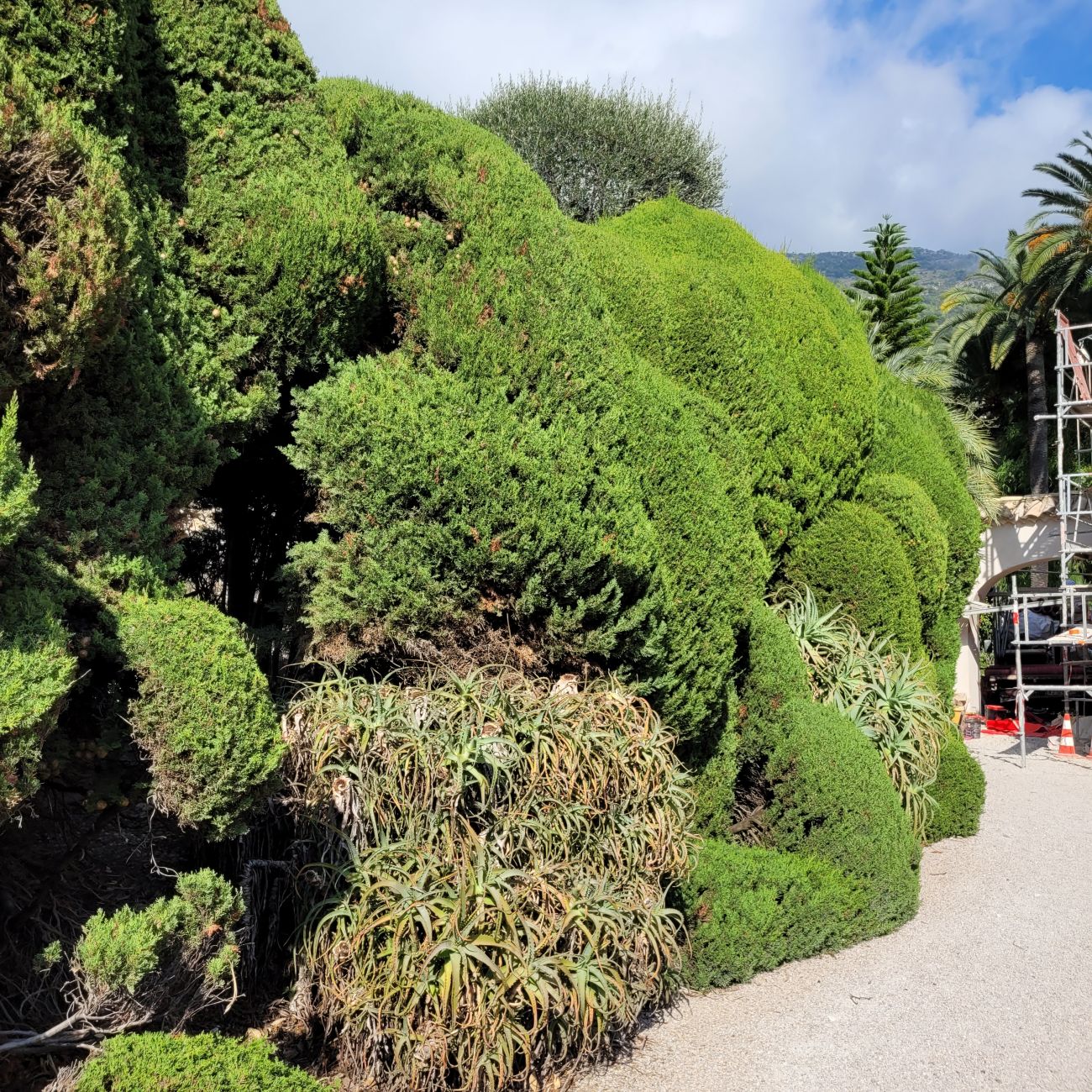
Cupressus sempervirens topiary

Olea europea
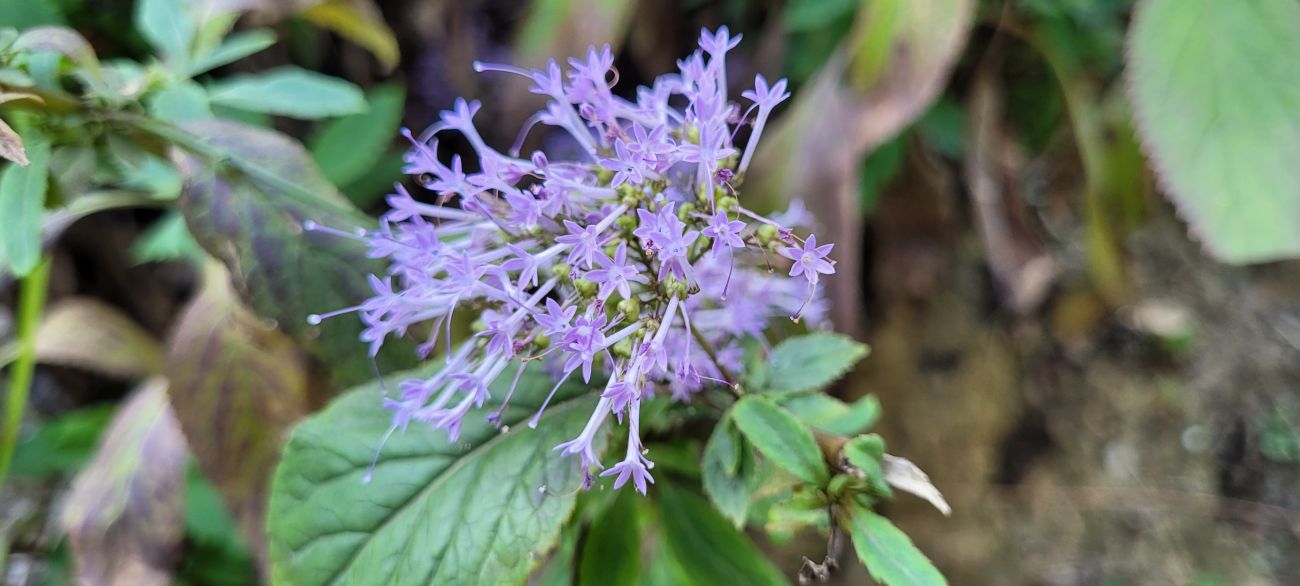
Trachelium caeruleum
Soil type – The main type of soil at Val Rahmeh is a clay and limestone mix with a lot of organic matter added, however this is bought in as they do not have the composting ability on site.
Irrigation – Non man-made and man-made – Through irrigation pipes underground, hand watering with hose and ponds. There is a lot of watering done during the months of May to October.
Saturday 14 October
Giardini Botanici Hanbury
On Saturday I visited Giardini Botanici Hanbury, the most awkward to get to but well worth it. One of the main reasons I decided to visit this garden was to see their citrus collection which includes 73 varieties of citrus and consists of about 300 plants grown in the ground. Even though the geographical origin of most of the species of the genus Citrus is identifiable in three different regions of south-east Asia it has had a great and successful development and spread of cultivation in the Mediterranean area and is worth mentioning.
Thomas Hanbury bought the farm from the Orengo family located in Mortola, in 1867 and the garden’s transformation into one of the most famous gardens of the world began.
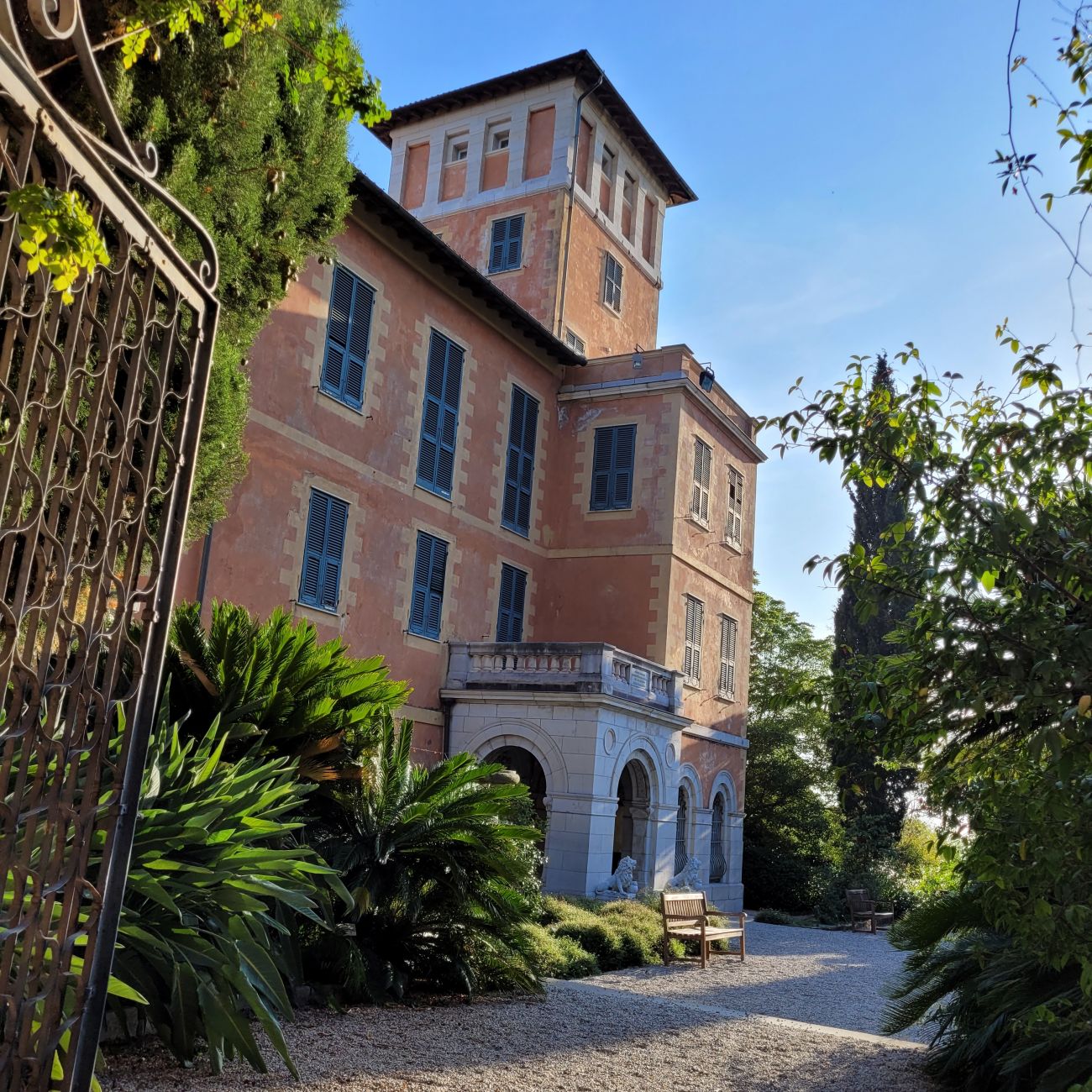
Giardini Botanici Hanbury
At the start of Olive Avenue, about half-way between the entrance and the sea, there is a magnificent display of not only a 400-year-old Olea europaea but also Salvia leucantha and Citrus deliciosa. The Olea europaea has had to have one of its limbs removed as it was obstructing the path, however it has survived.
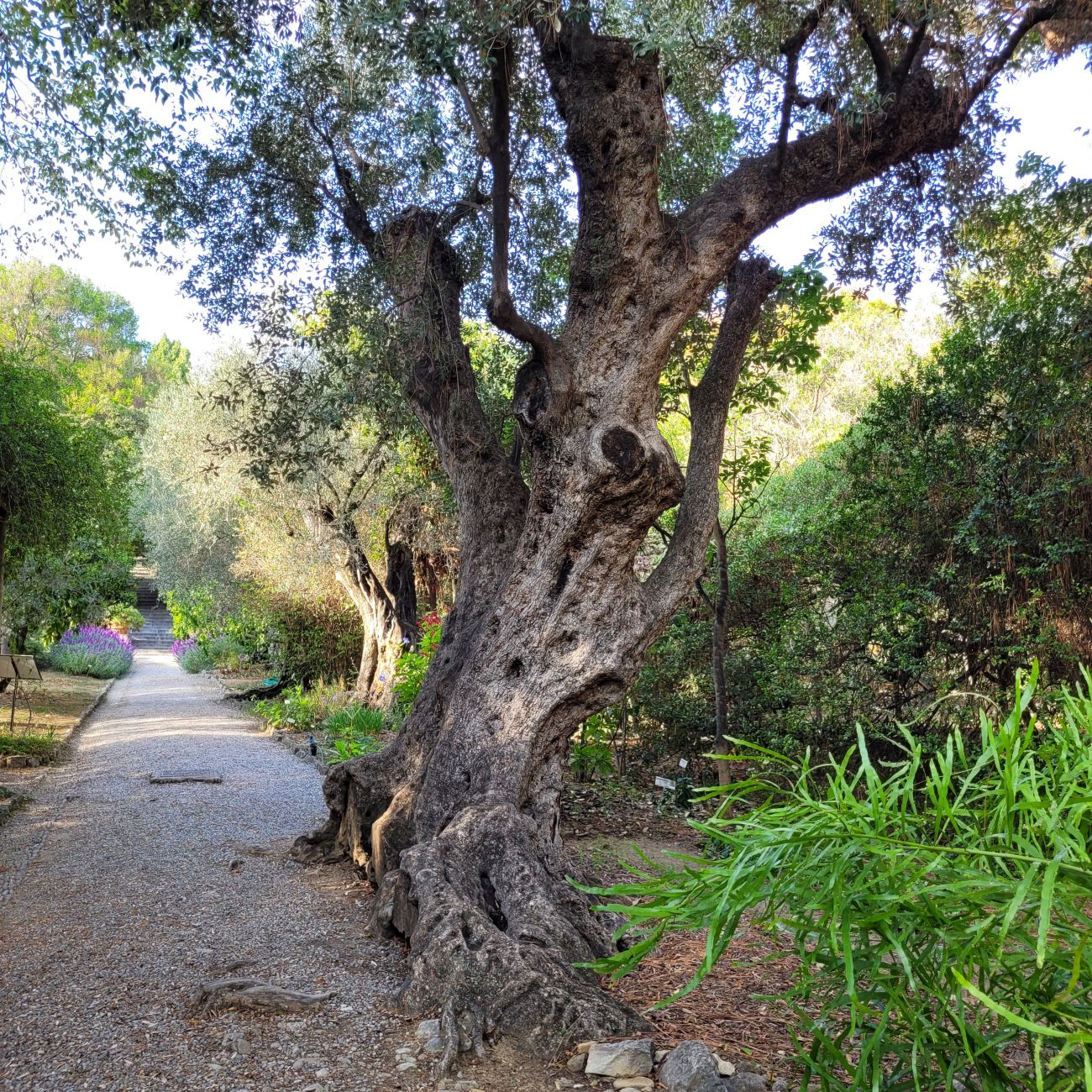
400-year-old Olea europaea
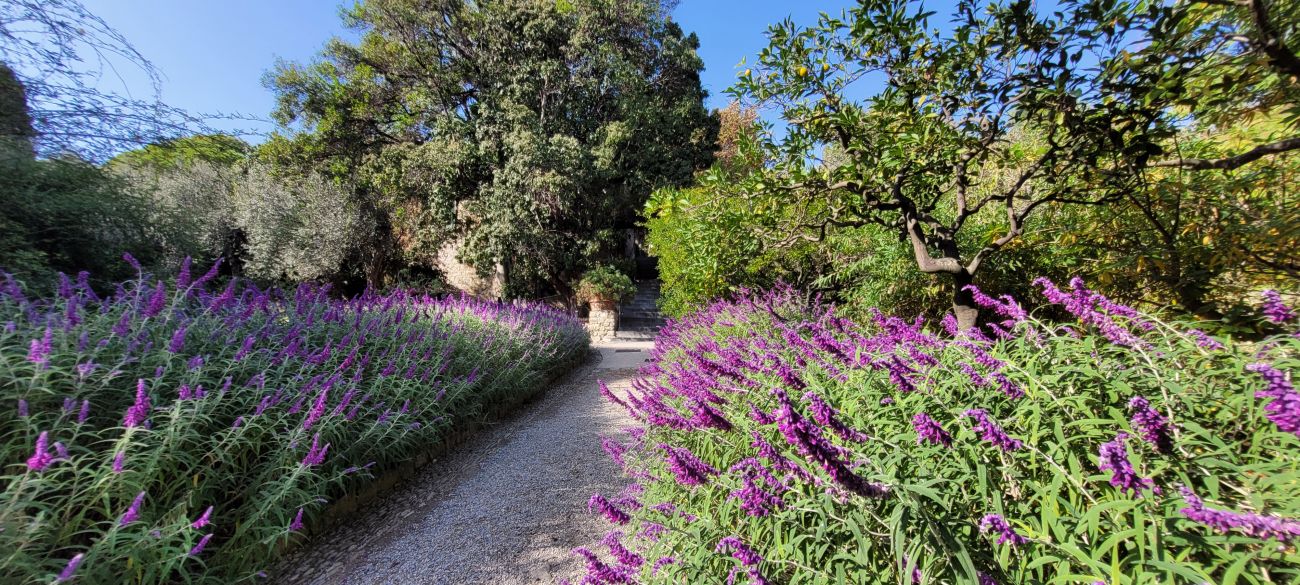
Salvia leucantha
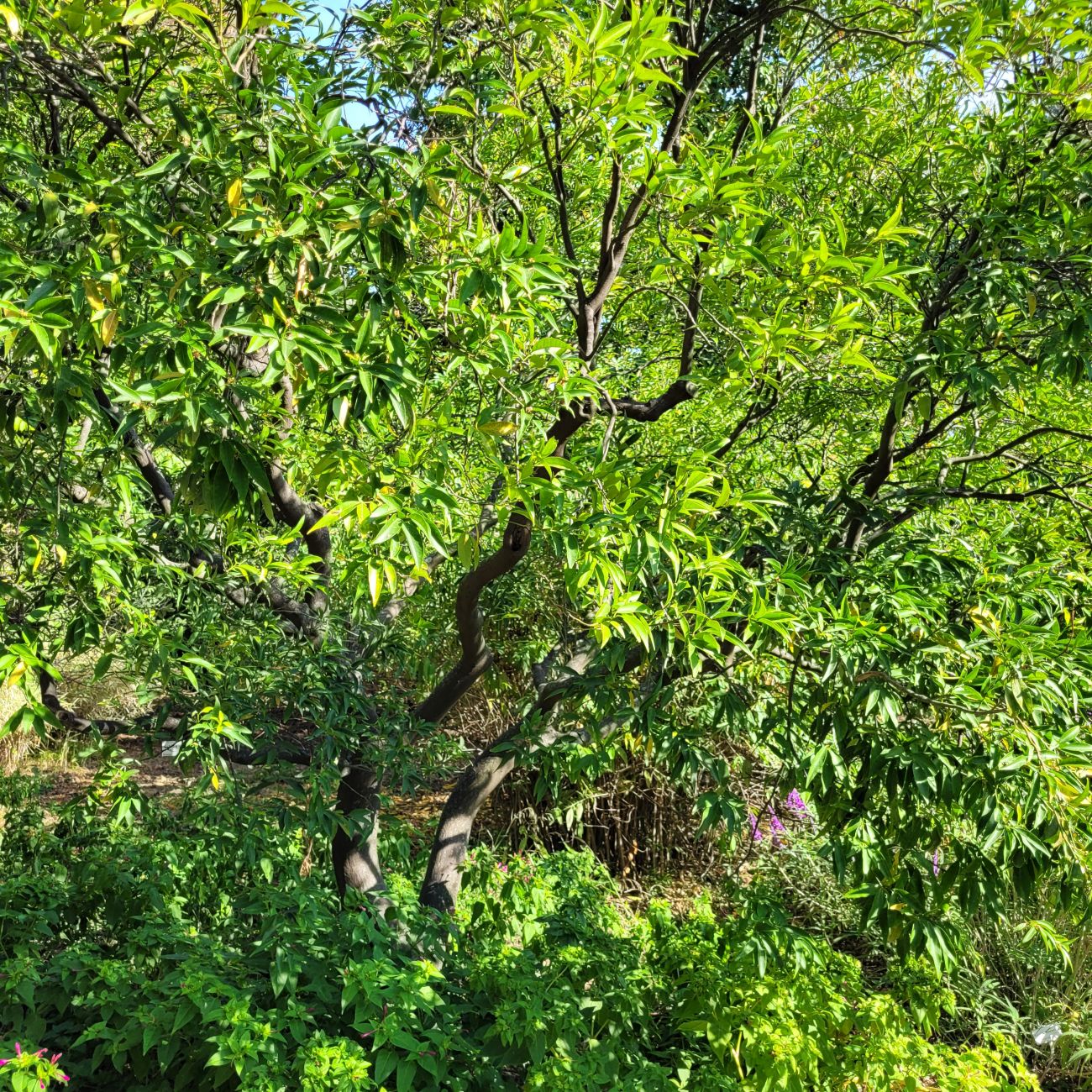
Citrus deliciosa
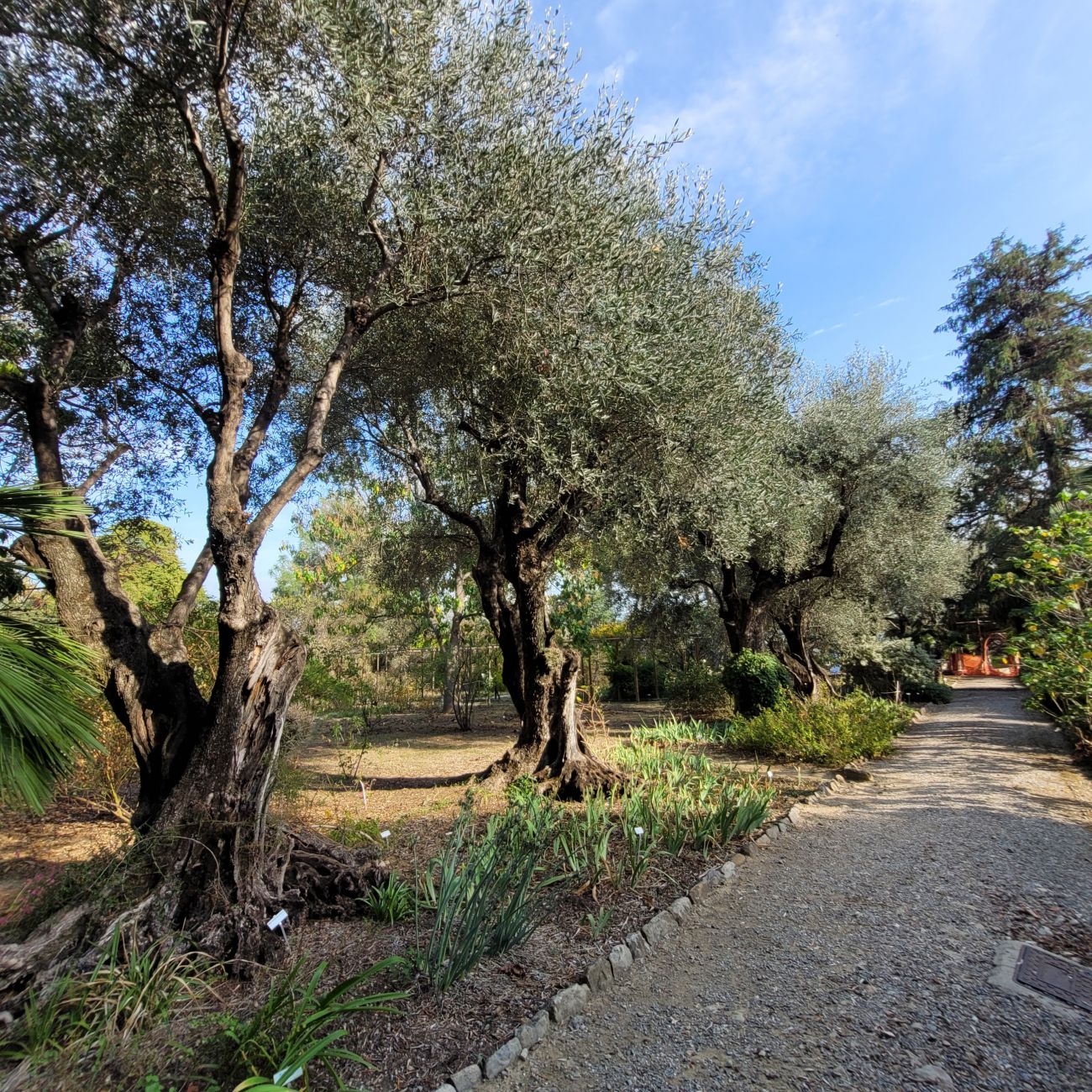
Olive Avenue
In the Pinana at the right-hand side of Olive Avenue there is a rich collection of ancient varieties of citrus trees. In particular; Citrus maxima, Citrus lumia, Citrus hystrix, Citrus bergamia, Citrus auranium, Citrus sinensis, Citrus limon, Citrus x paradisi, Citrus deliciosa, Citrus tangerina, Poncirus trifoliata and Fortunella margarita to name a few. All having vast numbers of fruit on them, aided by the mild temperatures and low rainfall in the area.
On the other side of the avenue there is a small orchard of local fruit trees such as; Sorbus domestica, Crataegus azarolus, Zizyphus jujuba, Mespilus germanica and Pistacia vera.
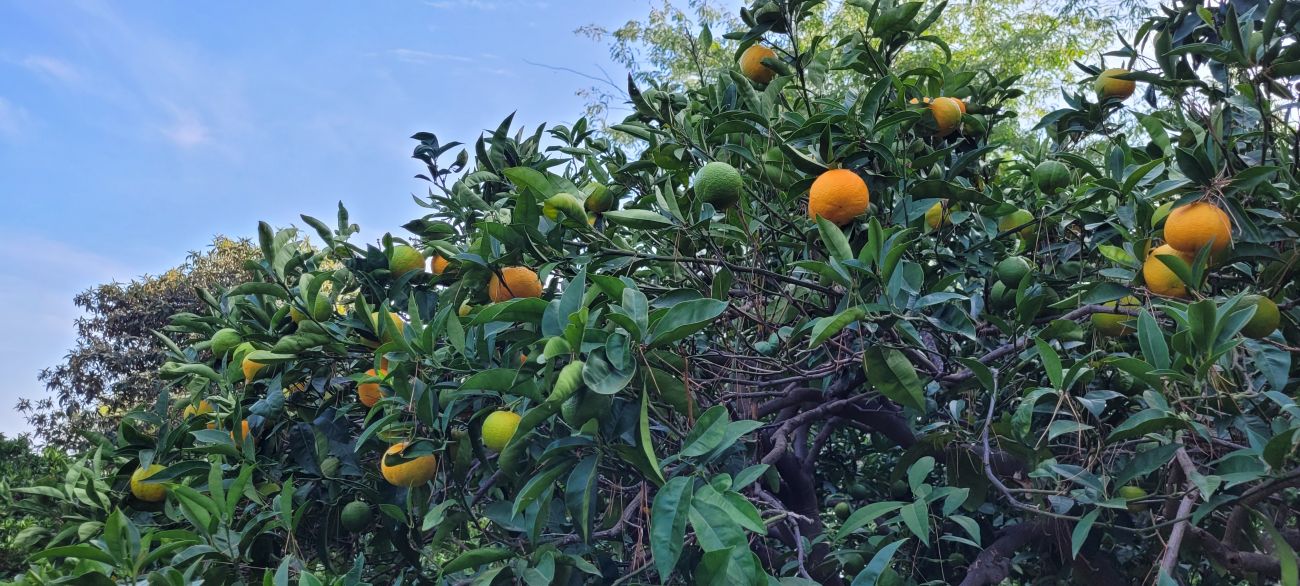
Citrus sinensis ‘Vaniglia’
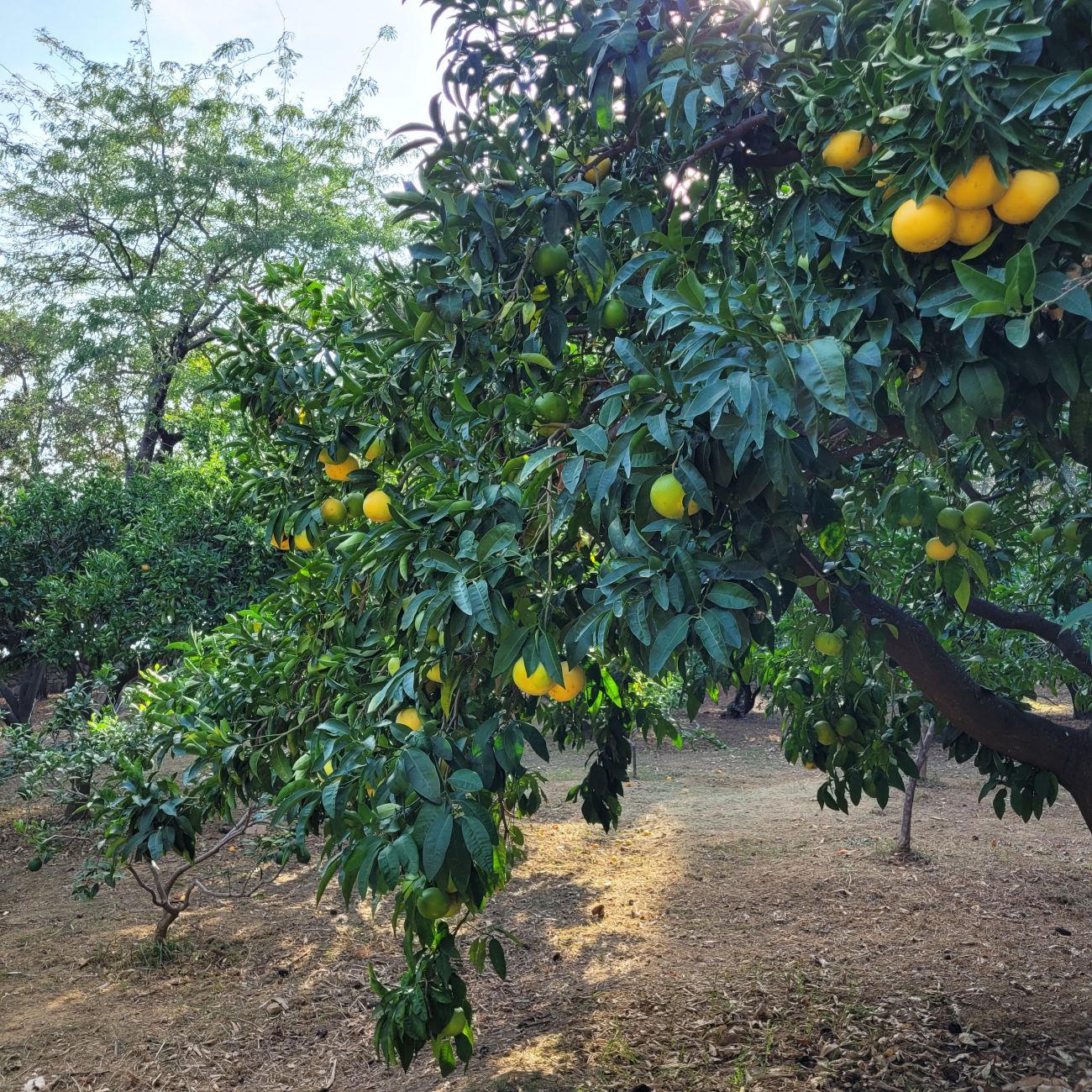
Citrus sinensis
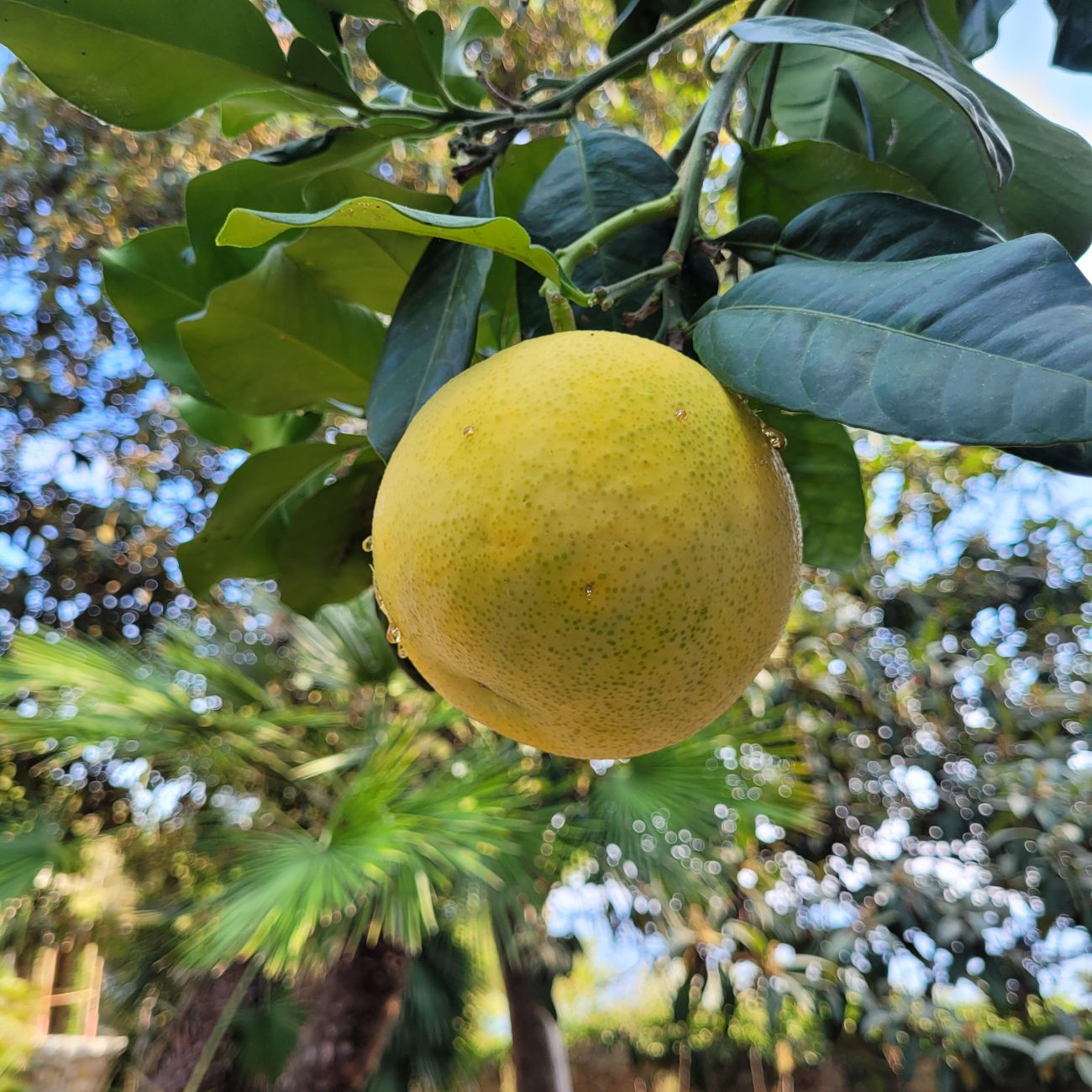
Citrus x paradisi
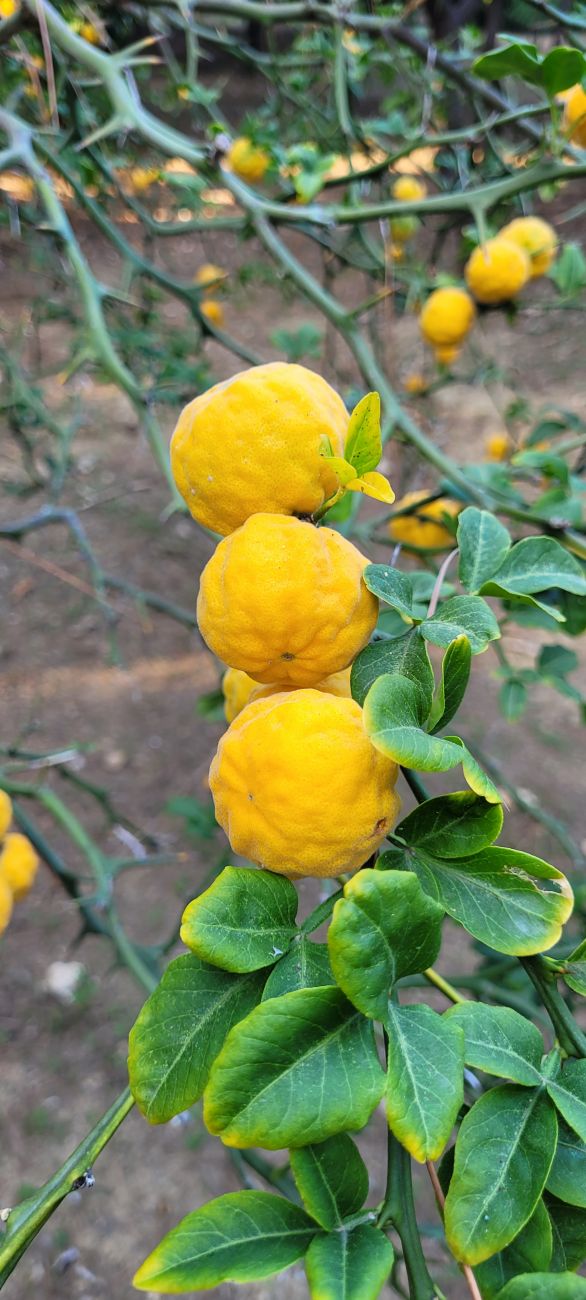
Poncirus trifoliata ‘Flying dragon’
Soil type – The soil type in Hanbury Botanique is a mixture of clay and loam mix with a lot of organic matter added as it used to be agricultural land. Organic layer of mulch made from pruning and mowing waste of at least 10cm is added, this not only helps to add organic matter back into the soil but helps increase the absorption of rainwater.
Irrigation – Non man-made and man-made means – Precipitation, drip irrigation systems, manmade water features, ponds and hoses. Through thick mulch layers and leaving the dry apparatus on the plants, methods established by Thomas Hanbury when he was creating the garden and now practised by the university which owns the gardens, these help reduce the amount of irrigation the garden needs. By leaving plants such as palms and yuccas as they would in their natural habitat, with dead leaves wrapped around them, this protects themselves from transpiration in the long periods of drought, during summer in general from middle of June until the arrival of the first rain in September, of which most of the plants are dormant to protect themselves. During this period there is a fine balance between watering these plants for their survival and overwatering them, which brings on unnatural forced growth in the wrong season but also wastes precious water.
Sunday 15 October
Serre de la Madone
Major Lawrence Johnston was an American with a passion for botany in architecture and is famous for his gardens at Hidcote Manor in England and Serre de la Madone in France. Between 1924 and 1939, he acquired seven hectares of agricultural terraces and woodland in the Sierra della Madona. And embarked upon the creation of his ‘earthly paradise’, a unique exotic landscaped garden, filled with a vast array of rare plants brought back from across the world and painstakingly laid out amongst pools, fountains, statues and flights of curving steps, which lend the site its charm. All that remains now of the valley’s agricultural past are the citrus terraces along with Olea europaea.
One of the most constant themes throughout the garden that I noticed was the umbrella pines (Pinus pinea) prominent across many of the garden ‘rooms’ which have been created. The former olive grove contains terraces where the olive trees were preserved and cultivated by Johnson, however, it has now been transformed into a South African Meadow with few olives remaining. Along one of the walls, just behind the glass house on one of the walls, was a Capparis spinosa, quite a small specimen that you almost would have missed if you were in a hurry. Even though it was a Sunday the gardens were noticeably quiet and serene, with most of the time it was me and one other visitor.

Serre de la Madone
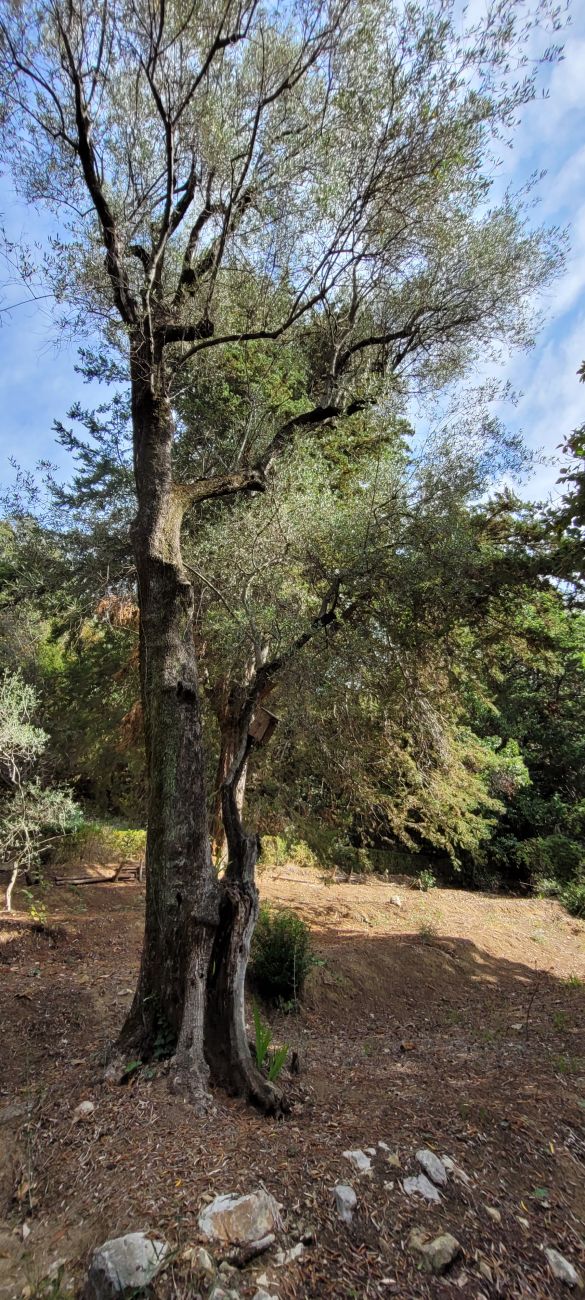
Ancient Olea europaea
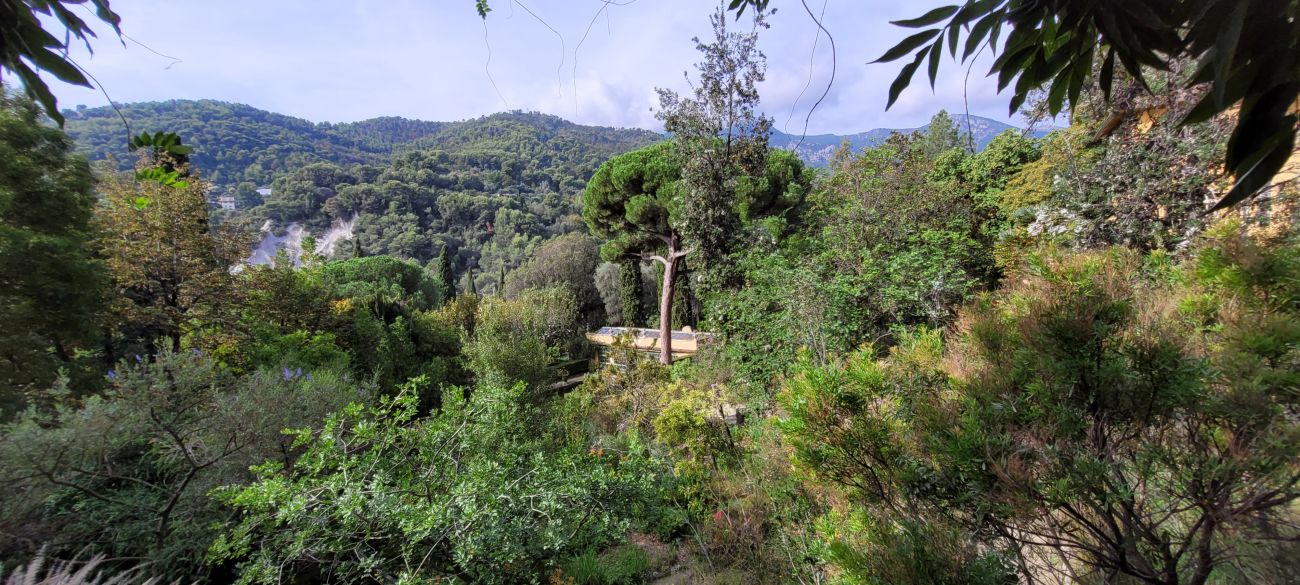
View of Pinus pinea from above the garden
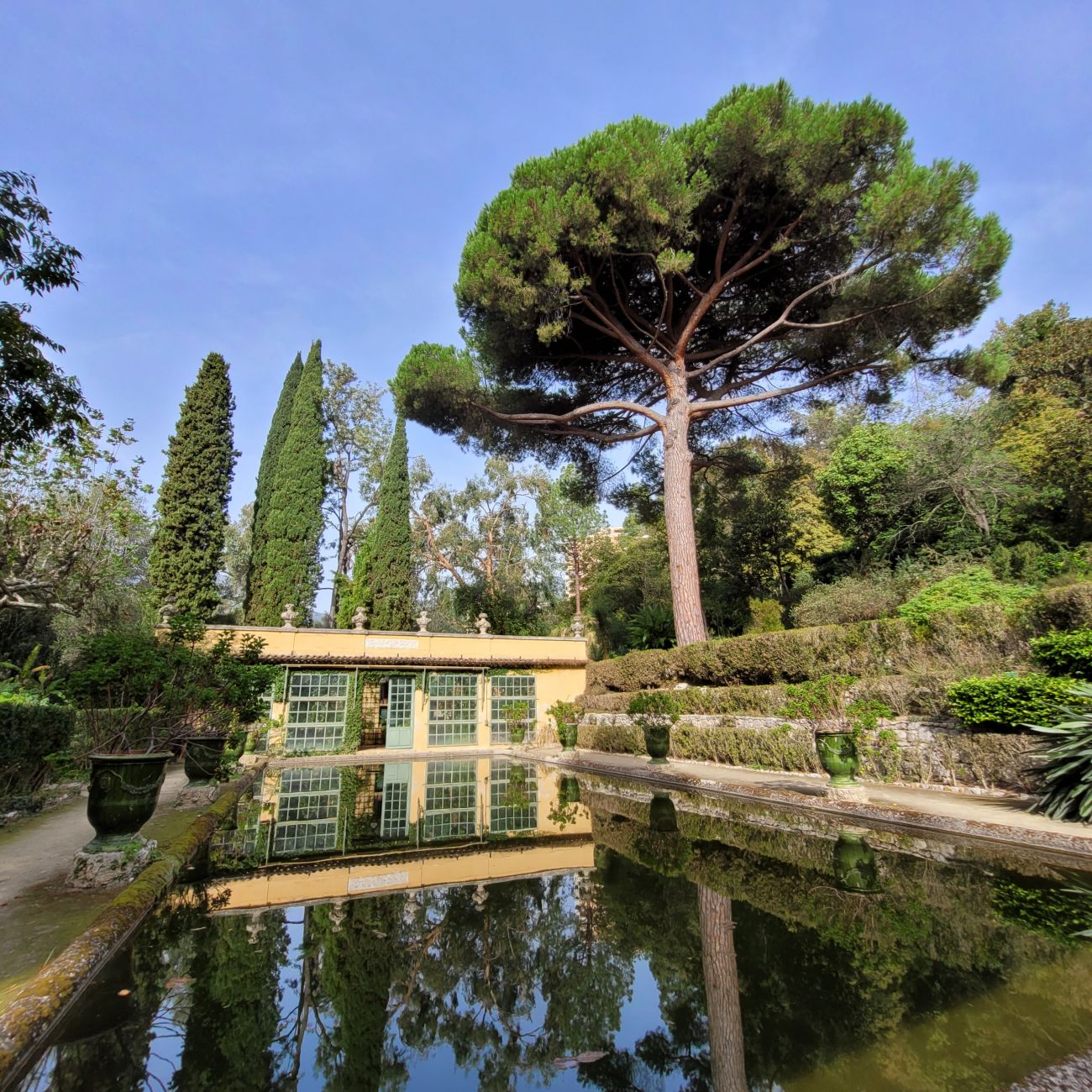
Pinus pinea over the glasshouse
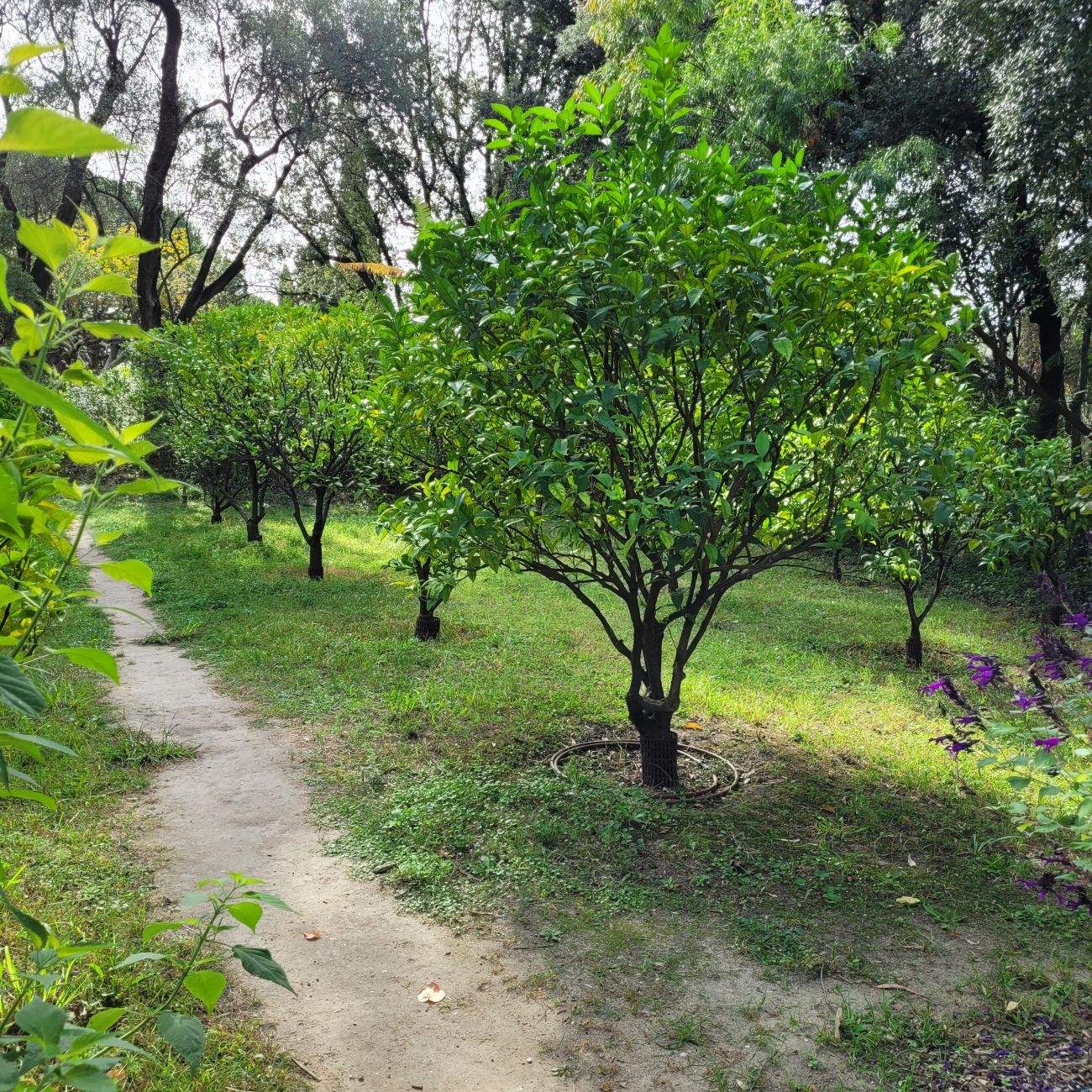
Citrus terraces

Capparis spinosa
Soil type – The soil type in Serre de la Madone is a clay and loam mix with a lot of organic matter added as it used to be agricultural land.
Irrigation – Non man-made and man-made means – Precipitation, drip irrigation systems, manmade water features, ponds and hoses.
Monday 16 October
Parc Phoenix
The last garden I visited on the trip was Park Phoenix in Nice. It is made up of seven hectares situated in the l’Arenas district on Nice’s south-western edge. It contains a greenhouse, which is one of the largest glass houses in Europe and contains seven different zones of hundreds of different plant species of native and exotic plants. Within the garden there are a large number of Phoenix canariensis adding to the exotic feel. Within the glasshouse there was an amazing Ficus roxburghii, half trained up the wall and the other half trailing down onto the water below. Outside in the Mediterranean section of the garden there was Pennisetum villosum and a variegated Nerium oleander, which I haven’t seen before.
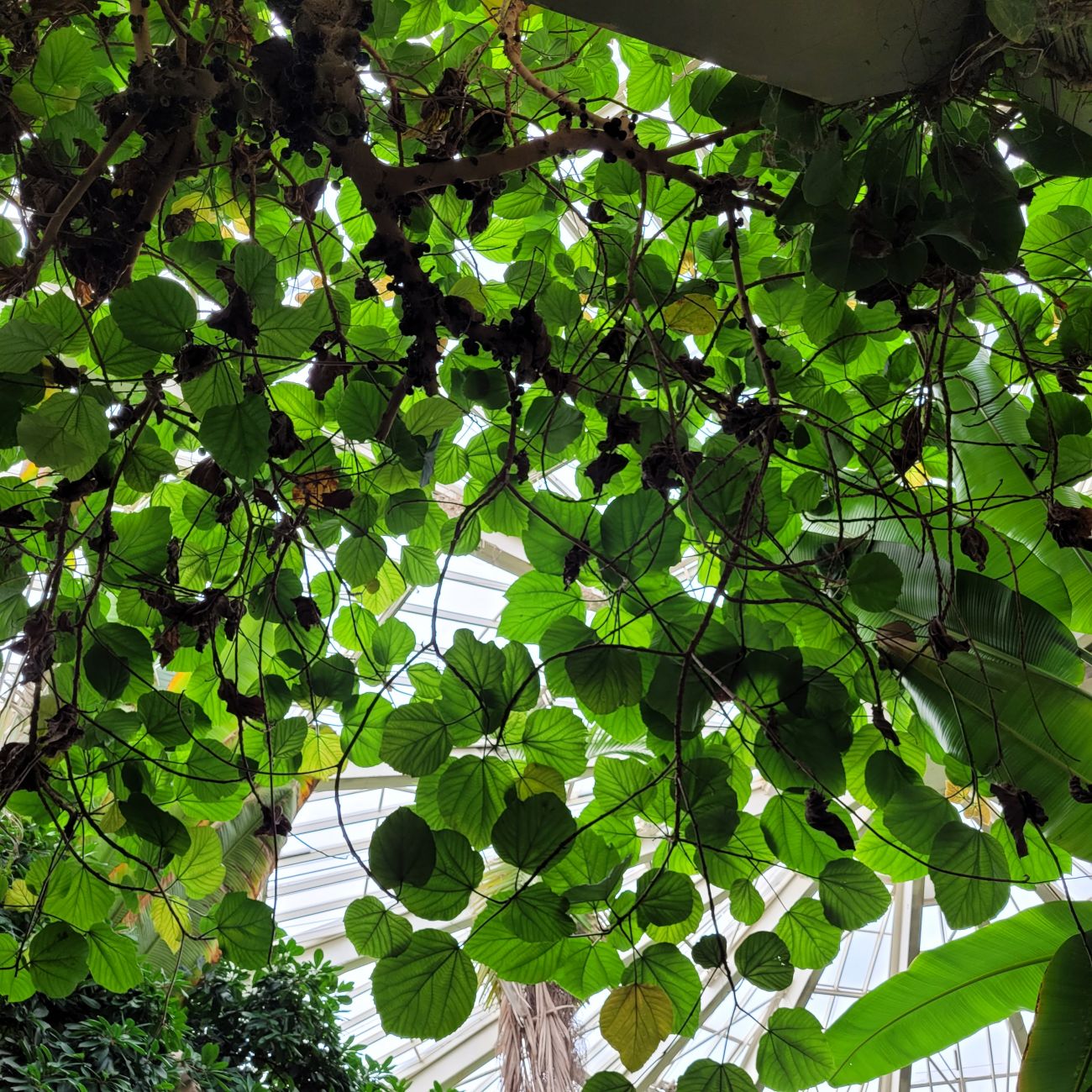
Ficus roxburghii
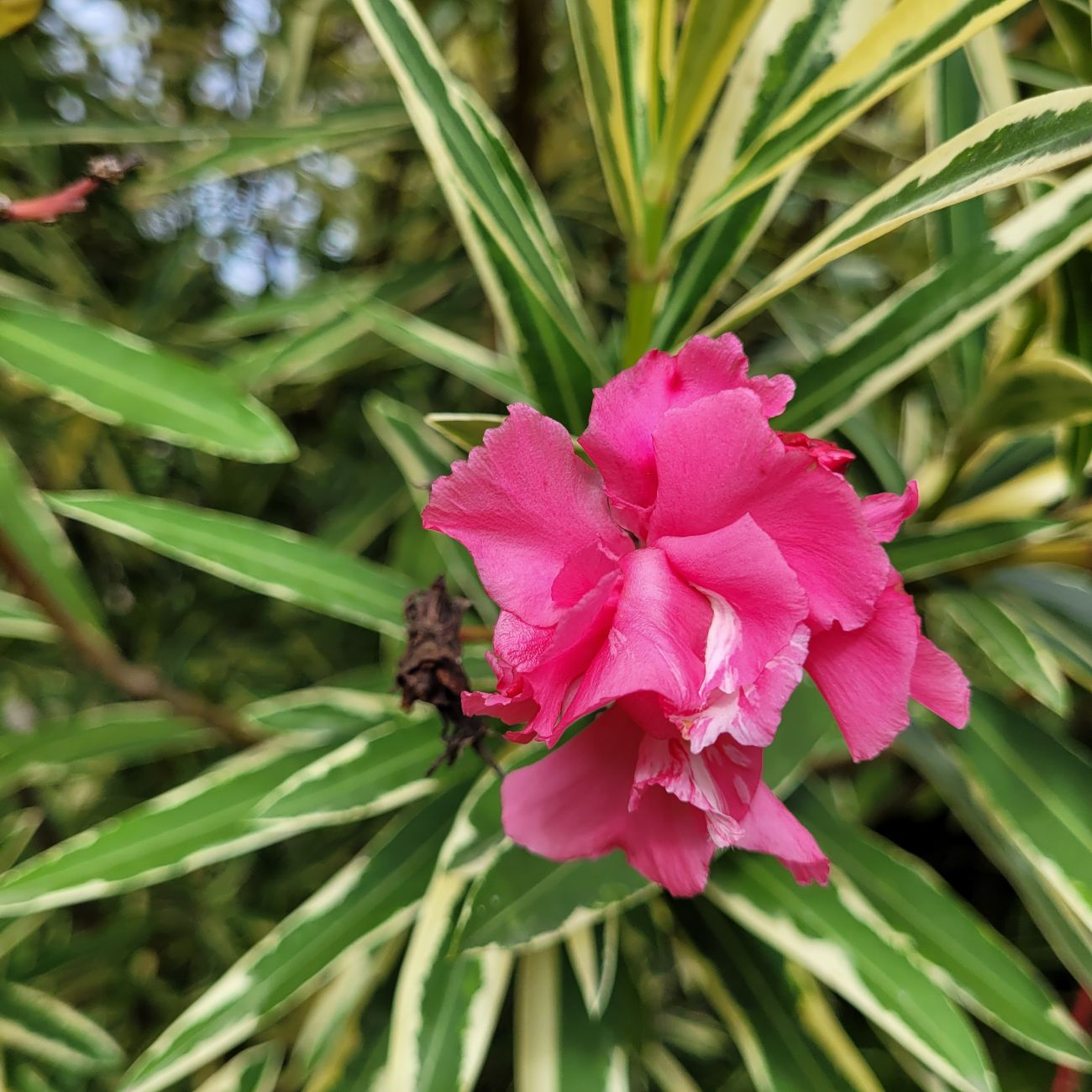
Variegated Nerium oleander
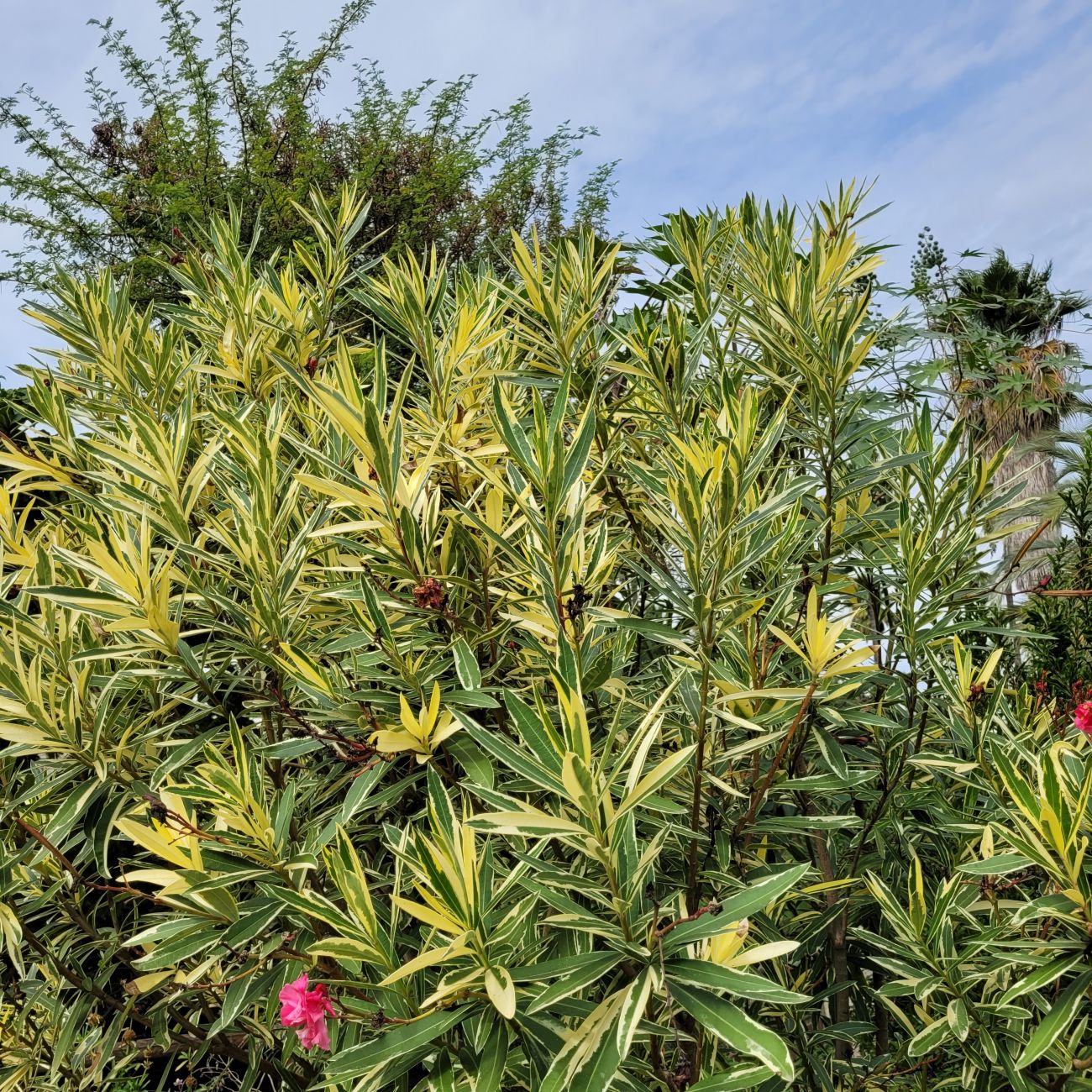
Variegated Nerium oleander
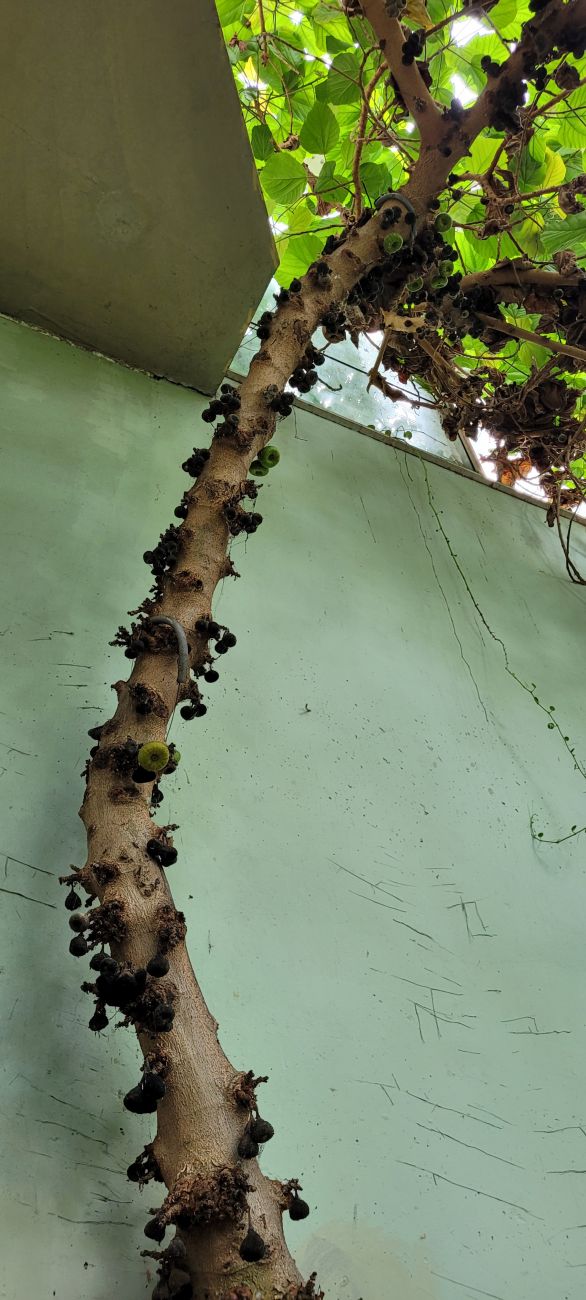
Ficus roxburghii trained up the wall
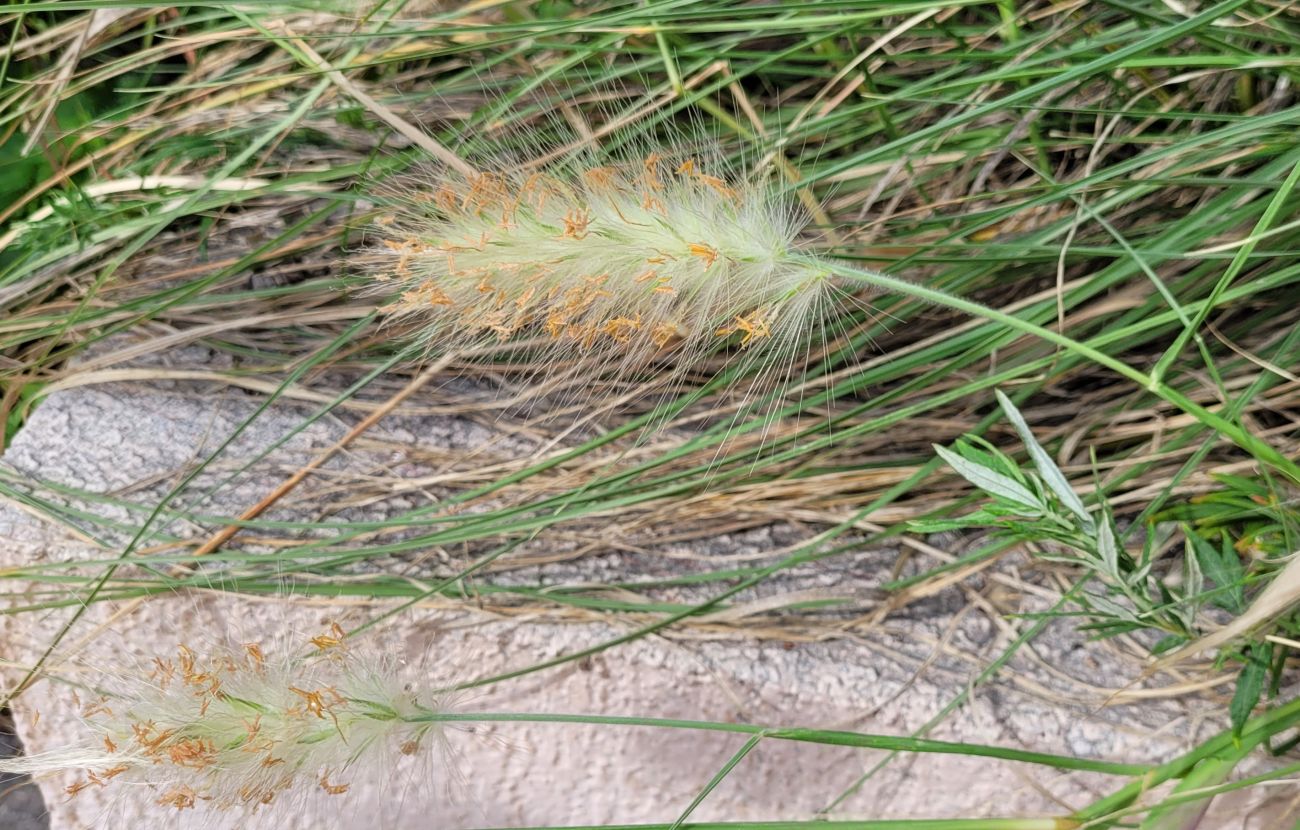
Pennisetum villosum
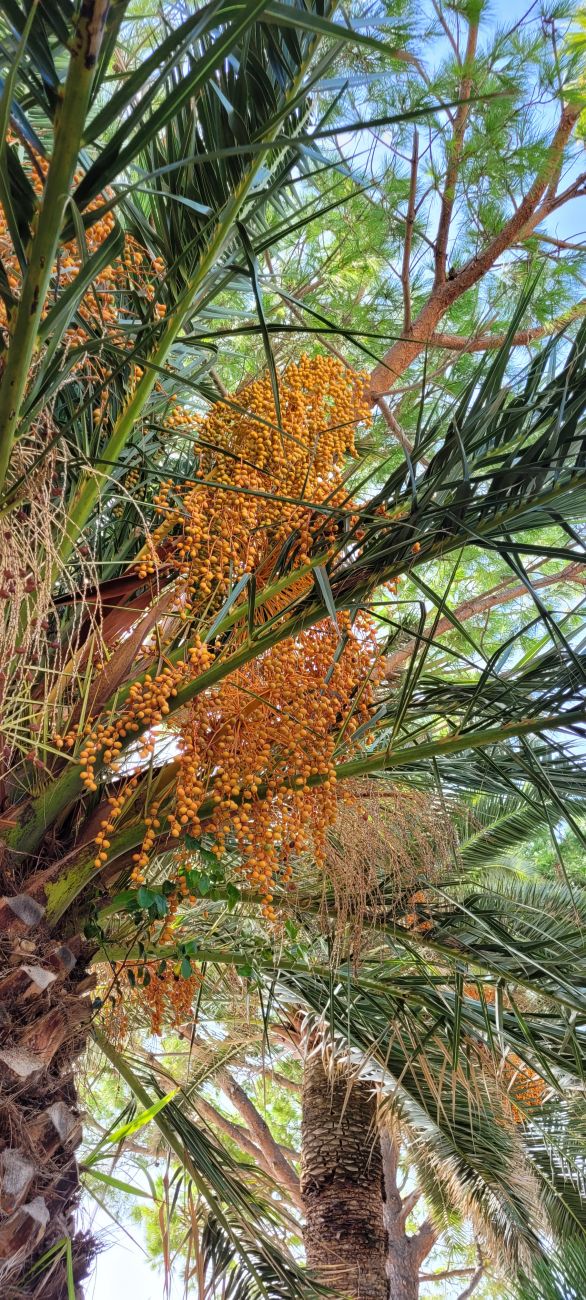
Phoenix canariensis
Soil type – The soil type in Parc Phoenix is a clay and loam mix with organic matter added in.
Irrigation – Non man-made and man-made means – Precipitation, drip irrigation systems, manmade water features, ponds and waterfalls with a ‘spray’ effect and hoses.
Tuesday 17 October
I woke up early and took one last walk around Nice before heading to the airport to catch my flight back to the UK. Stepping off the plane back in the UK to be greeted by the wind and the rain made me wish very quickly that I were back in the Cote d’Azur looking at the incredible plants.
Conclusion
Of all the plants I saw during the trip, they were all growing with similar conditions. Climate change is happening all over the world, making the UK, in particular, have milder winters and warmer summers. Especially in the southwest where the soil is mostly clay and towards the south coast, clay, loam, we should be starting to think about the different plants that are able to adapt to the changing climate. This makes Mediterranean plants the perfect solution. Like with the experiments where non-endemic plants have been introduced and mixed with, or have replaced, the local flora in the Cote d’Azur with exotic plants to creating some of the most important Acclimatisation Gardens of the Mediterranean area, we could introduce or mix Mediterranean plants into the area to ensure that our horticultural importance in the UK.
On my trip I didn’t get to all the gardens that were originally planned as my contact was unreachable until the last day. I plan to complete my trip to these gardens at some point in the near future to further my knowledge.
Acknowledgements
I would like to thank the MPG Bursary Committee for giving me this unique and extraordinary opportunity to explore and learn about the flora of the Mediterranean, which would not have been possible without their help. I would also like to thank the staff at the Centre Botanique Monaco and Villa Val Rahmeh for meeting and sharing their vast knowledge with me. I have learned so much on this trip and my love and understanding for Mediterranean plants has grown and I will count down the days until I can go back.

